|
INDUSTRIAL
&
TERMINAL RAILROADS &
RAIL-MARINE OPERATIONS
High
Line West Side Line Improvement Meatpacking District National Biscuit
Nabisco cold
storage Hells Kitchen Chelsea Village Tribeca upper horse escort
manhattan cowboy Eleventh 11 Avenue Tenth 10 NEW YORK CENTRAL & HUDSON RIVER RAILROAD / NEW YORK CENTRAL RAILROAD 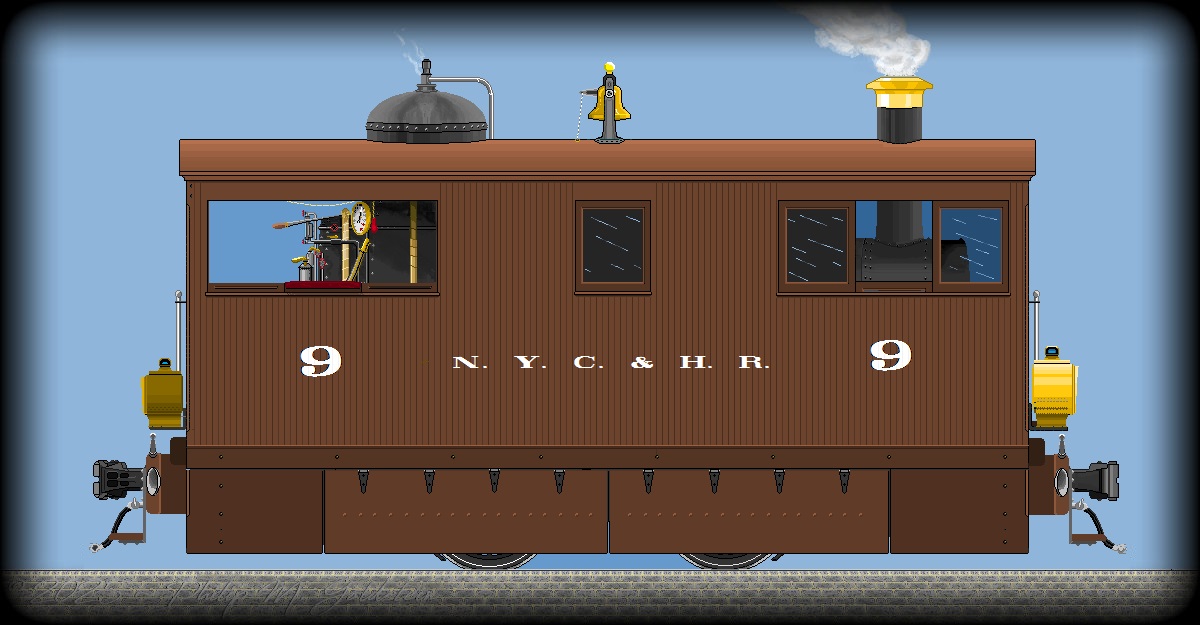 30th Street Branch - New York Terminal District, Hudson Division West Side, Manhattan - Freight Operations West Side Improvement Project High Line
.
|
|||||||||||||||||||
.
|
updated: |
||
|
|
||
| 1936 Q Motor at Inwood photo added | 9/2/2025 | |
| Many new chapters and images | 8/26/2025 | |
| page split off from history page | 8/20/2025 | |
| page added 20 August 2025 | ||
.
.

| Steam Locomotive Operations in Manhattan |
The Kaufman Act of 1923 |
Straight Electric Locomotives for Freight Service |
.Knock-knock, the Diesel-electric Locomotive enters the Room
. |
The A/GE/IR Tri-Power Locomotives
|
NYC&HR RR / NYC
RR Locomotive Rosters for Manhattan Operations Only |
| . | ||
| Photo Gallery |
|
. Before indulging ourselves into the images and technical descriptions of the locomotives, I feel the misunderstood "ban on steam locomotives in Manhattan" must be discussed, and of which I explain in great detail on Page 1 of this website. Restrictions on steam locomotives in Manhattan came in several phases, many years apart. Specifically, until the Kaufman Act, legislation only prohibited the use of steam locomotives in certain areas (below 14th Street on Park Avenue, in Park Avenue Tunnels, which was used strictly for passenger conveyance to and from Grand Central Depot / Terminal. No freight moved through these tunnels. Furthermore, this regulation DID NOT effect outdoor operations or those operations in a freight capacity anywhere else in Manhattan or the rest of the City of New York. That is until the Kaufman Act..
Simply put, there are hundreds if not thousands of images showing steam
locomotives operating in Manhattan right up until 1931 and for all the
Class 1 railroads. Here are but two from 1930, the first really astounding - a heavy Pacific on the streets of Manhattan!
. . |
In a recent discussion in a Facebook group taking place in March 2024, an image of one of the conventional reciprocating piston steam dummy locomotives was misidentified as one of the enclosed gear driven Shays that the New York Central operated in Manhattan. I have found other groups on the web, where this error has proliferated as well.
During the late 19th and early 20th Century era of operations; locomotives that were expected to operate in the streets were equipped with a car body over the entire locomotive; as it was found that horses (the primary power mode for the everyman in those days) were easily spooked by the hissing steam, and movement of rods and linkage. So with a car body covering the locomotive, confusion results to "what's actually under there."This misidentification got me referencing my own page here, and I realized my locomotive data was very sparse and I had not touched this particular webpage in 14 years. And in those 14 years since I last worked on this page, quite a bit more images have surfaced and were known. So, it was time to dig out my builders records and get to the bottom of things and give this page some very needed attention.
Photography was still in its infancy (much less portable
photography), so images of the first locomotives are not common. By the
1890's and 1900's photography was a lot more prevalent, and so we have
visual confirmation that the New York Central and Hudson River Railroad
used 0-4-0T
dummy locomotives for service on the West Side of Manhattan.
The 0-4-0T steam dummies were well suited for this work:
small,
compact and of short wheelbase to negotiate tight curves at street
intersections, and only needed a small reserve of coal and water as it
never ventured
more than a few miles from its servicing facility at West 30th Street.
As freight cars increased in carrying capacity; as well as better
construction material - wood construction gave way to steel frames then
steel bodies. This increase in weight led the railroad to
upgrade to 0-6-0T steam dummies;
which obviously had better tractive effort.
But you will notice in the roster below that some of the 0-6-0T dummies were of the same age as the 0-4-0T's, and also take note of which some of the 0-6-0T's had been rebuilt from conventional tendered 0-6-0's. This was typical for the era - and unlike the rather disposable economy of today. Railroads could and did in fact rebuild a locomotive several times (and other various types of heavy industries that operated large industrial machines). While being of great cost benefit to the railroads, especially for specialized operations; this has the disadvantage of muddling their history. Also, it is worth noting a few of these 0-6-0's began life as Grand Central Depot shunting locomotives for the passenger cars before the previous terminal was electrified in 1906, and then subsequently razed for the current terminal which opened in 1913.
The enactment of the Kaufman Anti-Smoke Legislation in 1925 (to ultimately take effect in 1931); gave impetus to the New York Central Railroad (as well as all the other railroads operating in New York City) to find a method of propulsion for trains that did not emit smoke. In some cases electric was turned to, for rapid transit / passenger service. In others, diesel-electric was chosen for freight service.
Therefore, the American Locomotive / General Electric Tri-Power locomotives were developed for the New York Central. These locomotives could be powered off 660 volt DC third rail from Croton-Harmon to Spuyten Duyvil, under diesel-electric power south of Spuyten Duyvil, and battery power when operating inside of buildings and piers. And these later era of locomotives would continue to work Manhattan after the High Line constructed and completed in 1934.
Yes, a lot of rail enthusiasts to this day; are still amazed and excited to learn that the New York Central Railroad owned and operated Shay type locomotives constructed by Lima Locomotive Works. Shay type locomotives are a type most commonly seen on mountain logging railroads in the Pacific Northwest and other timber and sugar plantation operations. They are well suited for low speed - high torque applications. But in their excitement, they are confusing the enclosed Shays built in 1923, with the other enclosed locomotives used at this location that were built before the Shays.
So
to re-iterate; just because the locomotive was enclosed (or covered), does
not mean
it was one of the Shays. A covered Shay is for all intents and
purposes, a steam dummy; but a conventional reciprocating piston
locomotive that is covered, is not a Shay.
A Shay type denotes the mechanism used to drive the wheels.
Also, in examining the images below, you will clearly see:
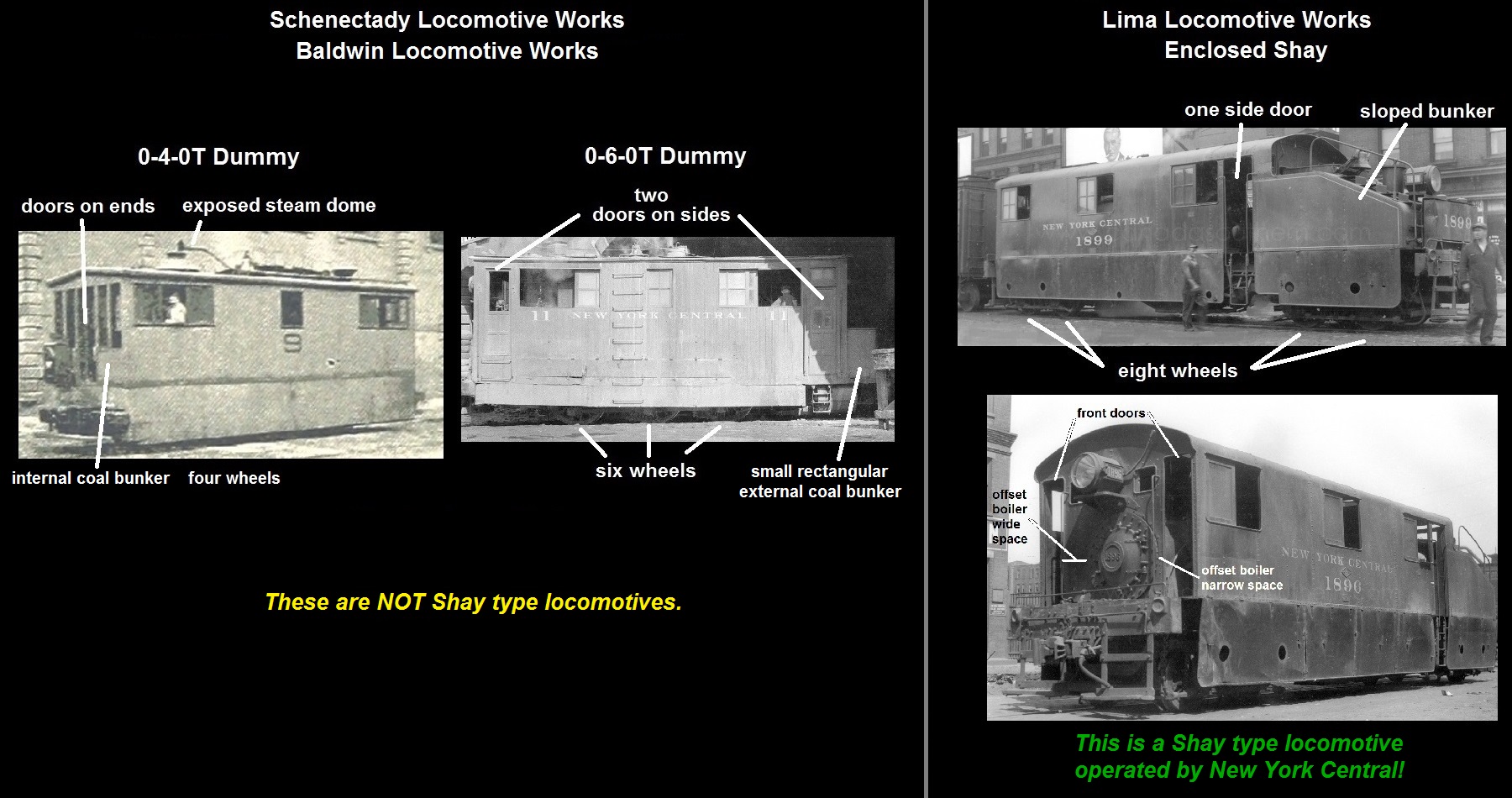
An enclosed locomotive body does not equate to the locomotive being a "Shay" type locomotive.
So, without further ado; here is a roster of locomotives known to have operated by the New York Central & Hudson River and later, by the New York Central Railroad on the streets and the High Line of Manhattan.
Please note: I have omitted from the table conventional uncovered (non steam dummy) locomotives from the roster, even though there are a couple seen working in the yards. I have omitted these as they were not specific for use in Manhattan. They brought the through train south from Albany and other points, perhaps switched the yard, and went back north.
.
.
By 1923, the only reliable internal combustion locomotives were for small industrial and mining locomotives; where gasoline engines powered a mechanical drive. They were not suitable for full size or heavy freight operations, and this is not to say that the locomotive manufacturers had not been dabbling in internal combustion power for locomotives since the turn of the century.
Matter of fact, many diesel powered prototypes and demonstrators had been produced over previous 10 years; but in some way or another, they were not up to the task of heavy freight switching or road use. Whether the engines were not suited to the vibrations incurred of a locomotive, or whether the engine design was too complicated; or whether the electrical controls were smooth enough in the transition from idle to full throttle.
Since there had been no pressing impetus, locomotive companies look their time in releasing a design and then a revision. Steam was still king.
It was not until the Kaufman Act was proposed in 1923, and with it the three year deadline of that Kaufman Law, that forced widespread efforts of several locomotive manufacturers to finally produce successful diesel-electric and diesel-electric-battery designs of locomotives.
The Kaufman Electrification Act of 1923, ratified by the New York State Assembly; mandated that all railroads located in the City of New York City be electrified by January 1, 1926.
The bill was sponsored by recently elected Assemblyman Victor R. Kaufman (R) (hence it being called the Kaufman Act) and signed by Governor Alfred Emanuel Smith (D) on June 2, 1923. News of this act was published in the June 5, 1923 issue of the New York Times. As a result of this act, all railroads (freight, as well as passenger railroads) operating in New York City (to include Manhattan as well as Brooklyn, Queens, the Bronx and Staten Island) would face a significant change pertaining to their operations, with the passage of this bill.
It should be noted, that the Kaufman Act was completely separate from, and now in addition to; the regulation already in place since 1908, prohibiting the use of steam locomotives in tunnels conveying passengers within New York City, specifically the Park Avenue Tunnel lead to and from Grand Central Terminal. As previously discussed in the chapter above; this regulation was enacted by the State of New York, on May 7, 1903; and thus prohibiting the operation of steam locomotives in the Park Avenue Tunnel after June 30, 1908.
With this new 1923 legislation however, the State of New York
attempted to force the railroads to electrify their lines. This new
legislation required that:
"No railroad or part thereof operating within the limits of the city of New York or within the limits of an adjoining city shall on or after January 1, 1926, use any motive power in its operation within these cities except electricity (authors emphasis), to be generated, transmitted and used in said operation in a manner to be approved by the Public Service Commission."
.
As written; the State was now was requiring only electric operation of all trains within the City limits of New York by January 1, 1926 - giving the railroad three short years to comply.
Following this legislation, the Kaufman Act (as this legislation was to be known as) was to ban coal burning steam locomotives from New York City, because of their contribution to severe pollution problems.
The intended response to this law was for the railroads to electrify all rail lines: Passenger or freight, large or small, main line or yard switching. However, electrification on this scale was uneconomical to apply to low traffic areas, freight terminals and small industrial concerns.
Naturally, this legislation did not sit well with many of the railroads in the New York City area, and several railroads (trunk line and independent alike) filed an appeal.
| The
Kaufman Act would, without any doubt; incur serious financial hardships
on many of the small independent contract terminals operating in New
York City. One would only need to calculate the total cost of replacing all eleven of Brooklyn Eastern District Terminal's steam locomotives (those in use in 1925 and all at the same time) with electric locomotives plus having to string trolley wire or catenary to power those electric locomotives. Quite simply, here is where "sticker shock" sets in. The Long Island Rail Road estimated it was going to cost between 25 and 40 million dollars for them to comply with the Kaufman Law. This figure translates to 472 to 756 million in 2009 dollars. Almost half a billion to three quarters of a billion dollars! But the true loser however, is really the small one or two locomotive terminal like Degnon Terminal, which would most likely just "fold up" rather than attempting to electrify.
|
|
|
Taking into consideration that research into gas / diesel locomotive technology had yet to lead to a perfected design, which is why the Kaufman Act specified "electric". At that time, other than steam locomotive power, it appeared there was no real alternative other than electric. Steam power was to be abolished and replaced with electric locomotives, period. The Kaufman Act was very specific in its reference to electric locomotives. However progressive the Kaufman Act may have been in its initial form, it did not take into account some very serious obstacles, the least of which were to provide power to the stipulated electrically powered locomotives in Manhattan. To use electric powered locomotives, power must be generated remotely and transmitted either an overhead trolley wire / catenary, or a ground level third rail be used. The City of New York already had ordinances on their books since 1892 prohibiting the use of overhead trolley wire (which is why streetcars / trolleys in Manhattan used underground conduit, battery powered or pulled by cable). The reasons for this legislation are understood to be, that the bright bluish-white arc flashes and sparks incurred by use of a trolley wire were a nuisance to residents, especially those with money living in the affluent areas. |
|
The other reason, was (more importantly) for safety: telegraph and telephone lines that might fall on the trolley line, were likely to get energized by the high voltage, and injuring or killing people.
Likewise, a ground level third rail (like those used on the subway or commuter operations), would have instituted an immediate electrocution hazard to pedestrians, animals, etc. Since the subway tunnels and the Park Avenue Tunnel were enclosed and off limits to the public, the electrocution hazard was mitigated in those applications.
As the New York Central's West Side Freight Operations in Manhattan utilized surface avenues and streets south of West 72nd Street, a third rail power supply was not a feasible option for power.
Opposition to the Kaufman Law
Multiple railroads operating freight terminals in the City of New York vehemently objected to the Kaufman Act. Most were operators of small off-line rail-marine terminals throughout the boroughs and where the cost of electrifying would have put them out of business."The Diesel electric locomotive... has none of the objectionable features of the steam locomotive; it is substantially noiseless and its movement are virtually the same as those of the electric locomotive of the same capacity. It has one other feature... which has an advantage over the overhead system of contact or the third rail. In the case of the latter, there are frequent momentary discontinuances which draw arcs causing vivid flashes. These are a source of annoyance and would be objectionable to those living along Riverside Drive. The results where the contact shoe jumps from one conductor to another and such intervals would be frequent in the third rail system."
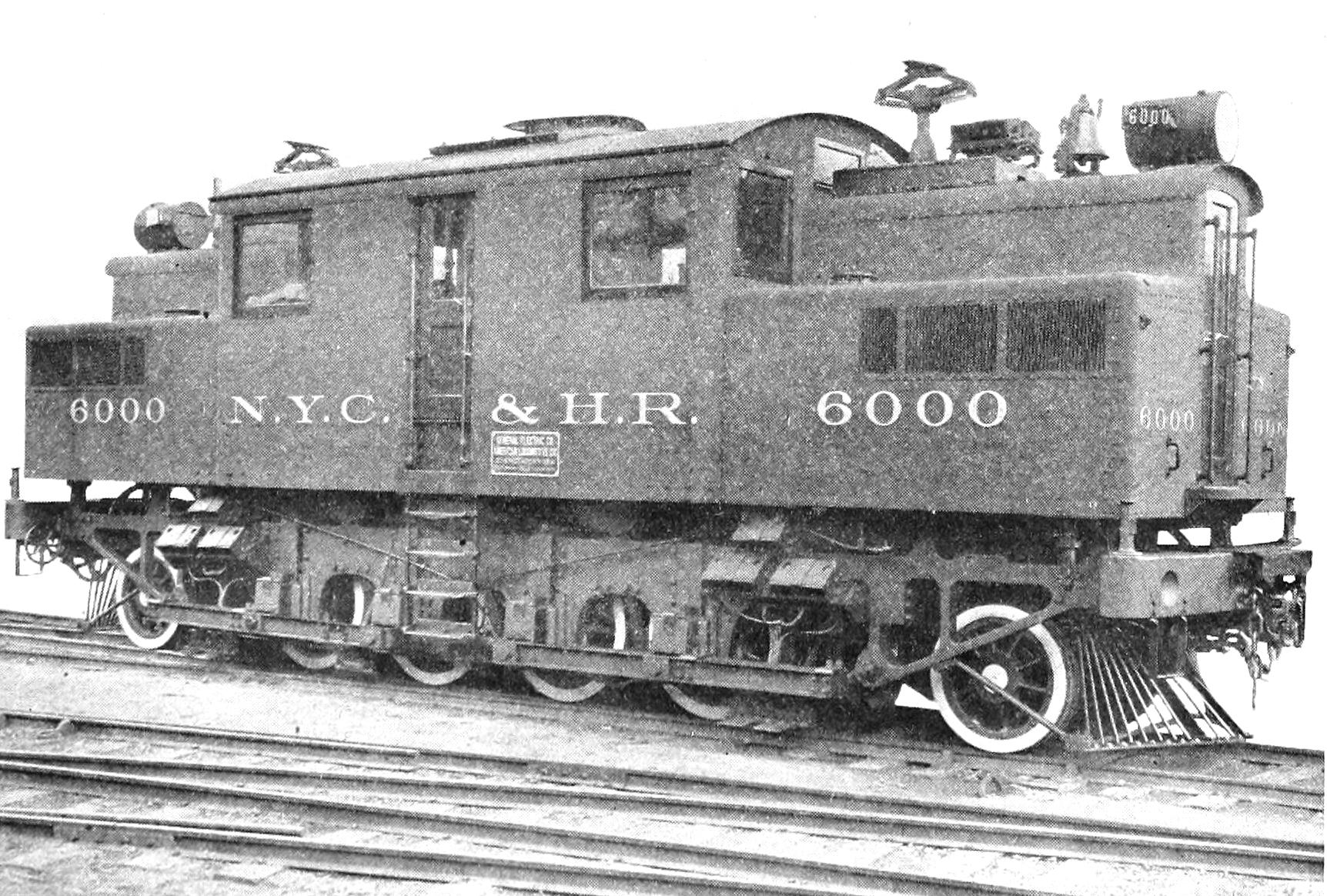 NYC&HR #6000 [as built: rigid 1-D-1]
|
In regard to locomotives, the result was S Class or "S-Motor" locomotive, with a rigid 1-D-1 wheel
arrangement which was completed on April 29, 1905. This locomotive was tested and found to outperform several types of steam locomotives in service at that time on the passenger routes in New York City. When first built, the Class L or "6000 series" (as the first locomotive was numbered 6000) was powerful for their time and nimble and well suited for tight schedule passenger service. During one test it reached the speed of 80 miles an hour in under two minutes with a 434 ton eleven car train. These locomotives were designed predominately with passenger service in mind. |
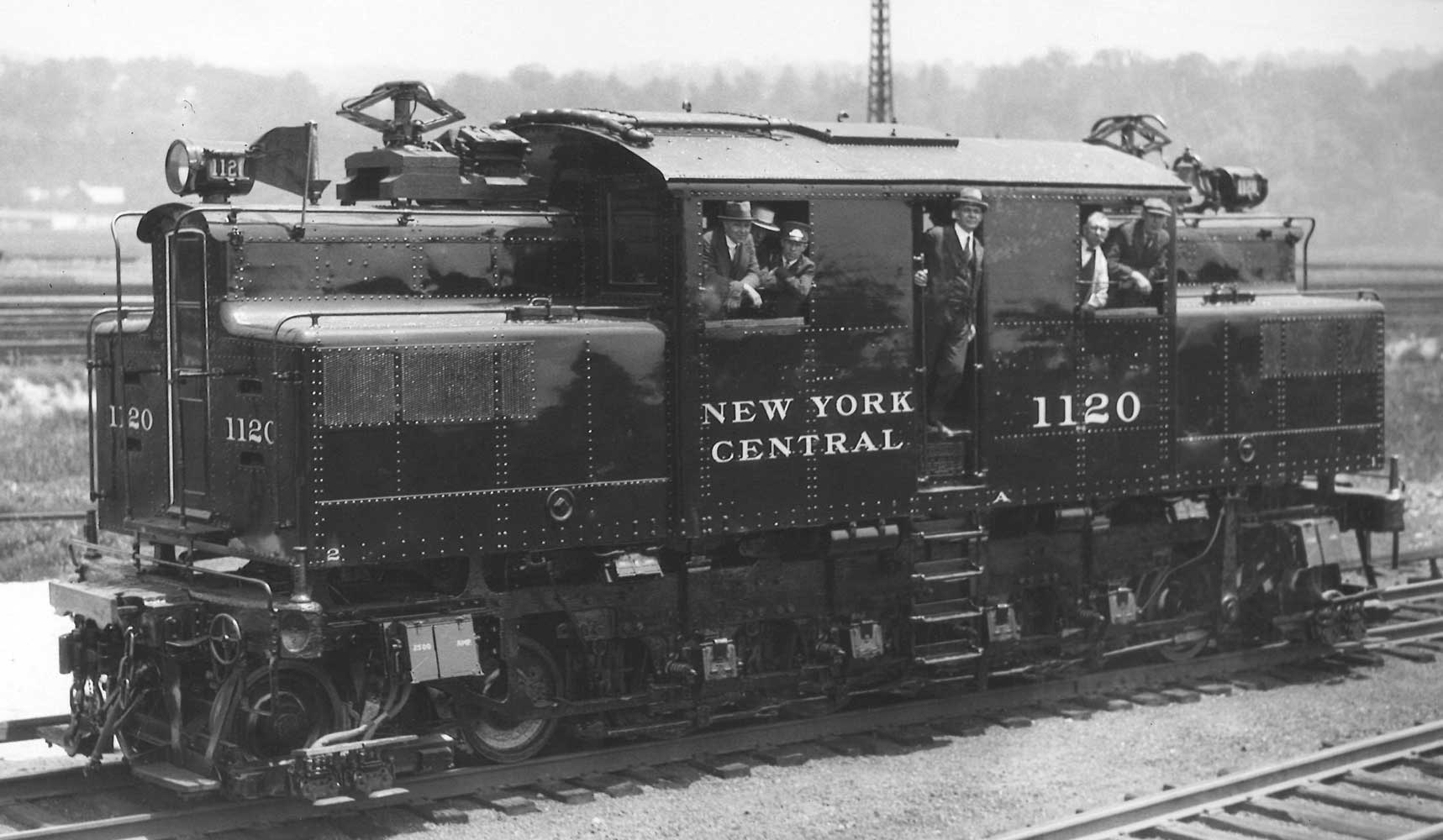 NYC #1120 [as modified: flexible 2-D-2]
|
| So, New
York Central ordered up what is now known as the T Class or "T-Motors".
Built for
dual service, they were assigned to heavy passenger as well freight
service, and hauled trains
from Croton to Port Morris Yard in the Bronx. These locomotives were built with B-B+B-B wheel arrangement, meaning two pairs of 2 axle trucks joined with a bolster span and then those pairs articulated and all eight axles were powered. There were five variants over 36 units built from inception in 1913 to the final order of 1926: T-1a: (1), T-1b (9), T-2a (6), T-2b (10), T-3a (10). These T Motors could be found on the head end of any passenger trains departing Grand Central Terminal, whether it be commuter trains or the famed 20th Century Limited. The S Motors were usually relegated to local service, but once in a while they too could be found heading the 20th Century Limited on occasion. It should be noted; any of the northbound trains had their electric power swapped for steam locomotives at Croton for the reminder of the journey north and west; likewise New York bound trains had the steam locomotives removed and replaced with electric locomotives for the journey from Croton to Grand Central. |
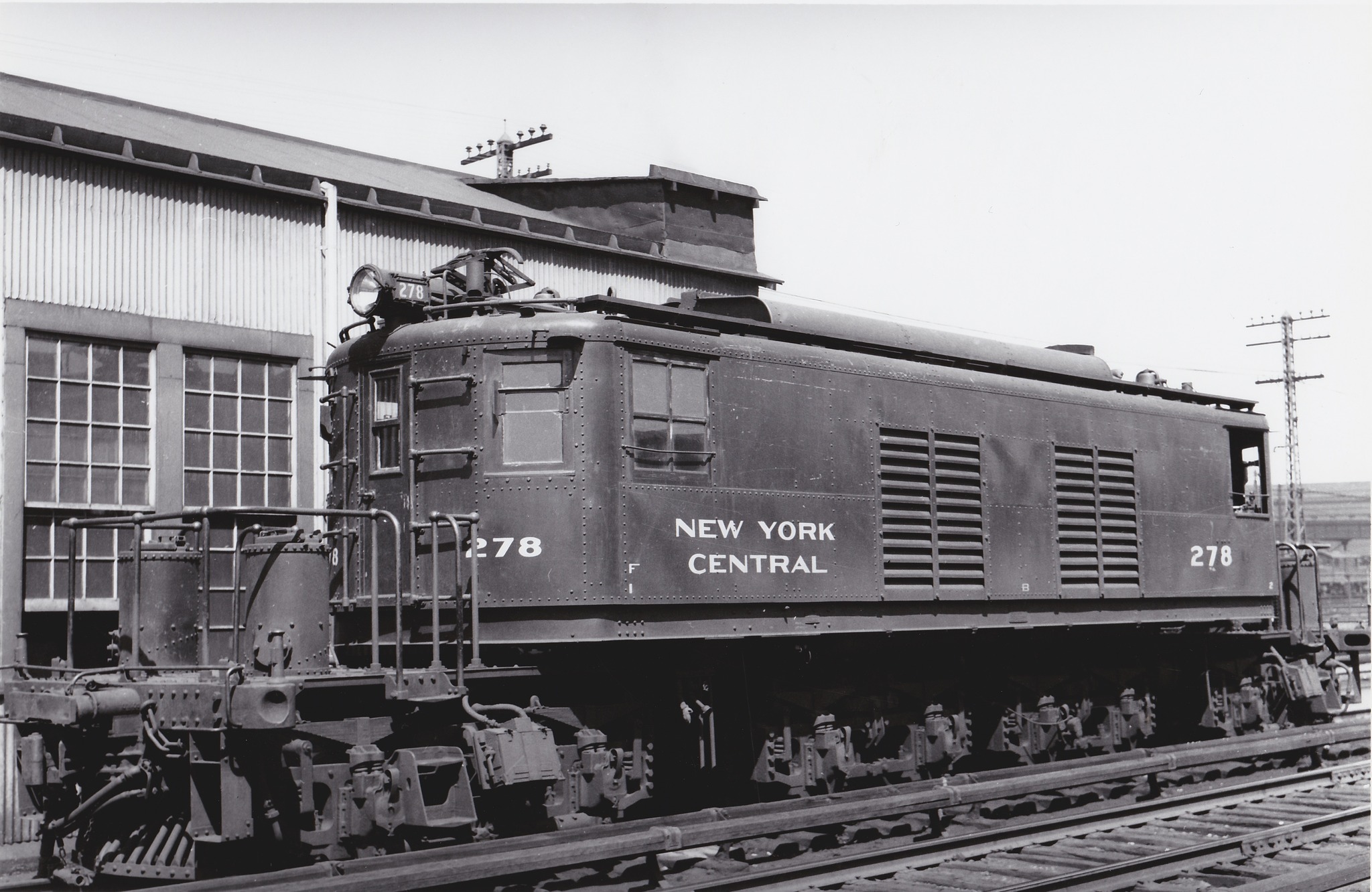 |
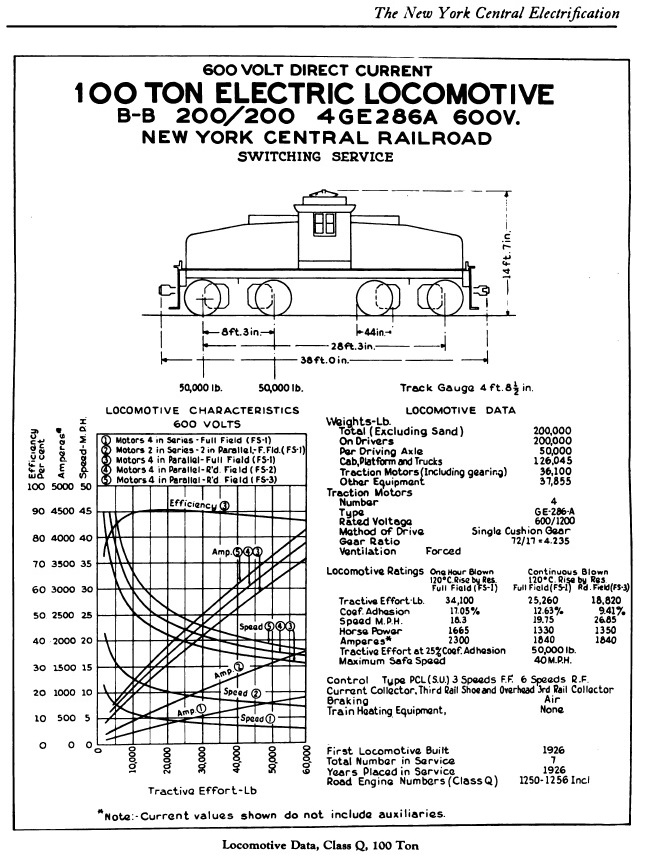 |
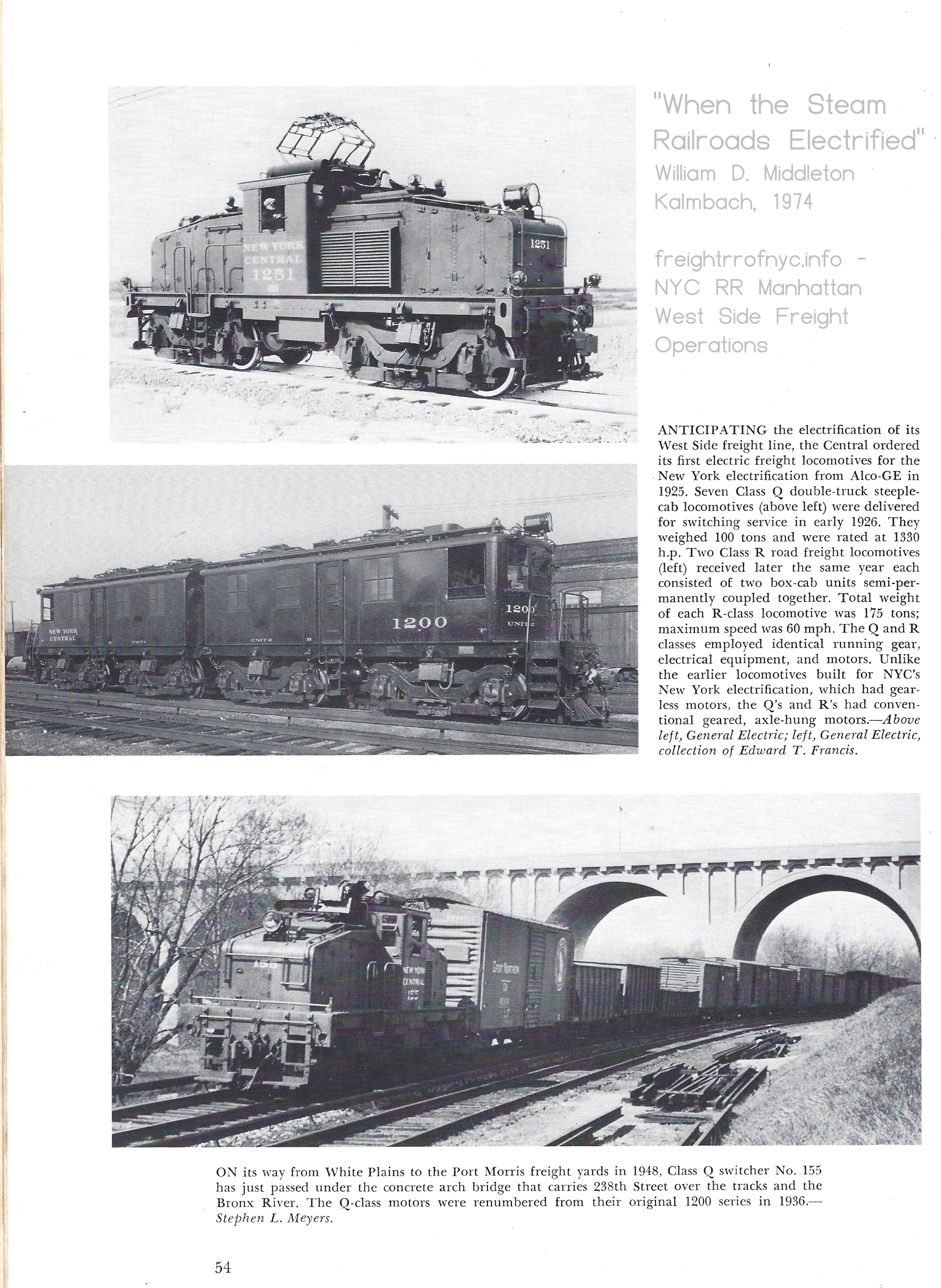 "When Steam Railroads Electrified" William D. Middleton (Kalmbach, 1974) |
| The first two examples of the R class had a B-B+B-B wheel arrangement, (all four axles powered) and these
locomotives were semi-permanently coupled (drawbar) into pairs. These locomotives were suited for heavy freight, yet only two were built in September 1926. Theoretically, they can be considered somewhat of a prototype. ALCo construction numbers: 66422 through 66423, GE construction numbers 9801 through 9802; GE class: B-B-351/351-8GE286A GE model: LS4444-E-100 New York Central road numbers 1200A / 1200B and 1201A / 1201B. Rated at a maximum of 3320 hp, tractive effort 55,800 lbs. and weighing in at 175 tons for each pair. Gear ration was 69:20 allowing for a maximum speed of 60 miles an hour. 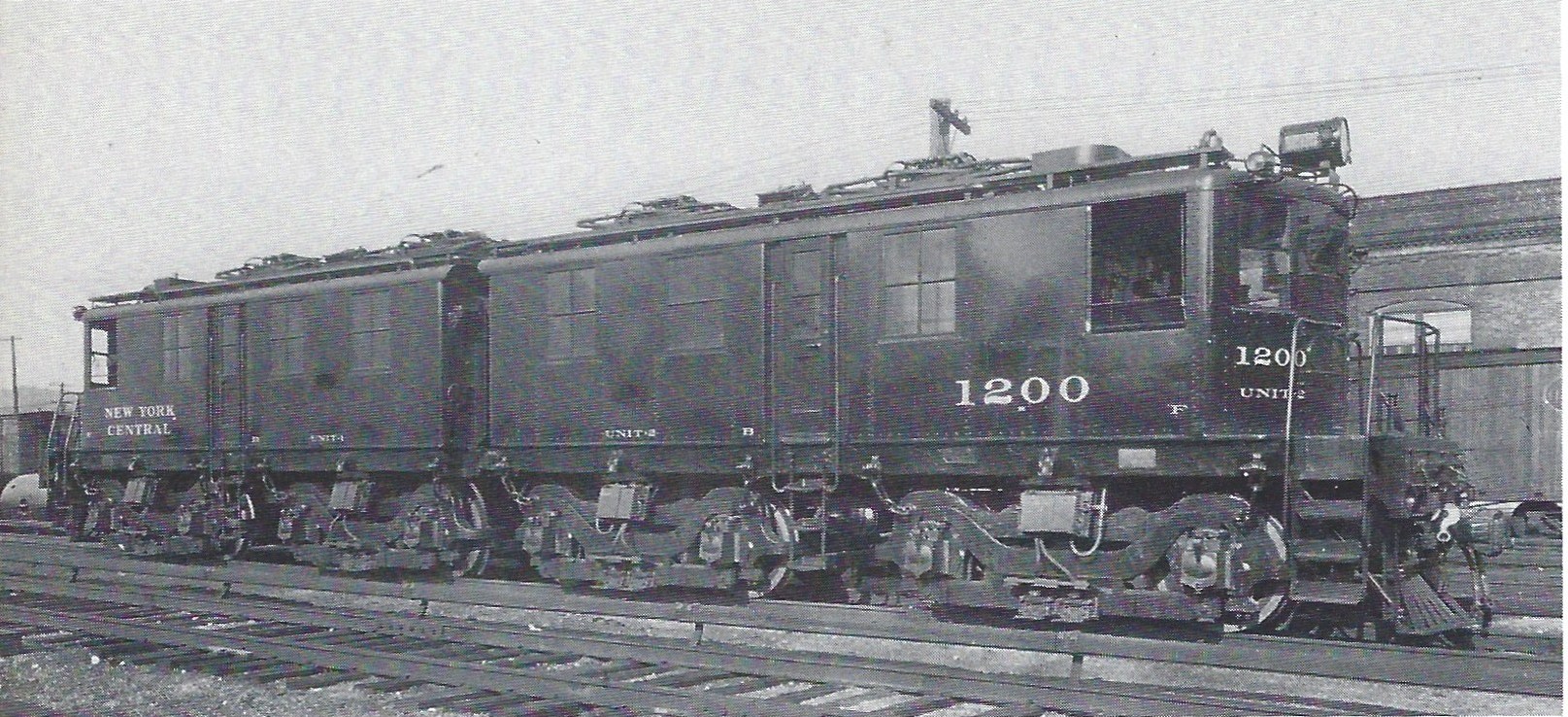 New York Central
#1200 - unknown date
ALCo / GE Electric R Class Manhattan, NY General Electric photo Edward T. Francis collection |
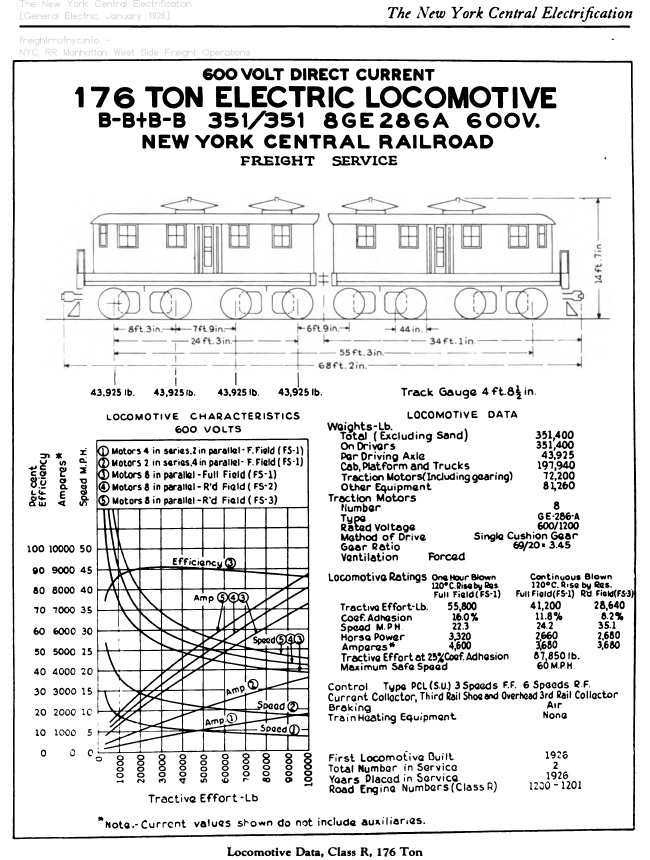 |
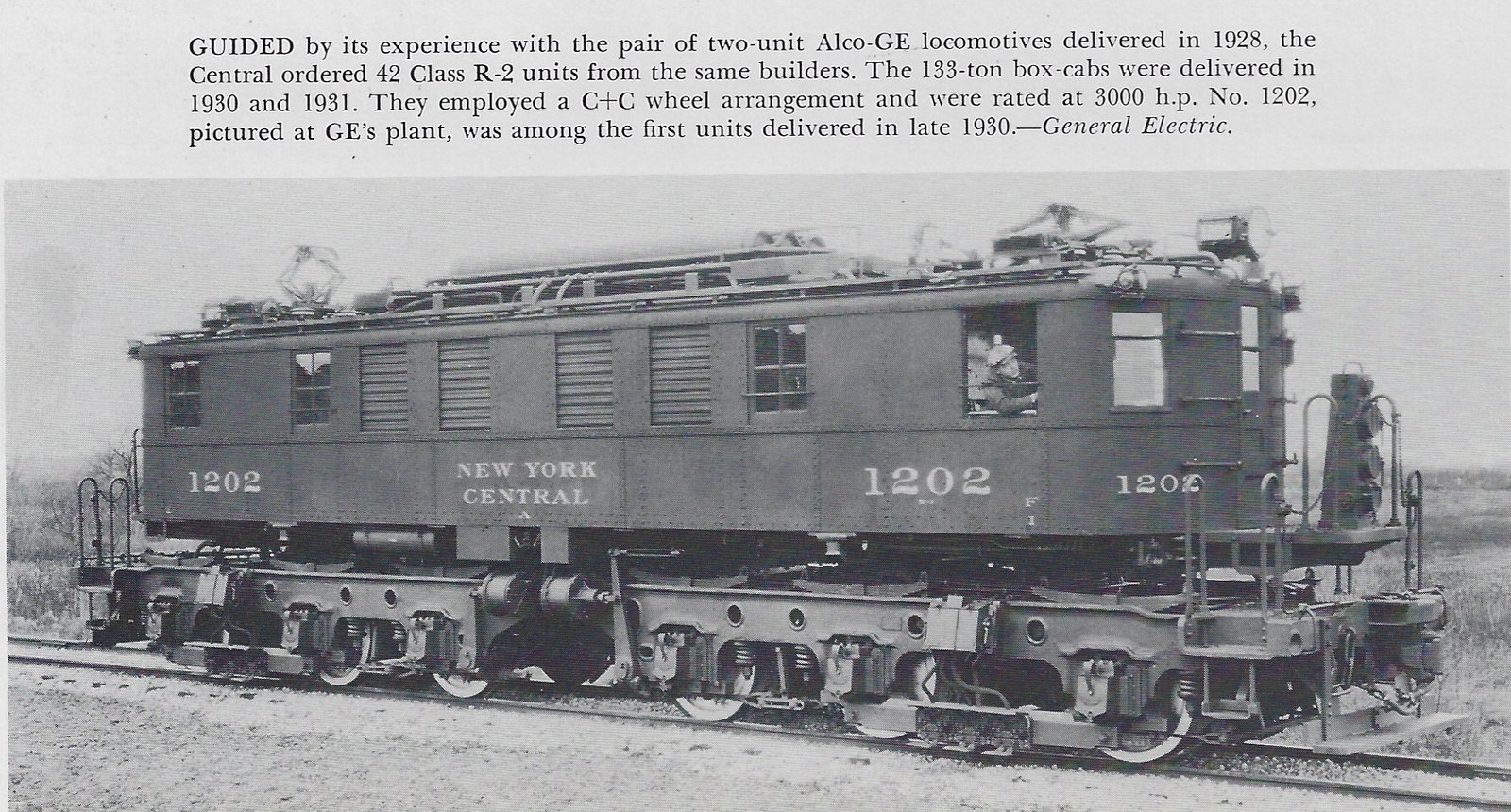
This is also not to say Baldwin Locomotive Works was ignoring the situation either. They too were developing a diesel-electric locomotive, however their design was more conducive to heavy road service, and it wasn't quite ready for production either.
Therefore, the smaller Ingersoll-Rand was the logical choice for switching operations of the various offline contract terminals in New York City.
So, in 1924, a prototype built by General Electric and Ingersoll Rand, the model X3-1 locomotive, better known by its construction number: #8835.
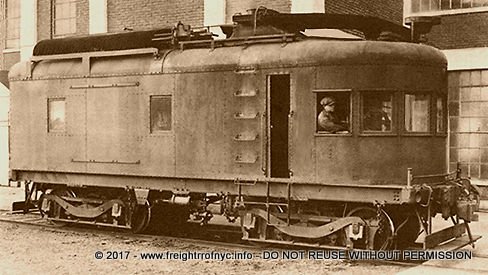 "A" (rounded) end |
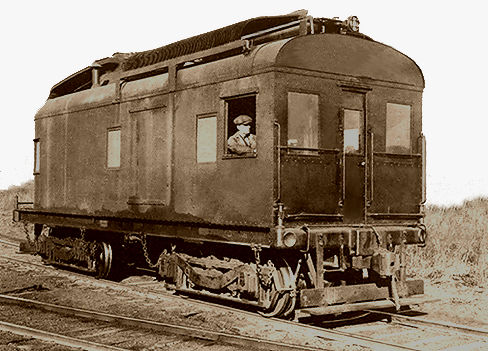 "B" (flat) end |
|
Ingersoll-Rand / General Electric Demonstrator #8835 - December 17, 1923 . . |
|
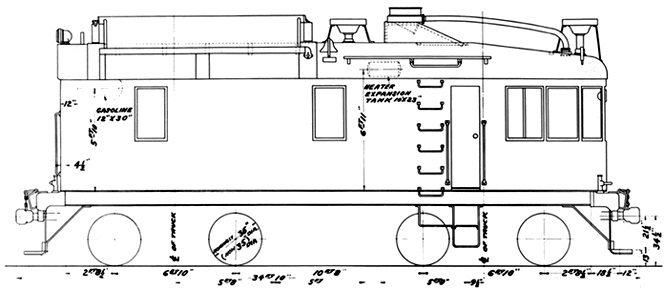 |
|
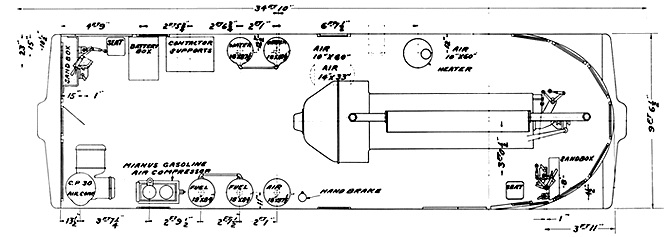 |
|
This locomotive was fitted with an in-line six
cylinder (10" x 12" cylinders) diesel engine constructed by
Ingersoll-Rand utilizing the Price-Rathbun design and solid injectors.
This engine in turn poweed an electrical generator
designed by General Electric. That in turn supplied electricity to
traction motors with voltage and current being regulated using controls
designed a few years prior by Dr. Hermann Lemp of General Electric.
The carbody was a left over, laying around at General Electric's Erie, PA facility and was unique as it had a rounded front end but a square rear end, giving it an unusual appearance.
When completed, #8835 would be "unveiled" on February
28, 1924 to
the representatives of the following railroads showing interest in a
diesel-electric switching locomotive: Baltimore & Ohio,
Pennsylvania, Boston & Maine, New York Central,
Reading &
Lehigh Valley. While
these men were impressed, they expectedly remained unconvinced of the design which
had not seen day to day service.
Ironically, #8835 would come to spend quite a bit of time: 2½ months (the most of any of the testing railroads); operating on the West Side of Manhattan along Tenth and Eleventh Avenues for the New York Central Railroad:
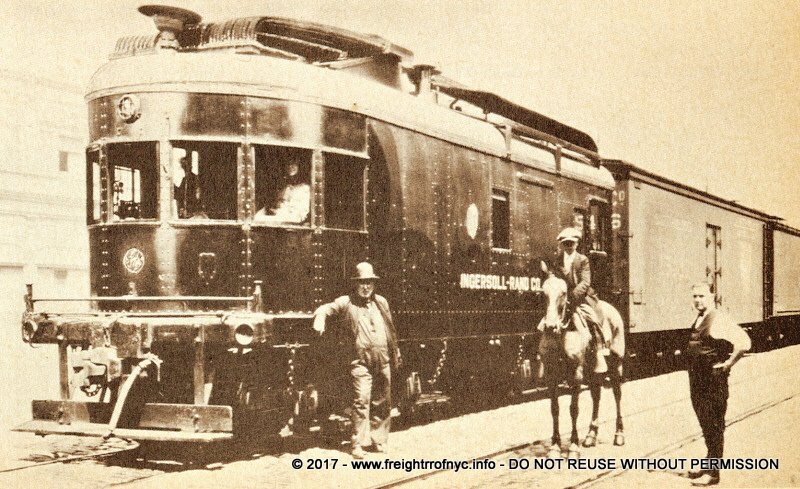
Ingersoll-Rand / General Electric
Demonstrator #8835 - sometime between
June 9 and August 23, 1924
Tenth Avenue, Manhattan, NY
from Diesel Spotters Guide, Jerry Pinkepank / Kalmbach Publishing
.
According to Diesel Spotters Guide, by Jerry Pinkepank [Kalmbach Publishing]; the locomotive was first broken in at the Ingersoll-Rand plant at Phillipsburg, NJ. The breakdown of hours of service per railroad are as follows.| railroad conducting test | hours of service | dates of service | remarks |
| New York Central | 833 | 6/9/1924 8/23/1924 |
Placed
in yard switching service at New York City West Side Yards on July 19th
for a daily recording of performance data. In one test, this unit was
operated 24 hours per day (almost continuously), handling 3 shifts
daily from 7/24 to 8/7. Inspection of the locomotive could only occur
during crew changes. Three notable accomplishments took place during this trial phase: On August 14, 1924; #8835 started and pulled a train of 93 cars on level track for 36 minutes. This is not a bad accomplishment considering you only had 300 horsepower to work with #8835 also "partook" of a tug of war with a 60 ton 2 truck Shay type locomotive of New York Central's; in which it won that battle due to smoother torque of the electric drive and greater coefficient of friction (and a little overzealousness on the part of the Shay's engineer, who got the Shay's wheel's slipping). Needless to say, the "Central's" men were very impressed. Note: The Ingersoll-Rand record does not indicate what these loads consisted of or total tonnage pulled. |
| Baltimore & Ohio | 81 | 8/25/1924 9/4/1924 |
A local freight service test was conducted on 8/29 to record performance data. |
| Central
Railroad of New Jersey: |
35 | 9/5/1924 9/9/1924 |
A light yard drilling test was conducted during this period to record performance data. |
| Ingersoll-Rand | 9/12/1924 | Returned to
Ingersoll-Rand for a complete inspection. Measurements were taken of
various parts and compared with the first full inspection record taken on February 12, 1924. No deficiencies noted, no parts needed replacing. Wear was so insignificant that it doesn't bear mentioning. After the wrist pin, crank pin, and main bearings were set up to standard clearances, the engine was closed exactly as it was taken apart and returned to service. 3 |
|
| New York, New Haven & Hartford | 271 | 9/22/1924 11/4/1924 |
Yard switching service tests were conducted during this period to record performance data. |
| Union Freight | 40 | 11/6/1924 11/8/1924 |
Tested in the Boston, MA area. |
| Boston & Maine | 132 | 11/10/1924 11/20/1924 |
Various testing operations were conducted by this railroad. |
| Long Island: | 362.5 | 11/28/1924 2/16/1925 |
Yard
switching service tests were conducted 12/7/24 to record performance
data. Second period of demonstration trials was begun in which it is reported that an additional 234 hours of testing was concluded on 2/16/25. |
| Bethlehem Steel | 9 | After LIRR - Tested for 9 hours on the Philadelphia, Bethlehem & New England RR. | |
| passenger service test | 11 | 2/27/1925 2/28/1925 |
Two
passenger coaches were pulled between Jersey City, NJ and Harrisburg, PA (approximately 175 miles) in a little over 11 hours to record performance data. |
|
Reading |
207 | 2/27/1925(?) 3/17/1925 | Received at
the end of February 1925 and beginning on 3/4 participated in yard
switching service tests to record performance. |
| Delaware, Lackawanna & Western | 120 | 3/23/1925 3/28/1925 |
Yard switching service tests were conducted to record performance. |
| Hoboken Manufacturers | 26 | 3/31/1925 4/2/1925 |
Various testing operations were conducted by this railroad. |
| New Jersey
Zinc (Palmerton, PA) |
79 | Tested on the Chestnut Ridge Railway. | |
| Alan Wood
Iron & Steel (Conshohocken, PA) |
32 | 7/9/1925 7/11/1925 |
Steel plant
yard service tests were conducted to record performance data in
conjunction with the Upper Merion & Plymouth RR. |
In my ongoing research into New York Central locomotives used on the West Side Yards, I encountered this little critter. There unfortunately is not a hell of a whole lot about it on the web or in published resources, but a series of images that exist in the New York Central System Historical Society digital photo archives, led to my discovery of its existence.
There is no mention of it in "Dawn of the Diesel Age" (Kirkland); no mention in "Centennial Treasure of General Electric Locomotives" (Delta); or any mention in "Interurban Electric Locomotives - General Electric" (Strapac), or in General Electrics' "The New York Central Electrification". In short - nothing... These are my usual "go-to" library for small industrial locomotives from General Electric and they have never let me down.
However, there is an entry in the General Electric builders records. Extrapolating from that information, it appears this locomotive began life as an 40 ton oil-electric steeplecab, c/n 8754, built for Bethlehem Steel in June 1923:
GE model: LS404-OE-80 = 4 wheels, zero driving wheels, 4 wheels - Oil Electric - 80,000 pounds
GE class: B-B-80/80-4HM830 = B-B wheel arrangement, 80,000 pounds on front truck / 80,000 pounds on rear truck - 4 HM (Hoist Mining) 830 traction motors
In this entry is also has the notation 195v, meaning 195
volts. It is unknown if this means trolley wire or third rail pick up,
or the voltage of the traction motors.
At some point around 1930, it was returned to General Electric and rebuilt with a Buda 4 cylinder 250 horsepower diesel engine installed, with a new weight of 45 tons, and redesignated:
GE model: LS404-D-90 = 4 wheels, zero driving wheels, 4 wheels - Diesel - 90,000 pounds
From this rebuild in 1930, it does not appear to have done anything (other than a shop switcher?) until it went to New York Central most likely in 1933, as the dates on the photos below suggest, as well as show a rather clean and spiffy paint job - it couldn't have been in service long if at all) as their #1505, NYC Class DES-a (Diesel Electric Switcher - a). It was re-numbered New York Central #505 in 1934(?).
At some point it was sold to Eastman Kodak of Rochester, NY, their #5 in December 1944.
Without a doubt, this is a nifty little discovery! But why isn't more known or at least documented about this locomotive, seeing how so many images of it exist in the Manhattan Yards, under two different road numbers: as 1505 and renumbered in 1934 to #505. There are even images taken by George Votava, a noted railfan of the era. So obviously it had some attention from at least one rail enthusiast.
How this little guy slipped through the cracks of history, we'll probably never know. But we aware of its existence now, so he'll probably garner get a little more attention and conversation now.
It should be noted that its tenure at New York Central, appears to have occurred after the DES-2 and DES-3's in the following chapter were built and delivered..
|
|
|
| . | |
|
|
|
| . | |
|
|
|
| . | |
|
|
|
| . | |
|
|
|
| . | |
|
|
|
| . | |
|
|
|
All of
the following locomotives were of "Tri-Power" configuration, meaning
propulsion was of three methods: diesel-electric, storage battery and
"straight electric" 660 volt DC third rail pick up.
As
it turns out, there is a very in-depth chapter regarding these
locomotives in "Dawn of the Diesel Age",
pages 127-132 by John F. Kirkland, (Interurban Press - 1983).
.
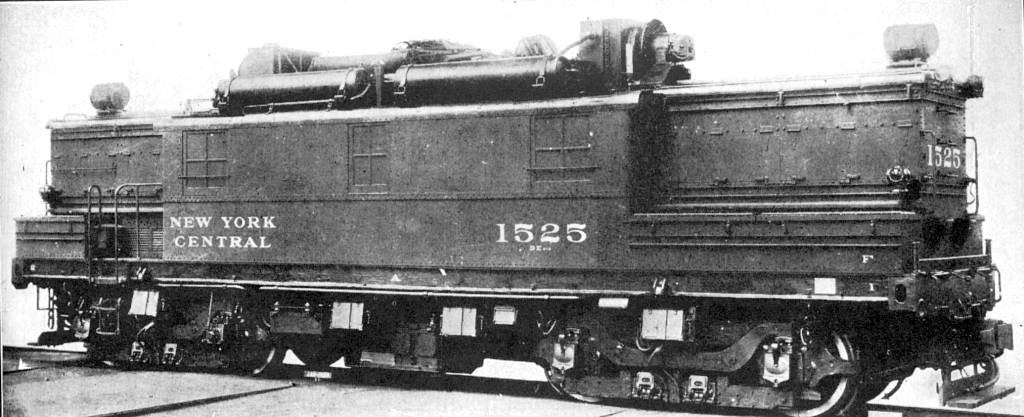 Prototype Tri-Power: NYC #1525 added 05 April 2024 . |
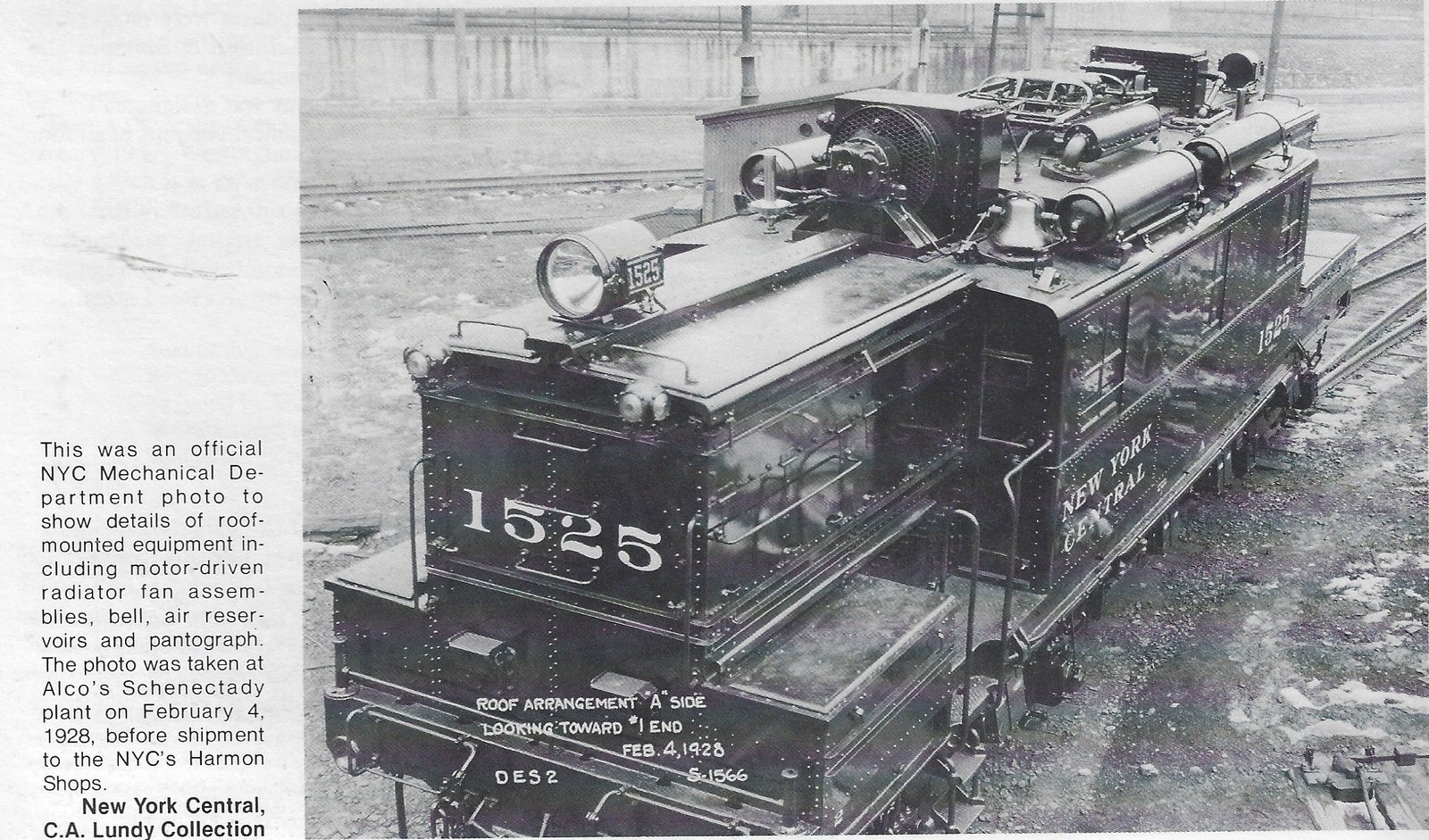
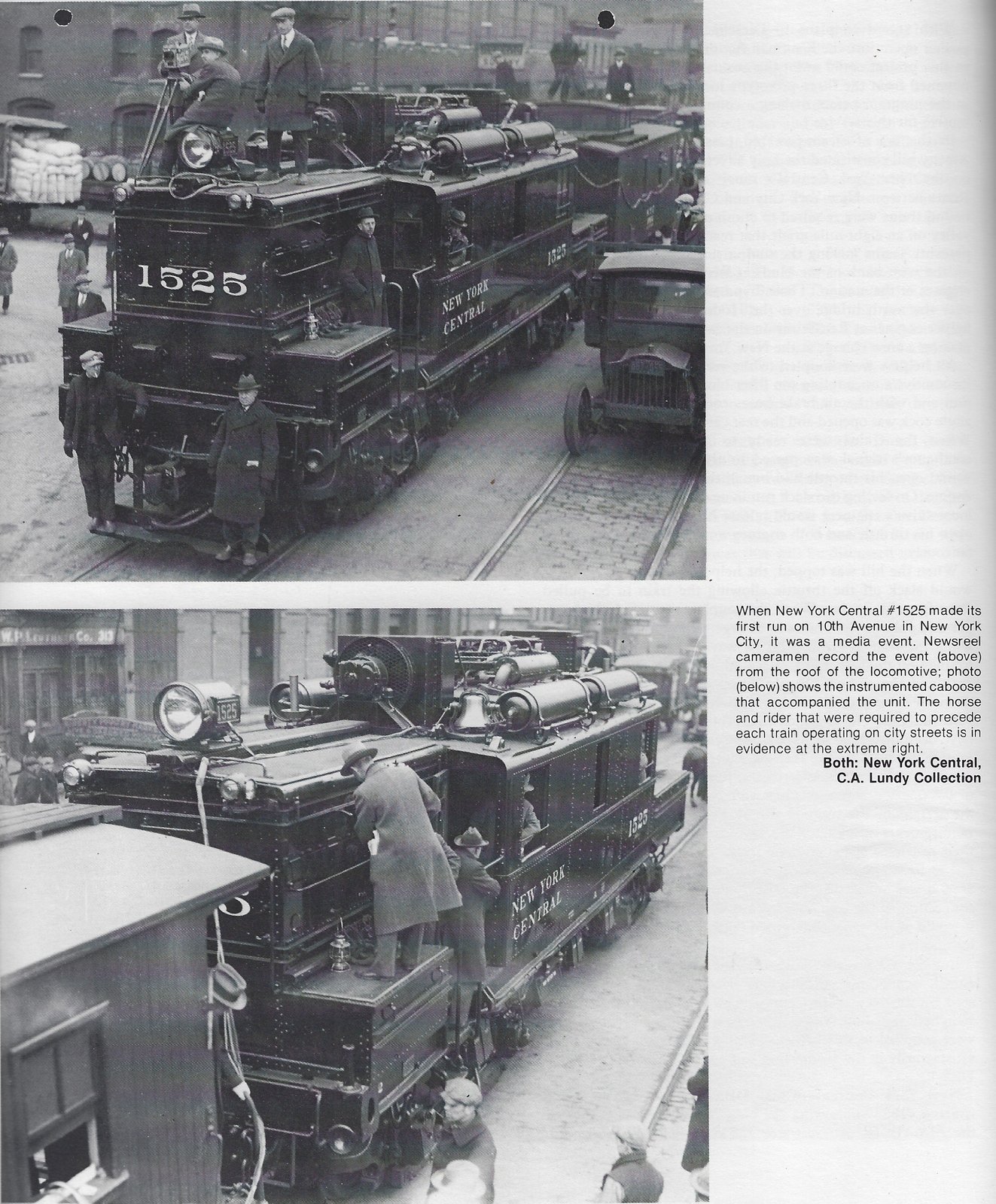 |
 |
| New York Central photo - Manhattan, NY - ca. 1928 C. A. Lundy collection Dawn of the Diesel Age, p.130 John F. Kirkland [Interurban Press, 1983] Where is this film footage now!?!?! |
The Electrification of the New York Central by General Electric, January 1929 |
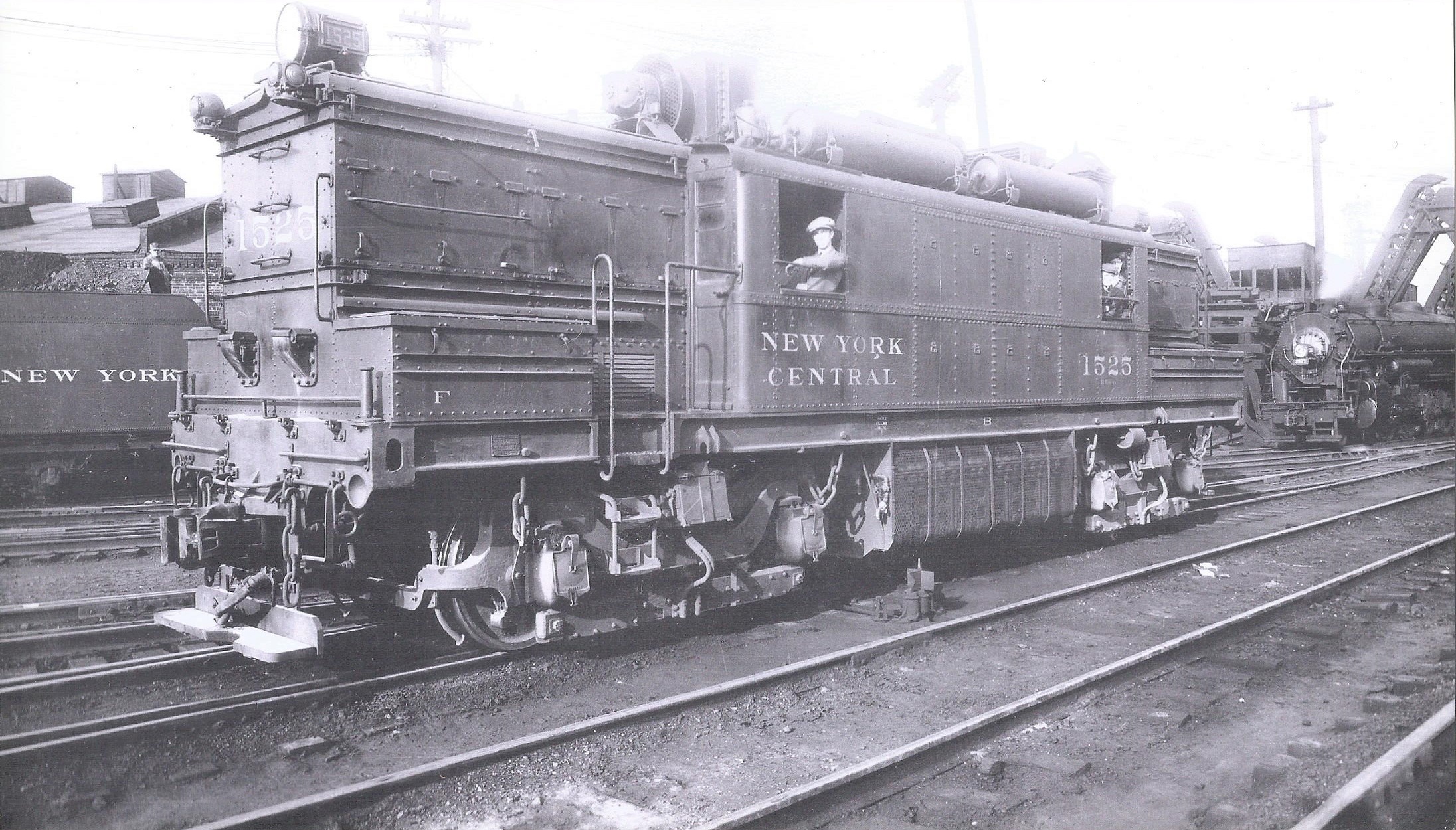
|
Following
the
resounding success of #1525, New York Central placed a follow-on order for 41 similar locomotives. Some changes in design were requested, the most notable being:
Specifications remained the same throughout the class. There were:
Two of the New York Central locomotives: #1561 and #1562 and the CRI&P #10000 unit were for pooled use at the Chicago Terminal. It is unknown how many of the remaining thirty-five New York Central DES-3's (#1526-1560) actually worked in Manhattan, but it is assumed all did. . Following the building of these locomotives, other railroads jumped on the bandwagon (Delaware Lackawanna & Western, Illinois Central) purchase similar units. All New York Central DES-3 locomotives were retired by 1957, which corresponds with the cessation of third rail use on the High Line. |
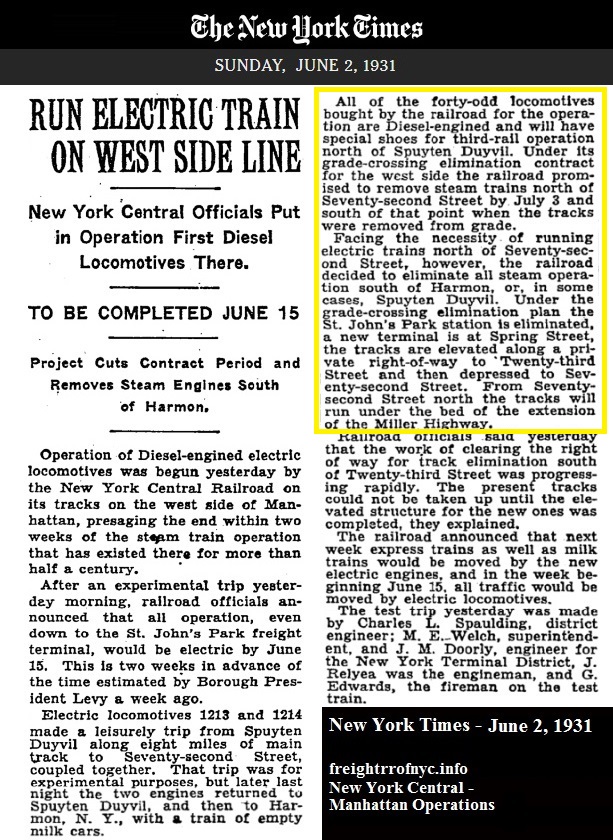 |
And... back to Diesel-Electric Locomotives
It goes without saying, over time, as diesel-electric locomotives evolved, they reached the stage were their power curve was suitable for long haul freight use as well as reliable switching. When this occurred in the mid to late 1930s through 1940's, all of the "big" locomotive manufacturers (ALCo, Baldwin, General Electric, EMD-GM and Fairbanks Morse built diesel-electric locomotives for every need, from the smallest 300 hp switcher to the largest road power 2000 hp, and various models with varying horsepower ratings proliferated throughout the United States.
While we know many diesel-electric locomotives would be purchased by the New York Central, it was only until after World War 2 that they made their way to the High Line. One, being the case of the war effort, , locomotive production was curtailed and factorys of the builder pressed into manufacturing armaments and material for the war.
Second, to remind you; because of physical limitations - some of the industries were indoor sidings. It wasn't until those meat purveyors and cold storage warehouses ceased their trade, could a standardized diesel-electric locomotive ply the High Line and not have to worry about imparting an exhaust smell on products. The ALCo / GE / IR DES-3 Tri-Powers worked the West Side of Manhattan until 1947.
Now the third rail is in the way - Notched stepboards and plows
|
For those mass produced models of diesel-electric locomotives
operating on in third rail territory south of
Croton-Harmon on the Hudson Line (or any other third rail powered line for that matter), because of clearance to the
third rail; it would have been required for the front and rear
step boards, pilot boards or snowplows to have have been "notched". This would prevent the footboard or plow from coming in contact with the third rail, and energizing the chassis of the locomotive, and potentially injuring or killing the crew; or to a lesser extent damage the third rail. It was not until 1954 or so that the third rail on the High Line from the West 35th to West 30th Street segment was de-energized, and not until around 1957 that it physically removed altogether. At this point in time, you would think any stock built diesel locomotive can work the High Line without modification. But... There is always a but. Unless an unmodified locomotive was carfloated across from New Jersey to West 72nd Street, (bypassing the third rail territory of the Hudson Line from Croton Harmon to West 72nd Street), a locomotive would need this modification. Why do you ask? Well, I'll tell ya.. (Not that you have a choice.). To get to the West Side Line, locomotives had to come into Manhattan via the Hudson Line from Croton-Harmon with was third rail territory. Even if its destination being the High Line, which no longer had third rail.This modification held true through the Penn Central era and is still in effect. Even in todays era of operations, there are locomotives that are modified to operate on third rail powered Hudson and Harlem Lines which still need to have their pilot / plow. It is known that CSX (the current Class 1 freight provider), have several locomotives with notched plows and these plows are painted with a yellow outline. |
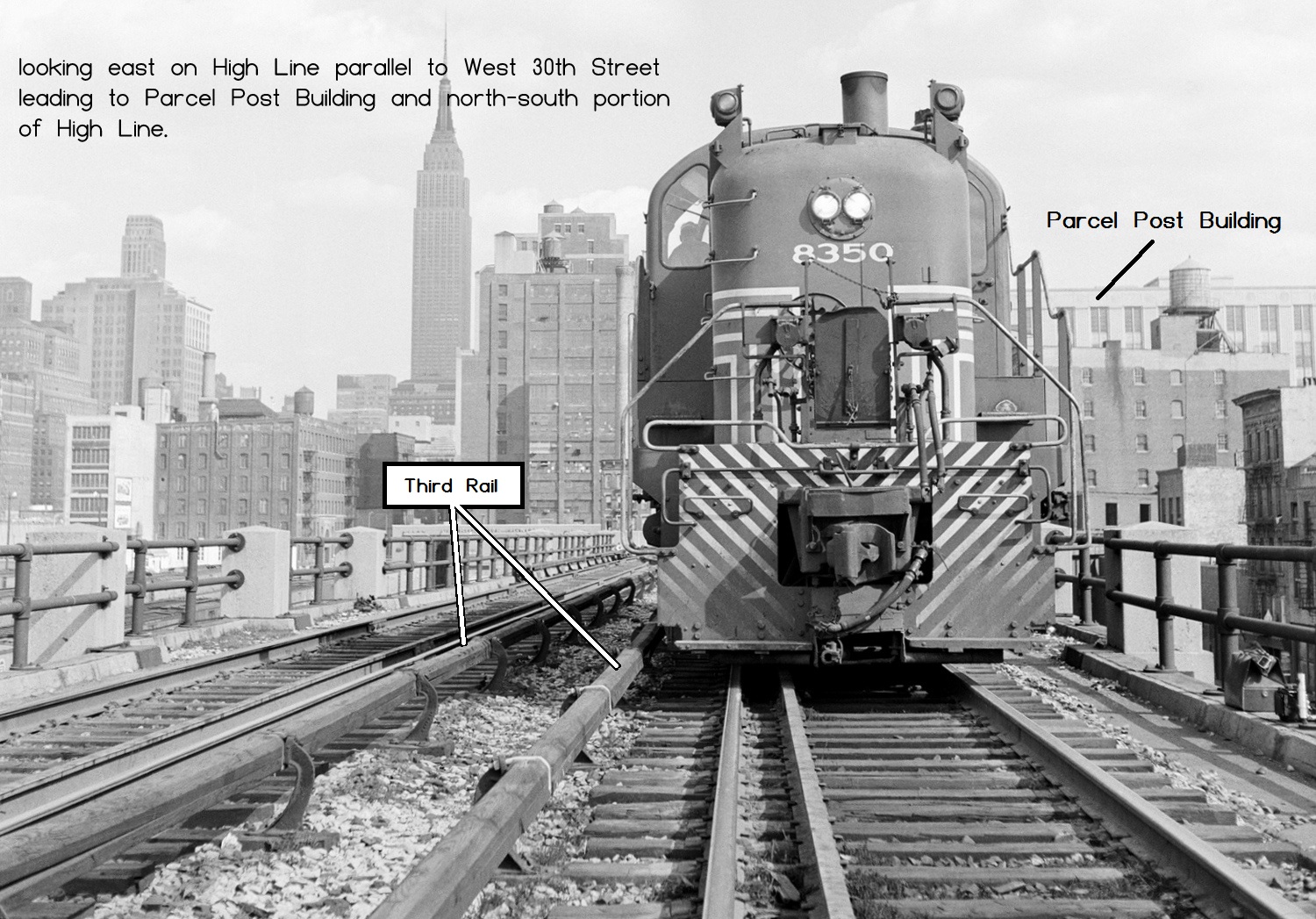 |
These locomotives are
usually assigned to the Selkirk Yard for use in hauling freight to and from the
New York City area, on the present day MetroNorth Commuter Railroad
Hudson Line, which absorbed many of the third rail routes of the former
New York Central.
Diesel-electric work locomotives operating for MetroNorth and Amtrak,
New York & Atlantic (the freight operation of the Long Island Rail
Road in Brooklyn and Queens) also have this modification for use on
third rail territory.
It is just one more detail to keep an eye out for.
.
Rosters of New York Central
Locomotives known to have operated in New York City
According to the New York Central Railroad Report of Board of
Director to the Stockholders, dated December 31, 1929; the New York
Central rostered
ten steam dummy locomotives on that date. But many more are known.
Please note: I have omitted from the table conventional uncovered (non-steam dummy) locomotives from the roster, even though there are a couple seen working in the yards. I have omitted these as they were not specific for use in Manhattan. They brought the through train south from Albany and perhaps other points, perhaps switched the yard, and went back north. But they were not specifically assigned to Manhattan. But I will include said images as they are seen operating on the streets of Manhattan.
| road | road # | builder | c/n | build date | cylinders | driver dia |
originally built as | renumbered | renumbered | rebuilt | renumber | retired |
| NYC&HR | #2 | |||||||||||
| NYC&HR | #3 | Schenectady | 3267 | 11/1890 | 15" x 22" | 46" | NYC #3 (1899?) | |||||
| NYC&HR | #4 | Schenectady | 2480 | 2/1888 | 15" x 22" | 46" | NYC&HR #11? | |||||
| NYC&HR | #5 (first) | Schenectady | 3265 | 10/1890 | 15" x 22" | 46" | NYC&HR #10 (first) | |||||
| NYC&HR | #6 (first) | Schenectady | 2954 | 2/1890 | 15" x 22" | 46" | NYC #6 (1899) | 1913 | ||||
| NYC&HR | #7 | Schenectady | 3266 | /1890 | 15" x 22" | 45" | NYC&HR #11 | NYC #7 (1899) | ||||
| NYC&HR | #9 (first) | Schenectady | 1482 | 12/1881 | 15" x 22" | 46" | NYC #1899 (date?) | |||||
| NYC&HR | #10 (first) | Schenectady | 1485 | 1/1882 | 15" x 22" | 46" | NYC #5 (1899?) | |||||
| NYC&HR | #11 (first) | Schenectady | 2480 | 2/1888 | 15" x 22" | 46" | NYC #4 (1899?) | 1909 | ||||
| NYC&HR | #12 (first) | Schenectady | 2481 | 2/1888 | 15" x 22" | 46" | NYC #8 (1899?) | 1909 |
Please note that several locomotives in the above roster operated concurrently with locomotives in the below roster.
.
.
| road | road # | builder | c/n ALCo / GE | build date | wheel dia | renumbered 1936? |
sold | retired | notes | scrapped |
| NYC | 1250 | ALCo / GE | 66415 / 9803 | 3/1926 | 44" | 150 | prior to 1966 | gear ratio: 72:17 max speed: 40 mph horsepower: 1665 tractive effort, one hour: 34,100 lbs. tractive effort, continuous full field: 25,260 lbs tractive effort, continuous reduced field: 18,820 lbs traction motors: (4) GE 286 GE class: B-B-200/200-4GE286 GE model LS404-E-100 |
||
| NYC | 1251 | ALCo / GE | 66416 / 9804 | 3/1926 | 44" | 151 | prior to 1966 | |||
| NYC | 1252 | ALCo / GE | 66417 / 9805 | 3/1926 | 44" | 152 | prior to 1966 | |||
| NYC | 1253 | ALCo / GE | 66418 / 9806 | 3/1926 | 44" | 153 | prior to 1966 | |||
| NYC | 1254 | ALCo / GE | 66419 / 9807 | 3/1926 | 44" | 154 | prior to 1966 | |||
| NYC | 1255 | ALCo / GE | 66420 / 9808 | 3/1926 | 44" | 155 | prior to 1966 | |||
| NYC | 1256 | ALCo / GE | 66421 / 9808 | 3/1926 | 44" | 156 | prior to 1966 |
| road | road # | builder | c/n ALCo / GE | build date | wheel dia | renumbered 1930? |
sold | retired | notes | scrapped |
| NYC | 1200 A / B | ALCo / GE | 66422 / 9801 | 9/1926 |
44" | 300? |
prior to 1930? |
GE class: B-B-340/340 8GE286 GE model LS4444-E-100 gear ratio: 72:17 max speed: 60 mph horsepower: 3320 tractive effort, one hour: 34,100 lbs. tractive effort, continuous full field: 25,260 lbs tractive effort, continuous reduced field: 18,820 lbs traction motors: (8) GE 286 |
||
| NYC | 1201 A / B | ALCo / GE | 66423 / 9802 | 9/1926 | 44" | 301? |
prior to 1930? |
| road | road # | builder | c/n ALCo / GE | build date | wheel dia | renumbered 1936? |
sold | retired | notes | scrapped |
| NYC | 1200 | ALCo / GE | 68230 / 11153 | 1931 | 44" | 300 | GE class C-C-270/270-6GE286B GE model: 135T EL horsepower: 2500 |
|||
| NYC | 1201 | ALCo / GE | 68231 / 11154 | 1931 | 44" | 301 | ||||
| NYC | 1202 | ALCo / GE | 68232 / 11155 | 1931 | 44" | 302 | ||||
| NYC | 1203 | ALCo / GE | 68233 / 11156 | 1931 | 44" | 303 | Chicago, South Shore & South Bend #703 | |||
| NYC | 1204 | ALCo / GE | 68234 / 11157 | 1931 | 44" | 304 | ||||
| NYC | 1205 | ALCo / GE | 68235 / 11158 | 1931 | 44" | 305 | ||||
| NYC | 1206 | ALCo / GE | 68236 / 11159 | 1931 | 44" | 306 | ||||
| NYC | 1207 | ALCo / GE | 68237 / 11160 | 1931 | 44" | 307 | ||||
| NYC | 1208 | ALCo / GE | 68238 / 11161 | 1931 | 44" | 308 | Chicago, South Shore & South Bend #701 | |||
| NYC | 1209 | ALCo / GE | 68239 / 11162 | 1931 | 44" | 309 | ||||
| NYC | 1210 | ALCo / GE | 68240 / 11163 | 1931 | 44" | 310 | ||||
| NYC | 1211 | ALCo / GE | 68241 / 11164 | 1931 | 44" | 311 | ||||
| NYC | 1212 | ALCo / GE | 68242 / 11165 | 1931 | 44" | 312 | ||||
| NYC | 1213 | ALCo / GE | 68243 / 11166 | 1931 | 44" | 313 | ||||
| NYC | 1214 | ALCo / GE | 68244 / 11167 | 1931 | 44" | 314 | Chicago, South Shore & South Bend #702 | |||
| NYC | 1215 | ALCo / GE | 68245 / 11168 | 1931 | 44" | 315 | ||||
| NYC | 1216 | ALCo / GE | 68246 / 11169 | 1931 | 44" | 316 | ||||
| NYC | 1217 | ALCo / GE | 68247 / 11170 | 1931 | 44" | 317 | ||||
| NYC | 1218 | ALCo / GE | 68248 / 11171 | 1931 | 44" | 318 | Chicago, South Shore & South Bend for parts | |||
| NYC | 1219 | ALCo / GE | 68249 / 11172 | 1931 | 44" | 319 | ||||
| NYC | 1220 | ALCo / GE | 68250 / 11173 | 1931 | 44" | 320 | ||||
| NYC | 1221 | ALCo / GE | 68251 / 11174 | 1931 | 44" | 321 | ||||
| NYC | 1222 | ALCo / GE | 68252 / 11175 | 1931 | 44" | 322 | Chicago, South Shore & South Bend #707 | |||
| NYC | 1223 | ALCo / GE | 68253 / 11176 | 1931 | 44" | 323 | ||||
| NYC | 1224 | ALCo / GE | 68254 / 11177 | 1931 | 44" | 324 | Chicago, South Shore & South Bend #704 | |||
| NYC | 1225 | ALCo / GE | 68255 / 11178 | 1931 | 44" | 325 | ||||
| NYC | 1226 | ALCo / GE | 68256 / 11179 | 1931 | 44" | 326 | ||||
| NYC | 1227 | ALCo / GE | 68257 / 11180 | 1931 | 44" | 327 | ||||
| NYC | 1228 | ALCo / GE | 68258 / 11181 | 1931 | 44" | 328 | ||||
| NYC | 1229 | ALCo / GE | 68259 / 11182 | 1931 | 44" | 329 | ||||
| NYC | 1230 | ALCo / GE | 68260 / 11183 | 1931 | 44" | 330 | ||||
| NYC | 1231 | ALCo / GE | 68261 / 11184 | 1931 | 44" | 331 | ||||
| NYC | 1232 | ALCo / GE | 68262 / 11185 | 1931 | 44" | 332 | ||||
| NYC | 1233 | ALCo / GE | 68263 / 11186 | 1931 | 44" | 333 | ||||
| NYC | 1234 | ALCo / GE | 68264 / 11187 | 1931 | 44" | 334 | Chicago, South Shore & South Bend for parts | |||
| NYC | 1235 | ALCo / GE | 68265 / 11188 | 1931 | 44" | 335 | Chicago, South Shore & South Bend for parts | |||
| NYC | 1236 | ALCo / GE | 68266 / 11189 | 1931 | 44" | 336 | ||||
| NYC | 1237 | ALCo / GE | 68267 / 11190 | 1931 | 44" | 337 | ||||
| NYC | 1238 | ALCo / GE | 68268 / 11191 | 1931 | 44" | 338 | ||||
| NYC | 1239 | ALCo / GE | 68269 / 11192 | 1931 | 44" | 339 | ||||
| NYC | 1240 | ALCo / GE | 68270 / 11193 | 1931 | 44" | 340 | Chicago, South Shore & South Bend #705 | |||
| NYC | 1241 | ALCo / GE | 68271 / 11194 | 1931 | 44" | 341 | Chicago, South Shore & South Bend #706 |
| Prototype? Demonstrator? |
|||||||
| New York Central road # | GE c/n | order number | build date | NYC renumber | retired | notes | |
| NYC #1505 | 8754 | |
1930 |
505 (1934) | 12/1944 |
locomotive originally built June 1923 for Bethlehem Steel. Only unit built. GE Model: LS404-OE-80 GE Class: B-B-80/80-4HM830 40 ton, Oil Electric,195 volt, 250 hp returned to General Electric rebuilt as 45 ton Diesel-electric prime mover: Buda 4 cylinder wheel arrangement: B-B weight: 45 tons rating: 250 hp to New York Central in 1933 (?) assigned NYC Class DES-a #1505. sold to Eastman Kodak; Rochester, NY- Dec 1944 |
|
| Prototype - DES-2 |
|||||||
| New York Central road # | ALCo c/n | GE c/n | order number | build date | NYC renumber | retired | notes |
| NYC #1525 | 67101 | 10326 | (A-67101) | 2/1928 | 525 (1936) | 1945 | ALCo order S1566 GE Class:B-B-350/350-O-4GE286 prototype Tri-Power diesel-electric / third rail / battery wheel arrangement: B-B weight: 175 tons prime mover: Ingersoll Rand 300 rating: 300 hp NYC Class: DES-2 length (over coupler pulling faces) 46' 8", height 14' 8" width 10' 2" converted to diesel hump trailer #479 in 12/1945 |
|
|||||||
| NYC Road # | ALCo c/n | GE c/n | order number | build date | NYC renumber (1936?) | retired | notes |
| Michigan Central #7530 | 68355 | 11210 | (A-68355) | 5/1930 | rebuilt to Hump Trailer #HT474 | ||
| Michigan Central #7531 | 68356 | 11211 | (A-68356) | 5/1930 | |||
| Michigan Central #7532 | 68357 | 11212 | (A-68357) | 6/1930 | |||
| Michigan Central #7533 | 68358 | 11213 | (A-68358) | 6/1930 | |||
| NYC #1526 | 68359 | 11111 | (A-68359) | 7/1930 | 526 | led the second Dedication Train | |
| NYC #1527 | 68360 | 11112 | (A-68360) | 7/1930 | 527 | ||
| NYC #1528 | 68361 | 11113 | (A-68361) | 7/1930 | 528 | ||
| NYC #1529 | 68362 | 11114 | (A-68362) | 7/1930 | 529 | ||
| NYC #1530 | 68363 | 11115 | (A-68363) | 7/1930 | 530 | ||
| NYC #1531 | 68364 | 11116 | (A-68364) | 8/1930 | 531 | ||
| NYC #1532 | 68365 | 11117 | (A-68365) | 8/1930 | 532 | ||
| NYC #1533 | 68366 | 11118 | (A-68366) | 8/1930 | 533 | ||
| NYC #1534 | 68367 | 11119 | (A-68367) | 8/1930 | 534 | ||
| NYC #1535 | 68368 | 11120 | (A-68368) | 8/1930 | 535 |
rebuilt to Hump Trailer
#HT476 |
|
| NYC #1536 | 68369 | 11121 | (A-68369) | 8/1930 | 536 | 10/1955 | scrapped 10/1955 |
| NYC #1537 | 68370 | 11122 | (A-68370) | 8/1930 | 537 | ||
| NYC #1538 | 68371 | 11123 | (A-68371) | 11/1930 | 538 | ||
| NYC #1539 | 68372 | 11124 | (A-68372) | 11/1930 | 539 | ||
| NYC #1540 | 68373 | 11125 | (A-68373) | 11/1930 | 540 | ||
| NYC #1541 | 68374 | 11126 | (A-68374) | 11/1930 | 541 | ||
| NYC #1542 | 68375 | 11127 | (A-68375) | 11/1930 | 542 | 11/1949 | rebuilt to hump trailer #HT473 scrapped 5/1962 |
| NYC #1543 | 68376 | 11128 | (A-68376) | 11/1930 | 543 | ||
| NYC #1544 | 68377 | 11129 | (A-68377) | 11/1930 | 544 | ||
| NYC #1545 | 68378 | 11130 | (A-68378) | 11/1930 | 545 | ||
| NYC #1546 | 68379 | 11131 | (A-68379) | 11/1930 | 546 | ||
| NYC #1547 | 68380 | 11132 | (A-68380) | 11/1930 | 547 | ||
| NYC #1548 | 68381 | 11133 | (A-68381) | 12/1930 | 548 | ||
| NYC #1549 | 68382 | 11134 | (A-68382) | 12/1930 | 549 | ||
| NYC #1550 | 68383 | 11135 | (A-68383) | 12/1930 | 550 | ||
| NYC #1551 | 68384 | 11136 | (A-68384) | 12/1930 | 551 | rebuilt to Hump Trailer #HT475 | |
| NYC #1552 | 68385 | 11137 | (A-68385) | 12/1930 | 552 | ||
| NYC #1553 | 68386 | 11138 | (A-68386) | 11/1930 | 553 | ||
| NYC #1554 | 68387 | 11139 | (A-68387) | 11/1930 | 554 | led the Dedication Train | |
| NYC #1555 | 68388 | 11140 | (A-68388) | 11/1930 | 555 | ||
| NYC #1556 | 68389 | 11141 | (A-68389) | 12/1930 | 556 | ||
| NYC #1557 | 68390 | 11142 | (A-68390) | 12/1930 | 557 | ||
| NYC #1558 | 68391 | 11143 | (A-68391) | 12/1930 | 558 | ||
| NYC #1559 | 68392 | 11144 | (A-68392) | 12/1930 | 559 | ||
| NYC #1560 | 68393 | 11145 | (A-68393) | 12/1930 | 560 | ||
| NYC #1561 | 68393 | 11230 | (A-68393) | 7/1930 | 560 | LaSalle
Street Station, Chicago, IL? rebuilt to Hump Trailer #HT472 |
|
| NYC #1562 | 68393 | 11231 | (A-68393) | 7/1930 | 560 | LaSalle
Street Station, Chicago, IL? rebuilt to Hump Trailer #HT471 |
|
|
Special
thanks are in order to CanadaSouthern.com / Terry Link / and Keith
Sirman for use of their photo archives of locomotive images
0-4-0T & 0-6-0T Steam Dummy Photos |
|
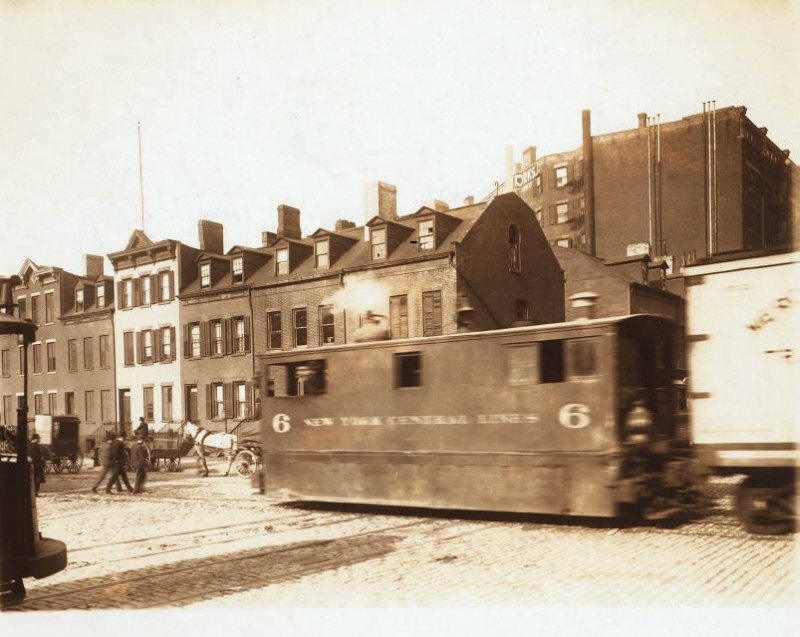 New York Central #6 (first) 0-4-0T - Hudson Street & Vestry Street - ca. 1900 Schenectady Locomotive Works c/n 2954 - built February 1890 Looking northeast at 188, 190, 192 Hudson Street. Train is heading (pushing) towards New York Central & Hudson River Freight Depot one block right (south). Vestry Street streetcar (left edge of photo) NYPL Digital Archives 13 February 2010 |
|
| .
. |
|
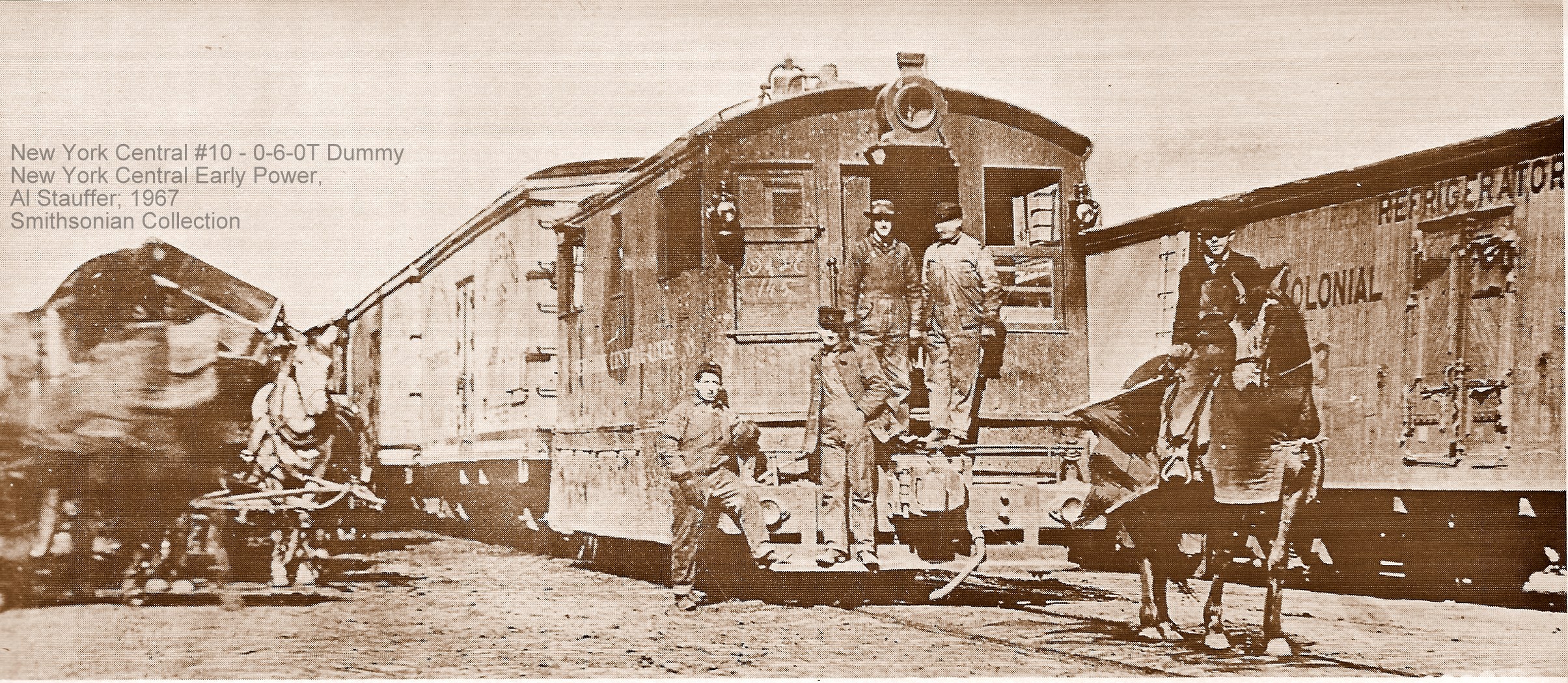 New York Central #8 [0-4-0T Dummy] - unknown date Schenectady Locomotive Works c/n 2481 - built 2/1888 Smithsonian Institution collection New York Central Early Power, Al Staufer added 22 April 2024 |
|
| .
. |
|
New York Central #9 (first) 0-4-0T - ca. 1898 Schenectady Locomotive Works c/n 1482 - built December 1881 Looking southeast at St. John's Park Terminal; Hudson Street and Laight Street King 1898 postcard added 05 April 2024 |
|
| .
. |
|
 New York Central #9 (first) 0-4-0T - unknown date Schenectady Locomotive Works c/n 1482 - built December 1881 image used in "Memories of New York Central Steam"; Arnold Hass, 1980 photo not attributed - unknown photographer added 23 April 2024 |
|
| .
. |
|
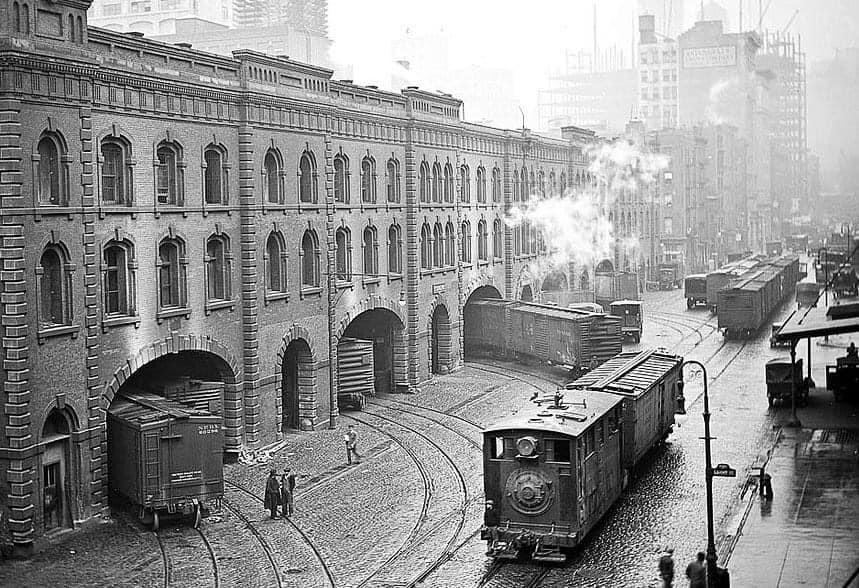 New York Central # [0-6-0T Dummy] - unknown date unknown builders data Looking south-southeast along Hudson Street at Laight Street. This is now the Holland Tunnel Exit Plaza. unknown provenance, possibly NYPL Digital Archive Mike Davis, of Troy, Michigan offers the following for dating: "The boxcars are some steel ends mixed in, but most glaring of all, the 150 foot Bronze relief and Vanderbilt statue are missing in this photo. I would think this would place it towards the end of its working life (on or about 1928 to 1932)." seeking 1st Generation hi resolution version of this image added 05 April 2024 |
|
| .
. |
|
 New York Central #2 [0-6-0T Dummy] - unknown date D. Lowy & Co. Scrap Iron, 68 Tenth Avenue between West 14th and West 15th Streets. collection of Terry Link / canadasouthern.com Keith Sirman collection added 05 April 2024 |
|
| .
. |
|
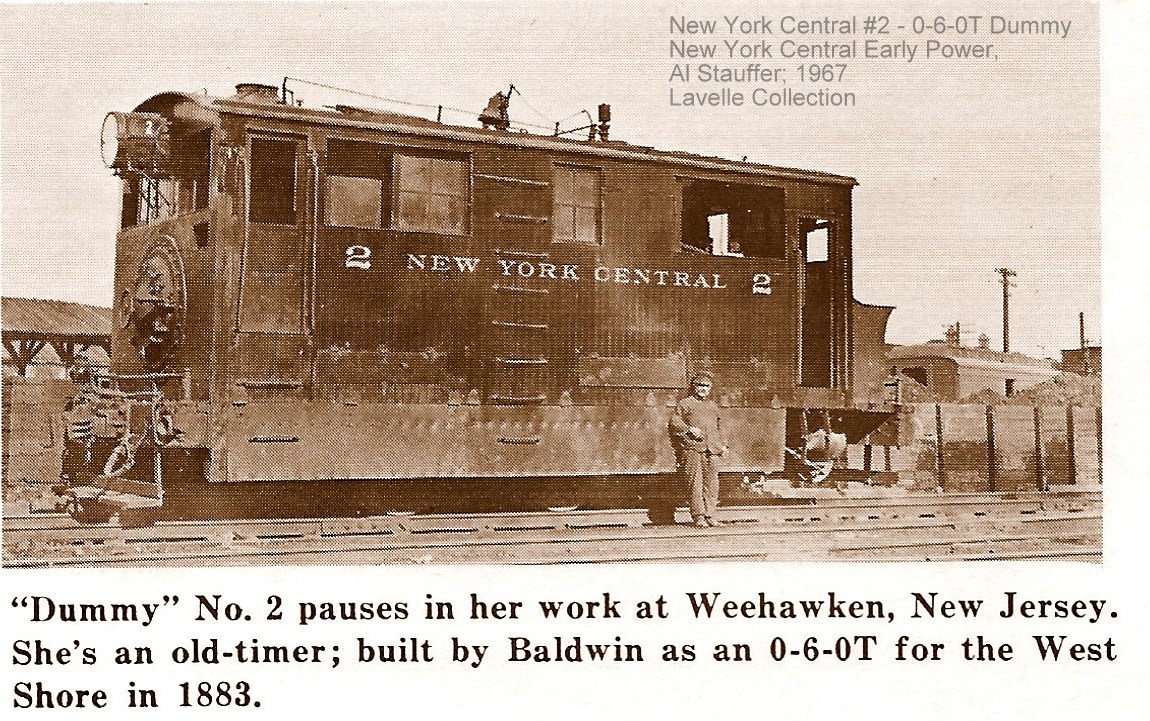 New York Central #2 [0-6-0T Dummy] - unknown date Lavelle collection New York Central Early Power, Al Staufer added 22 April 2024 |
|
| .
. |
|
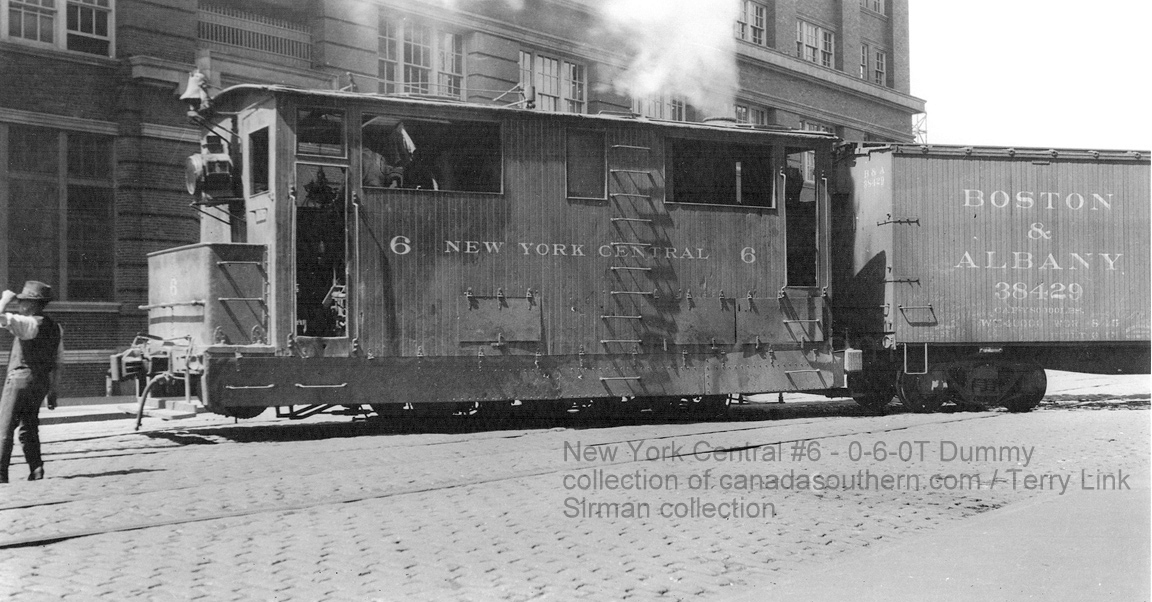 New York Central #6 (second) [0-6-0T Dummy] - unknown date Schenectady Locomotive Works c/n 3281 - built 1890 indeterminable location collection of Terry Link / canadasouthern.com Keith Sirman collection added 05 April 2024 |
|
| .
. |
|
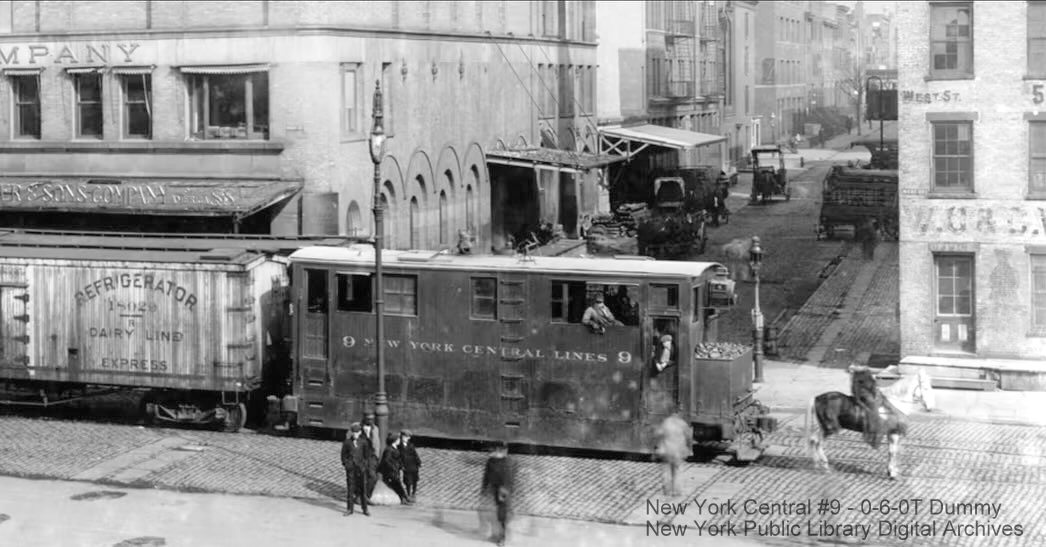 New York Central #9 (second) [0-6-0T Dummy] - unknown date Schenectady Locomotive Works c/n 4030 - built February 1893 Looking east at Manhattan Refrigerating on Tenth Avenue / West Street; up Horatio Street to right. cropped image to one below. New York Public Library Digital Archives added 05 April 2024 |
|
| .
. |
|
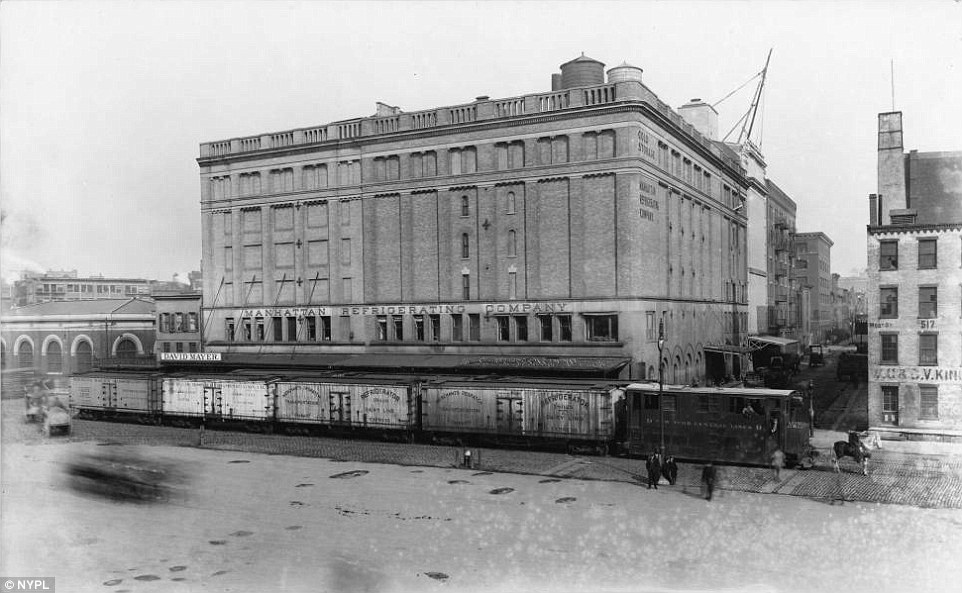 New York Central #9 (second) [0-6-0T Dummy] - unknown date Schenectady Locomotive Works c/n 4030 - built February 1893 Looking east at Manhattan Refrigerating on Tenth Avenue / West Street; 806 Washington Street; Horatio Street to right, Gansevoort St to left. New York Public Library Digital Archives added 05 April 2024 |
|
| .
. |
|
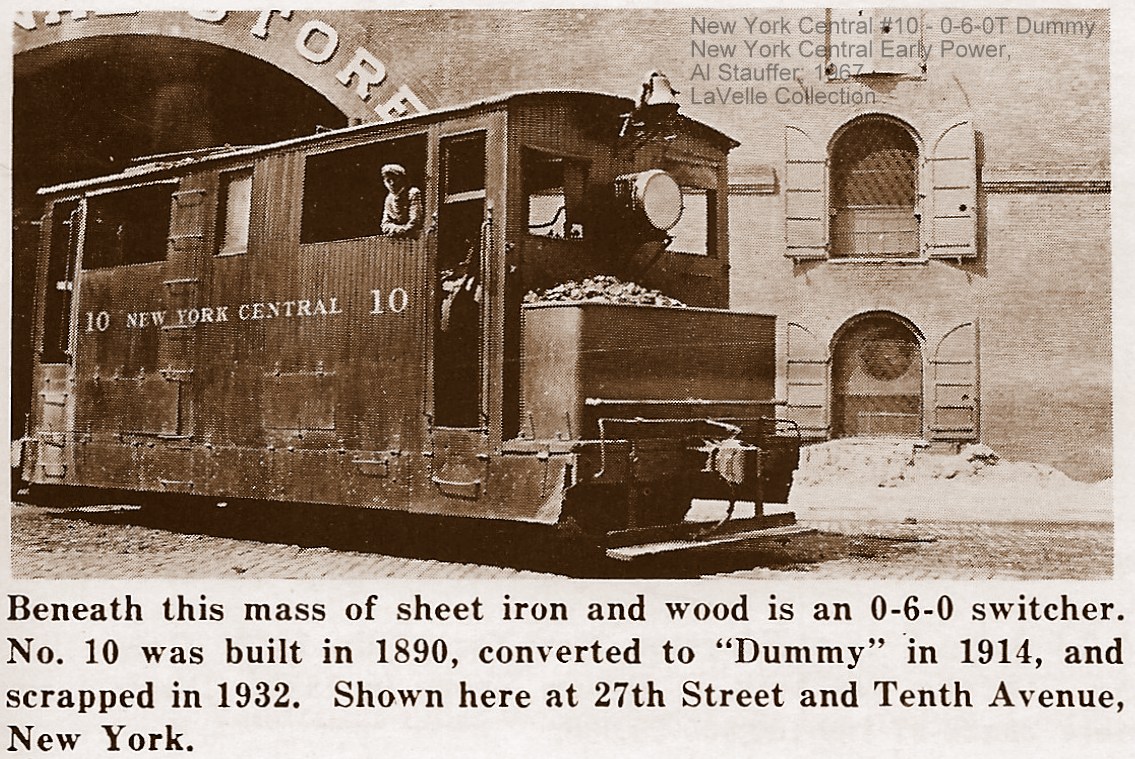 New York Central #10 (second or third?) [0-6-0T Dummy] - unknown date either: Baldwin c/n 6970 built 10/1883 (rebuilt 1907) or Schenectady Locomotive Works c/n 3162 - built 1890 Terminal Stores Building, West 27th Street and Tenth Avenue; Manhattan, NY Lavelle collection New York Central Early Power, Al Staufer added 22 April 2024 |
|
| .
. |
|
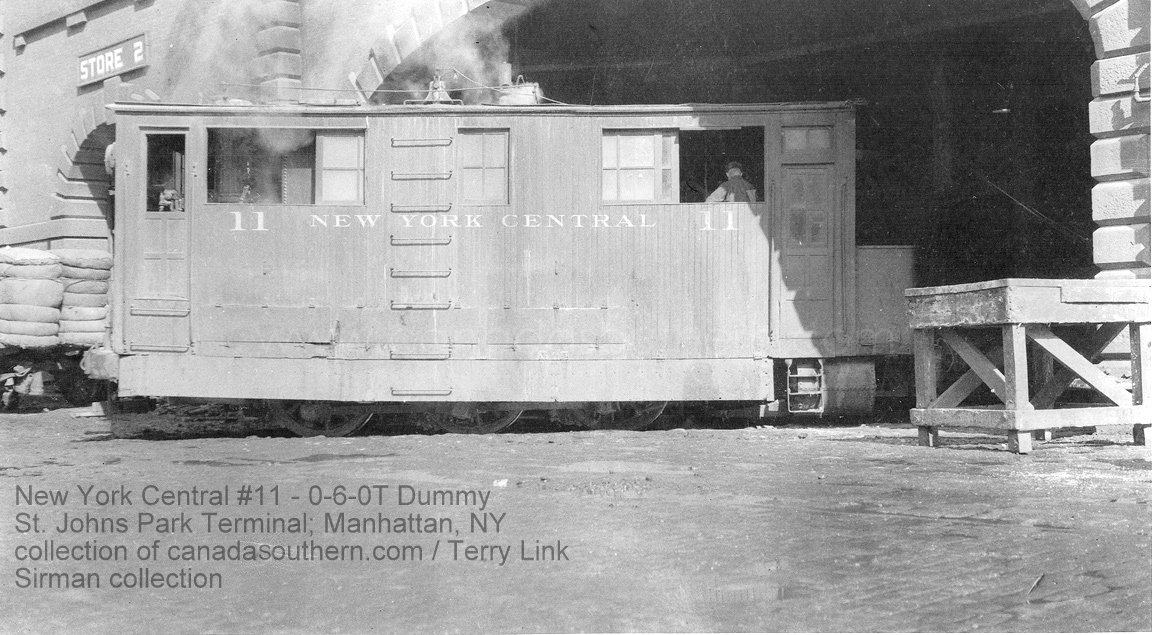 New York Central #11 (second) [0-6-0T Dummy] - unknown date Schenectady Locomotive Works c/n 3460 - built March 1891 St. Johns Park Terminal - Hudson Street, Manhattan, NY collection of Terry Link / canadasouthern.com Keith Sirman collection added 05 April 2024 |
|
| .
. |
|
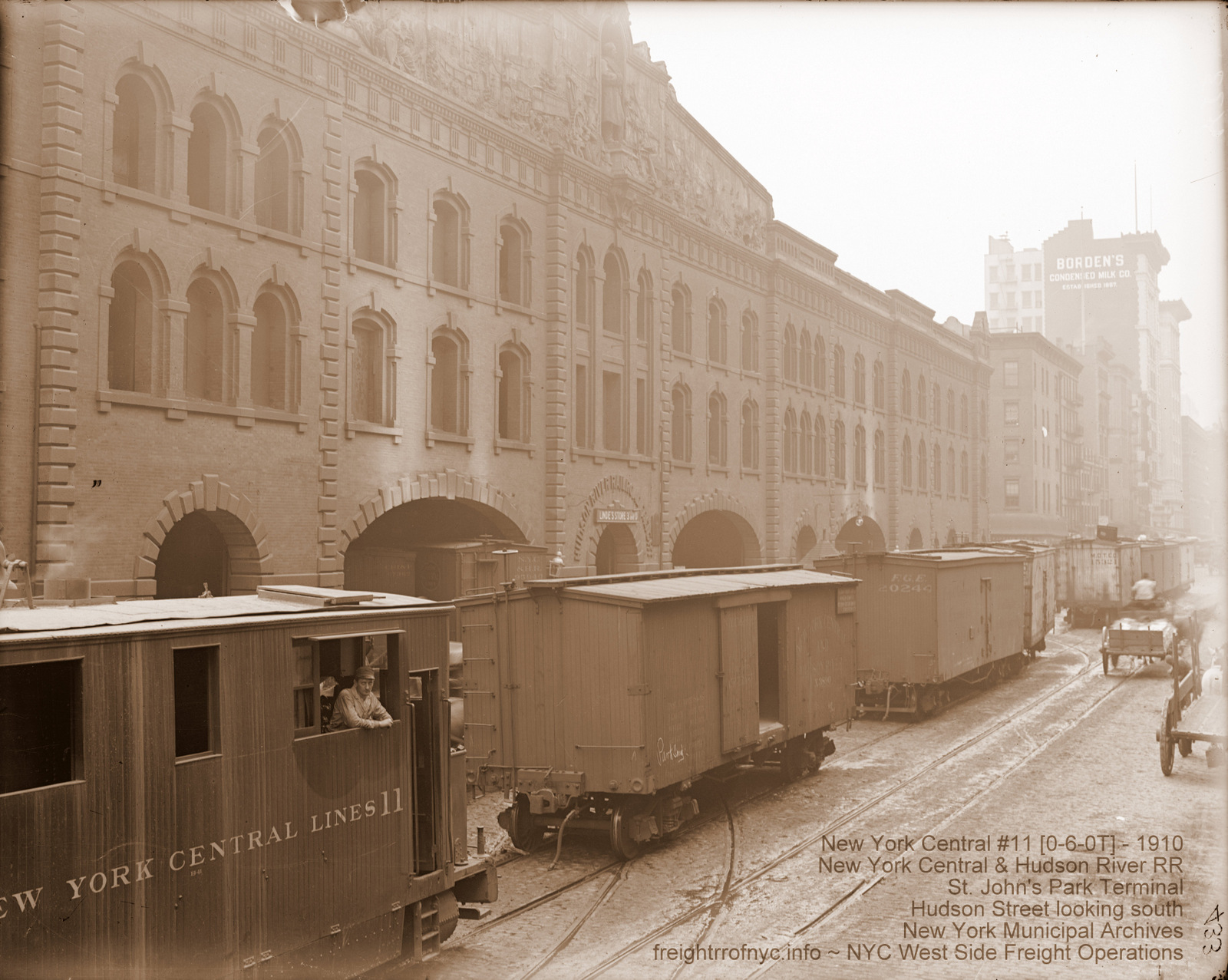 New York Central #11 (second) [0-6-0T Dummy] - 1910 Schenectady Locomotive Works c/n 3460 - built March 1891 St. Johns Park Terminal - Hudson Street, Manhattan, NY New York Municipal Archive added 14 August 2025 |
|
| .
. |
|
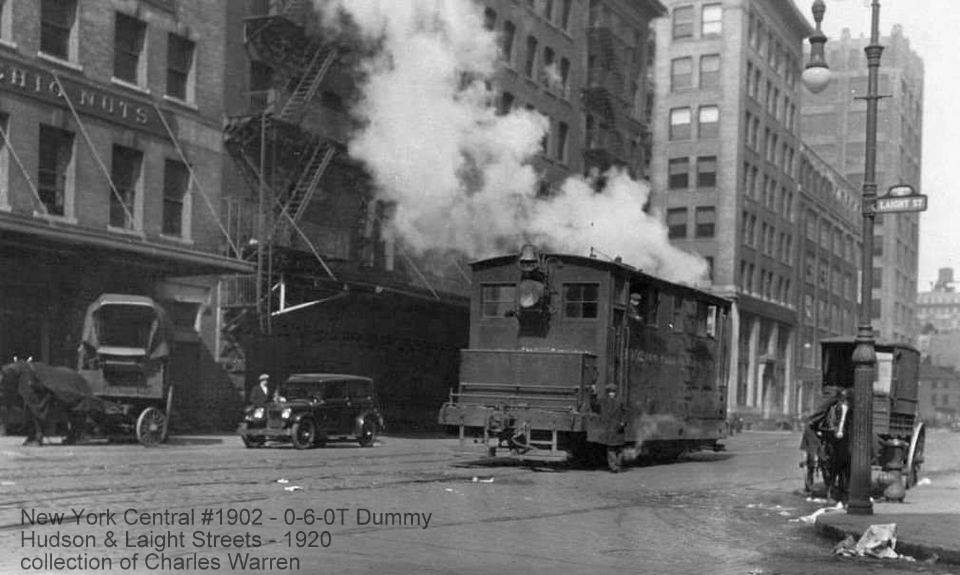 New York Central #1902 - ex-#6 (second) - 1929 Looking north along Hudson Street at Laight Street; Manhattan, NY (St John's Park Terminal behind photographer.) collection of Charles Warren added 05 April 2024 |
|
| .
. |
|
|
|
|
| .
. |
|
|
|
|
| .
. |
|
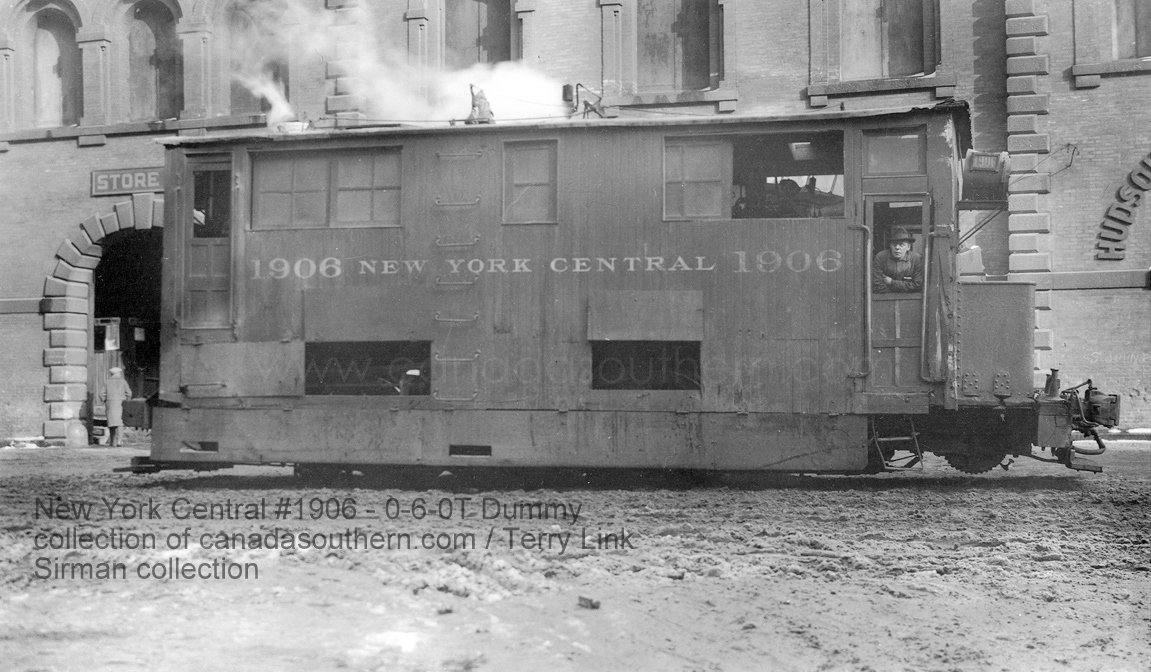 New York Central #1906 (former #12) [0-6-0T Dummy] - unknown date St. Johns Park Terminal; Manhattan, NY collection of Terry Link / canadasouthern.com Keith Sirman collection added 05 April 2024 |
|
| .
. |
|
|
|
|
| .
. |
|
|
|
|
| .
. |
|
|
|
|
| .
. |
|
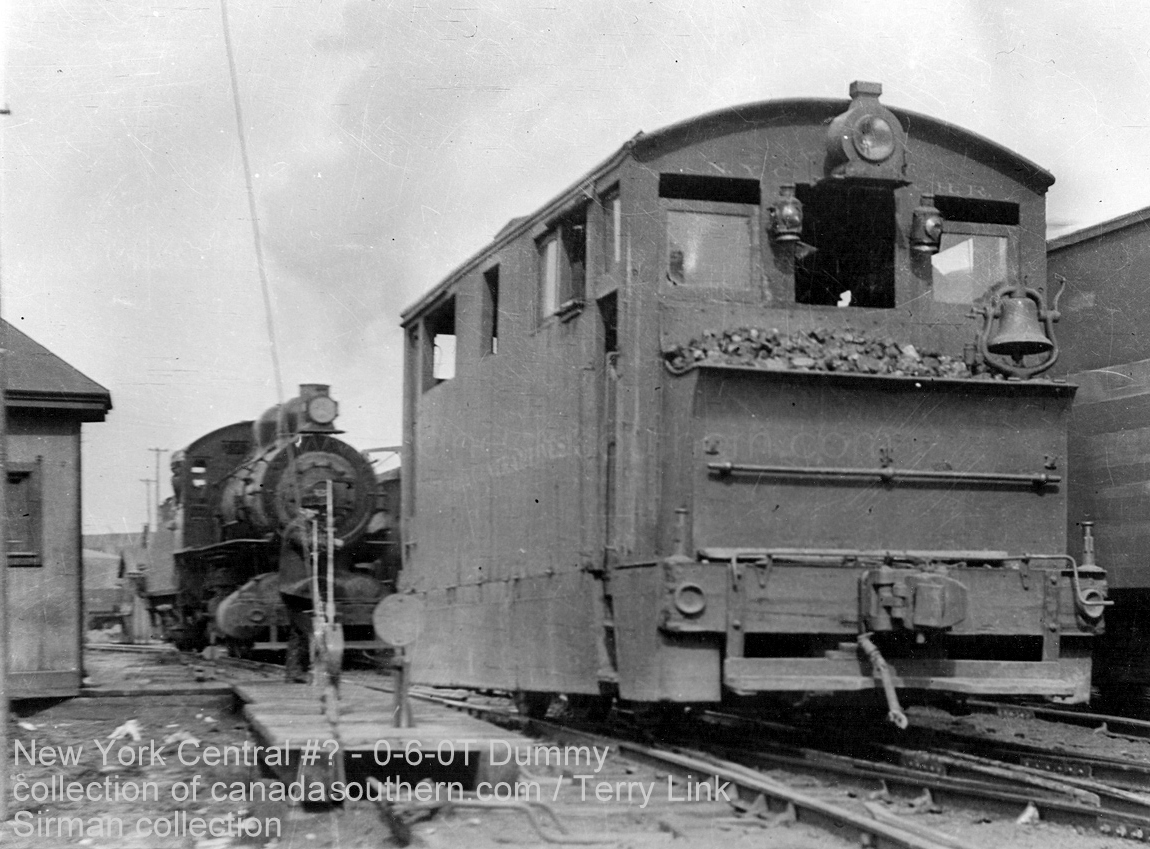 New York Central #unknown [0-6-0T Dummy] - unknown date collection of Terry Link / canadasouthern.com Keith Sirman collection added 05 April 2024 |
|
| .
. |
|
|
|
|
| .
. |
|
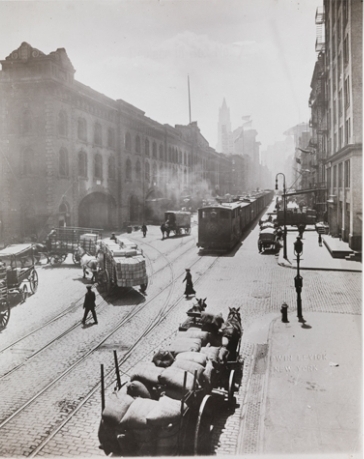 St. Johns Park Terminal (pre -1930) seeking hi resolution version of this image added 05 April 2024 |
|
| .
. |
|
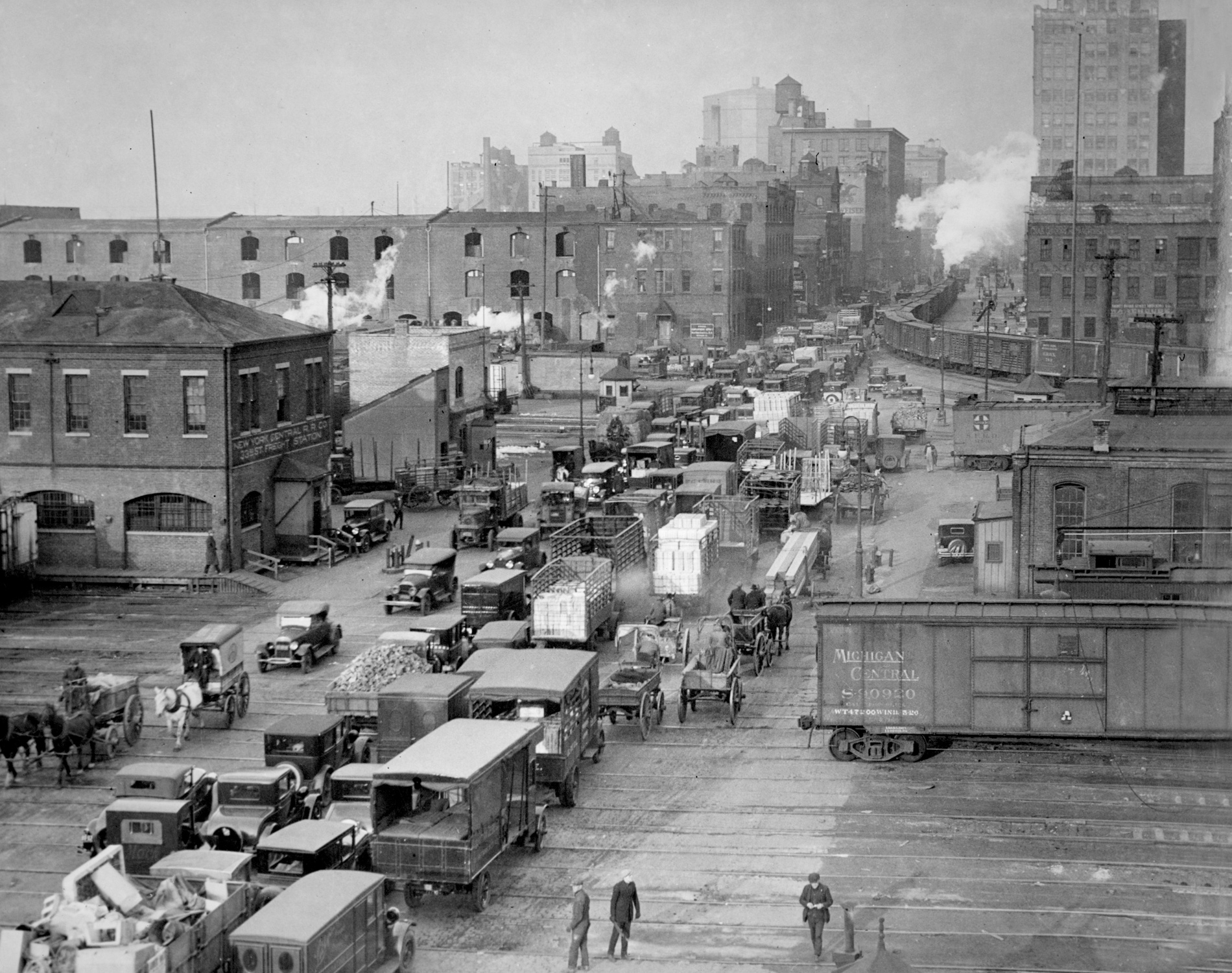 New York Central West 33rd Street Freight Station - Eleventh Avenue - ca. 1930 The impetus to getting freight trains off the avenues and streets of Manhattan. Looking north. unknown provenance, possibly New York Public Library Digital Archives added 05 April 2024 |
|
| .
. |
|
|
Lima Locomotive Works "Shay" Type Photos |
|
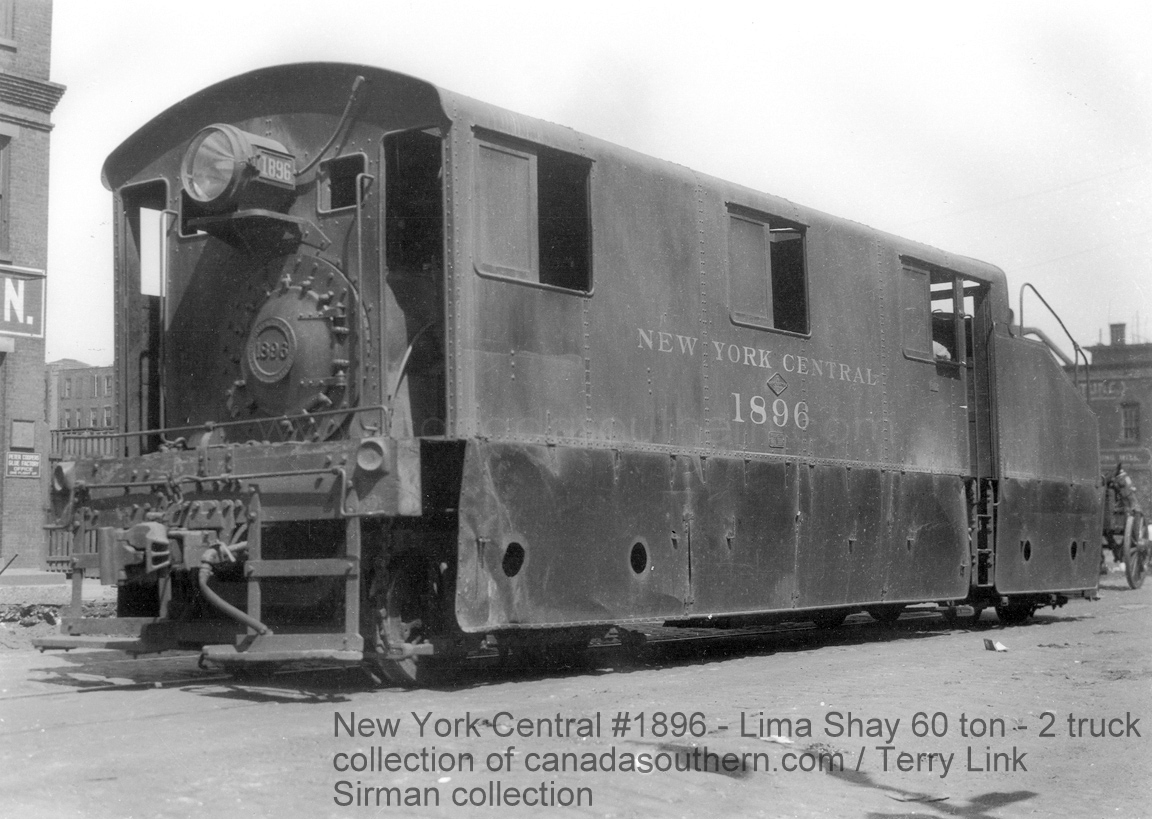 New York Central #1896 [60 ton - 2 truck, NYC Class B-60]; Manhattan, NY - unknown date (post 1923) Lima Locomotive Works c/n 3235 - built 11/10/1923 collection of Terry Link - canadasouthern.com Keith Sirman collection added 05 April 2024 |
|
| .
. |
|
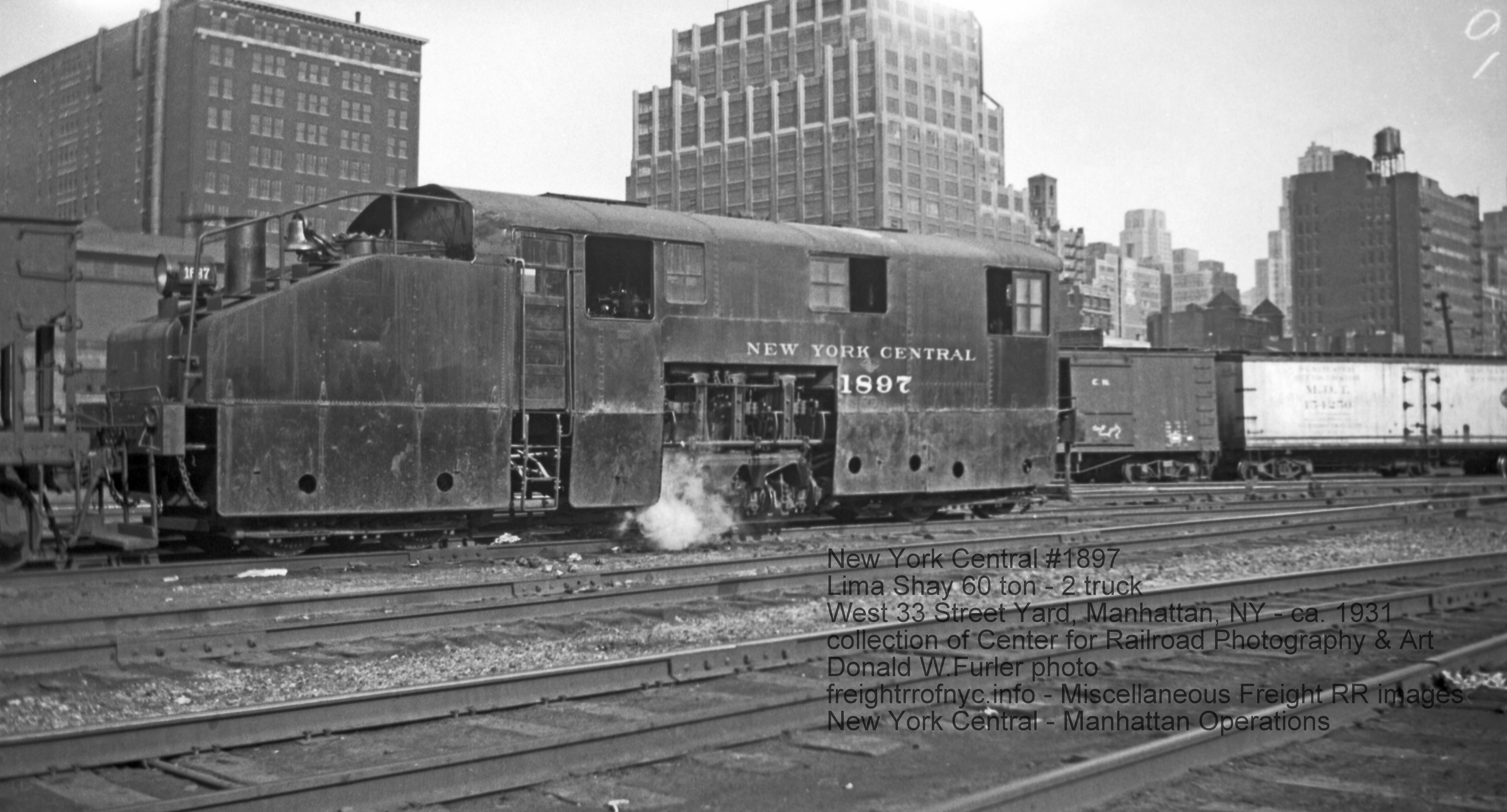 New York Central #1897 [60 ton - 2 truck, NYC Class B-60]; West 32 Street between Eleventh and Tenth Avenues, Manhattan, NY - ca. 1931 Lima Locomotive Works c/n 3236 - built 11/14/1923 Looking east-northeast. Donald W.Furler photo collection of the Center for Railroad Photography & Art added 05 April 2024 |
|
| .
. |
|
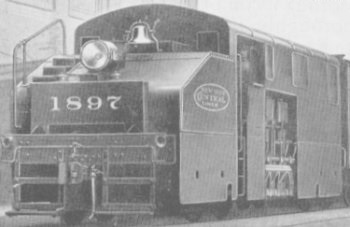 New York Central #1897 [60 ton - 2 truck, NYC Class B-60] Lima Locomotive Works c/n 3236 - built 11/14/1923 Looking east-northeast. Lima Locomotives Works Catalog - Shay Type image courtesy of www.shaylocomotives.com added 05 April 2024 |
|
| .
. |
|
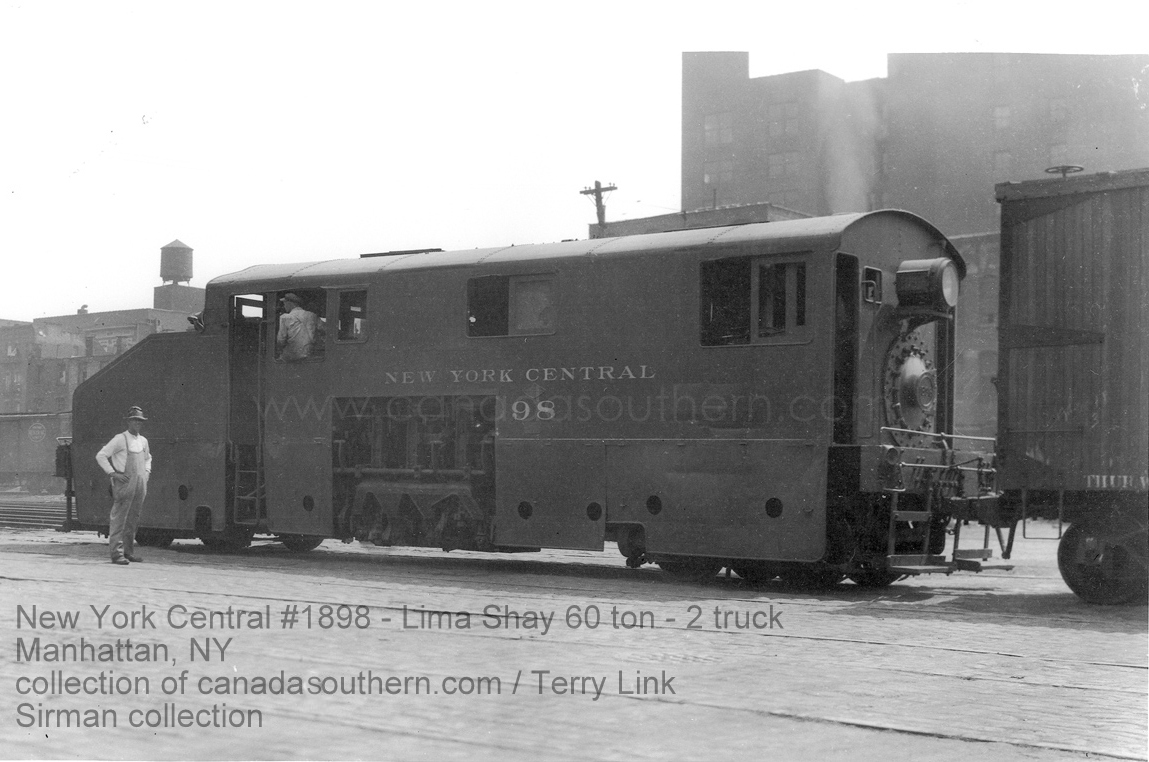 New York Central #1898 - [60 ton - 2 truck, NYC Class B-60]; Manhattan, NY - unknown date (post 1923) Lima Locomotive Works c/n 3237 - built 11/17/1923 collection of Terry Link - canadasouthern.com Keith Sirman collection added 05 April 2024 |
|
| .
. |
|
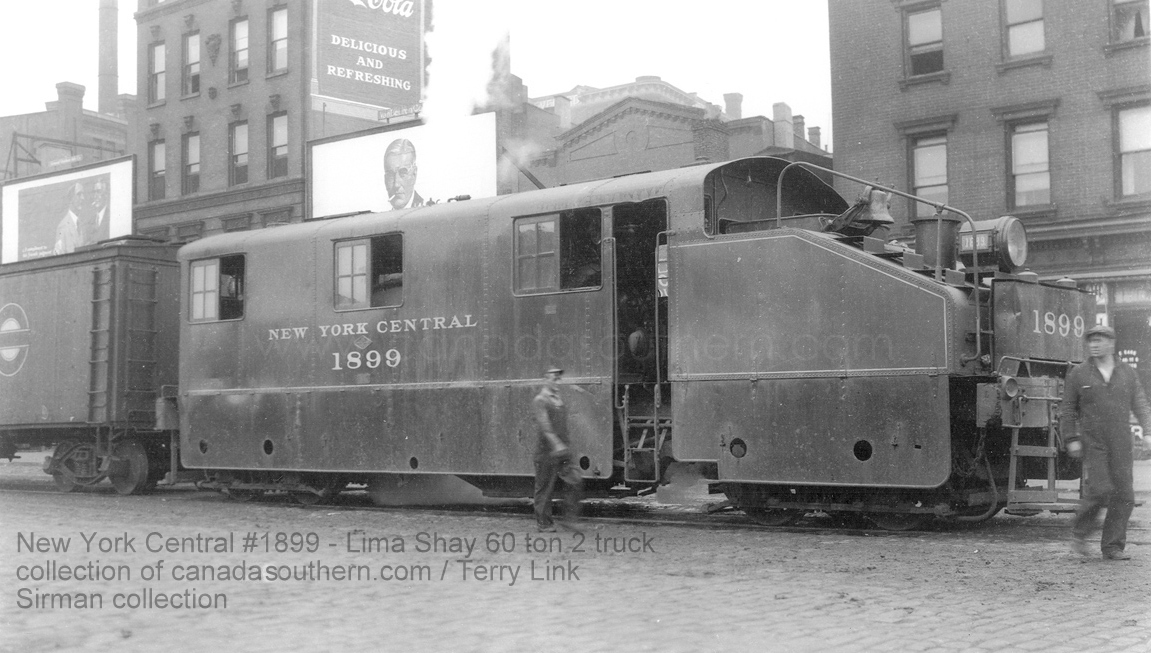 New York Central #1899 - [60 ton - 2 truck, NYC Class B-60]; Manhattan, NY - unknown date (post 1923) Lima Locomotive Works c/n 3238 - built 11/26/1923 collection of Terry Link - canadasouthern.com Keith Sirman collection added 05 April 2024 |
|
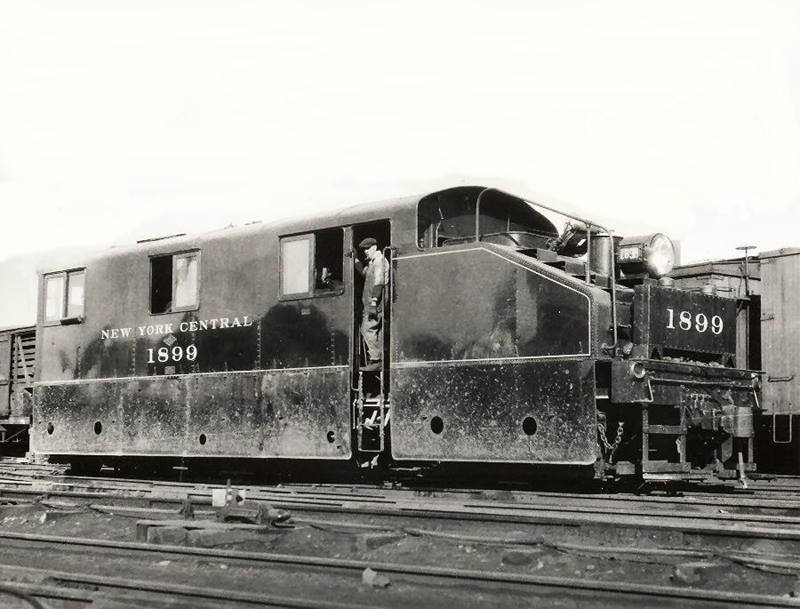 New York Central #1899 - [60 ton - 2 truck, NYC Class B-60]; Manhattan, NY - unknown date (post 1923) Lima Locomotive Works c/n 3238 - built 11/26/1923 collection of ? New York Central Facebook Group |
|
| .
. |
|
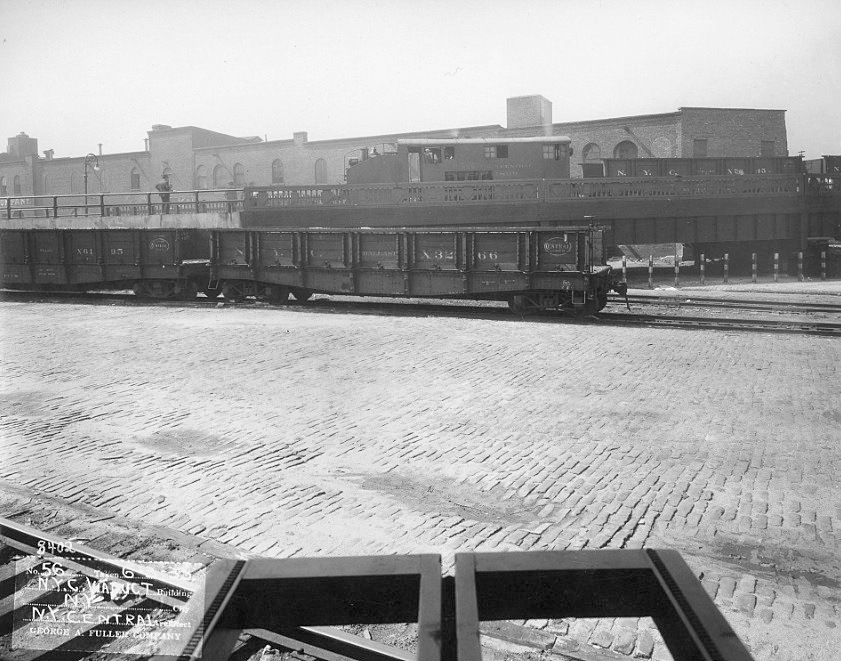 New York Central #1899 - [60 ton - 2 truck, NYC Class B-60]; Manhattan, NY - unknown date (post 1934) Lima Locomotive Works c/n 3238 - built 11/26/1923 Looking south at West 35th Street and Twelfth Avenue Location marker 19 in map below. added 05 April 2024 |
|
| .
. |
|
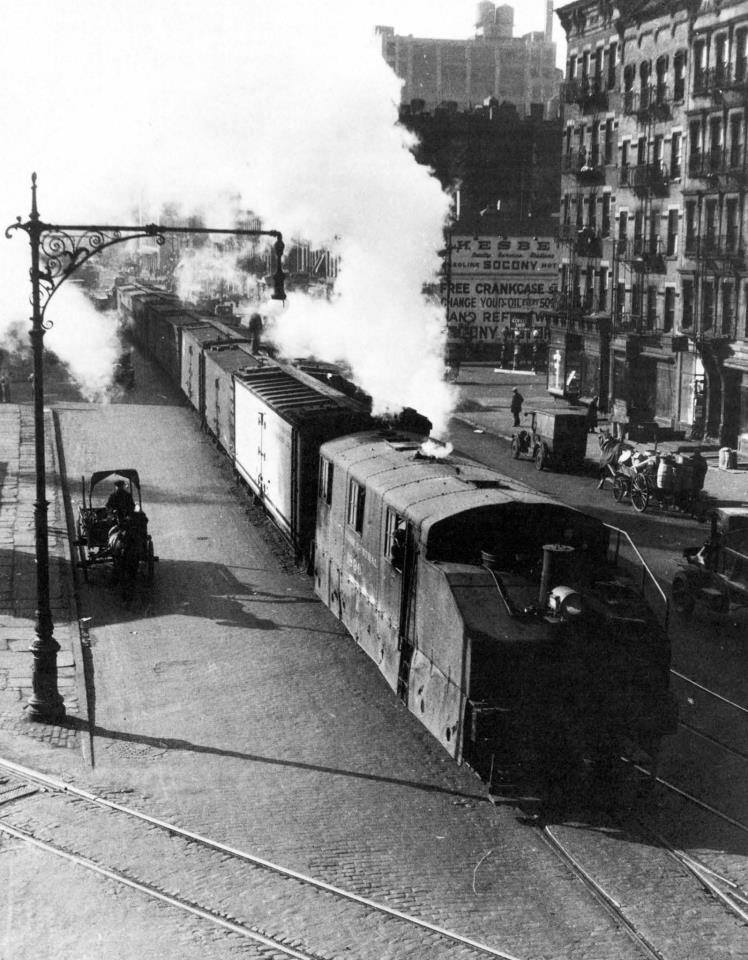 #1896 or #1898 - Tenth Avenue and West 30th Street, Manhattan, NY (taken from pedestrian bridge over yard) collection of New York Central Facebook Group |
|
| .
. |
|
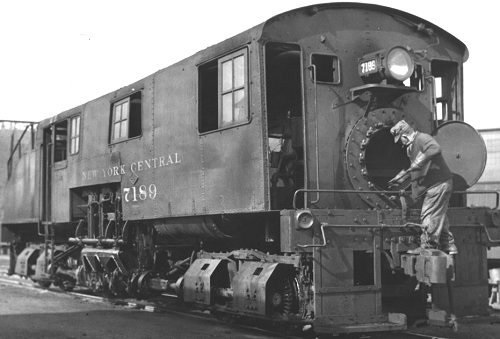 New York Central #7189 (former #1900) - [60 ton - 2 truck, NYC Class B-60] Lima Locomotive Works c/n 3239 - built 11/26/1923 Running gear skirting removed. image courtesy of www.shaylocomotives.com George Kadelak collection added 05 April 2024 |
|
| . . |
|
Q and R Class straight electric locomotives for West Side, Manhattan use 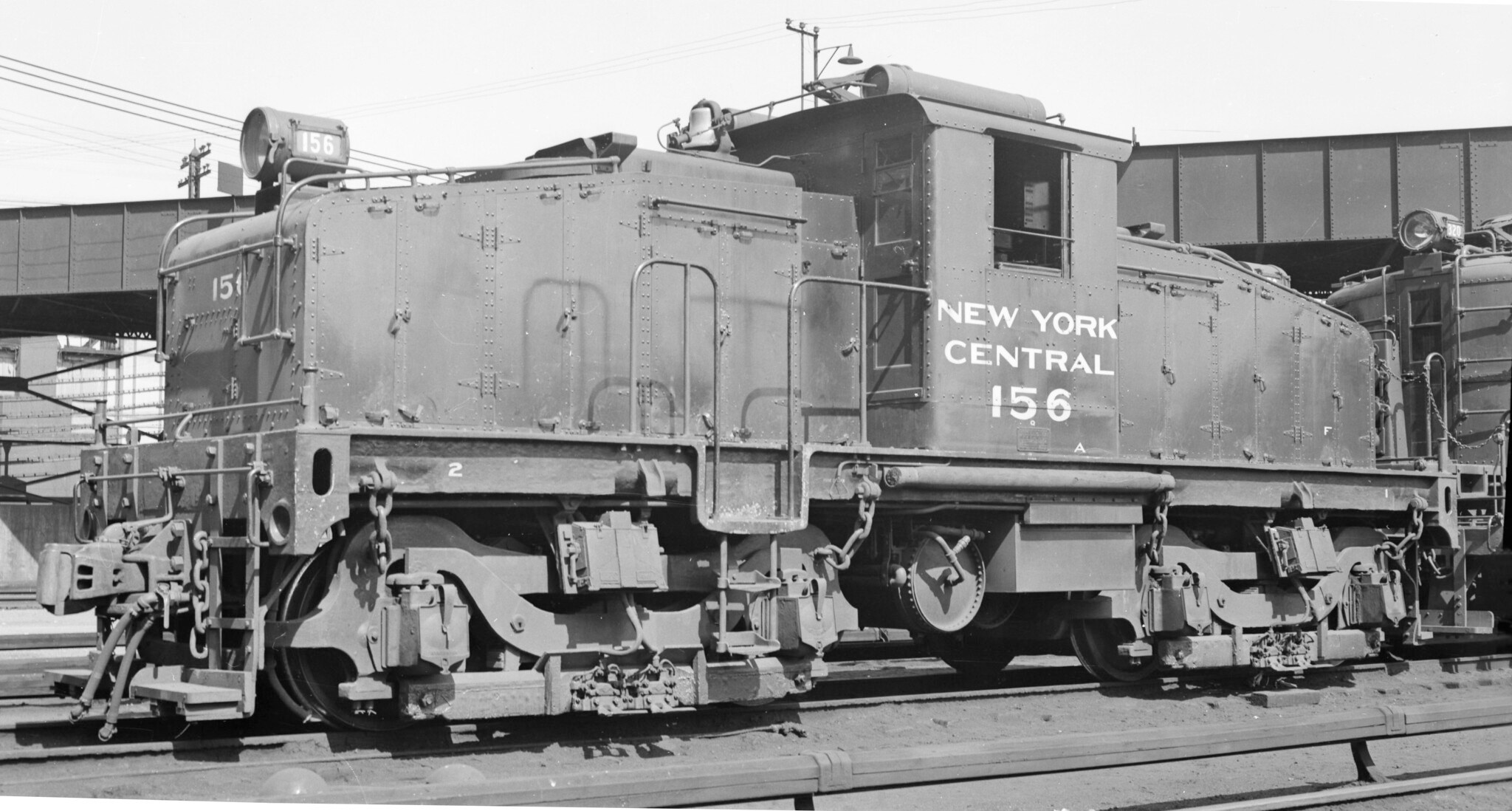 New York Central #156 (former #1256) [Q] - unknown date ALCo / GE electric- ALCo c/n 68359 / GE c/n 11111, built July 1930 Croton Harmon, NY D. Dover photo added 25 August 2025 |
|
| . . |
|
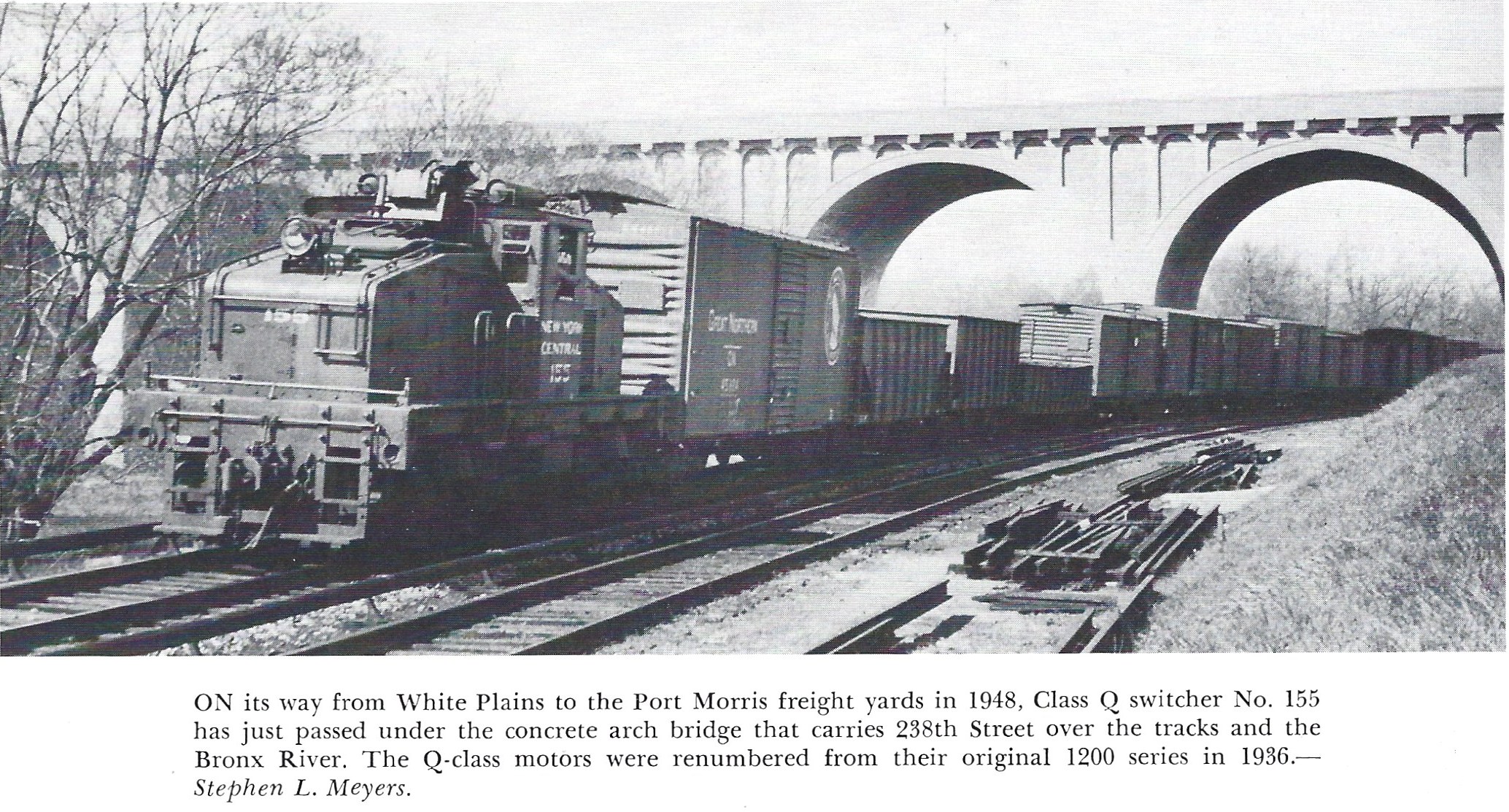 New York Central #155 (former #1255) - unknown date ALCo / GE Electric Q class - ALCo c/n 66420 / GE c/n 9808, built March 1926 East 238th Street / Bronx River (Woodlawn / Wakefield) the Bronx, NY Stephen L. Meyers photo added 25 August 2025 |
|
| . . |
|
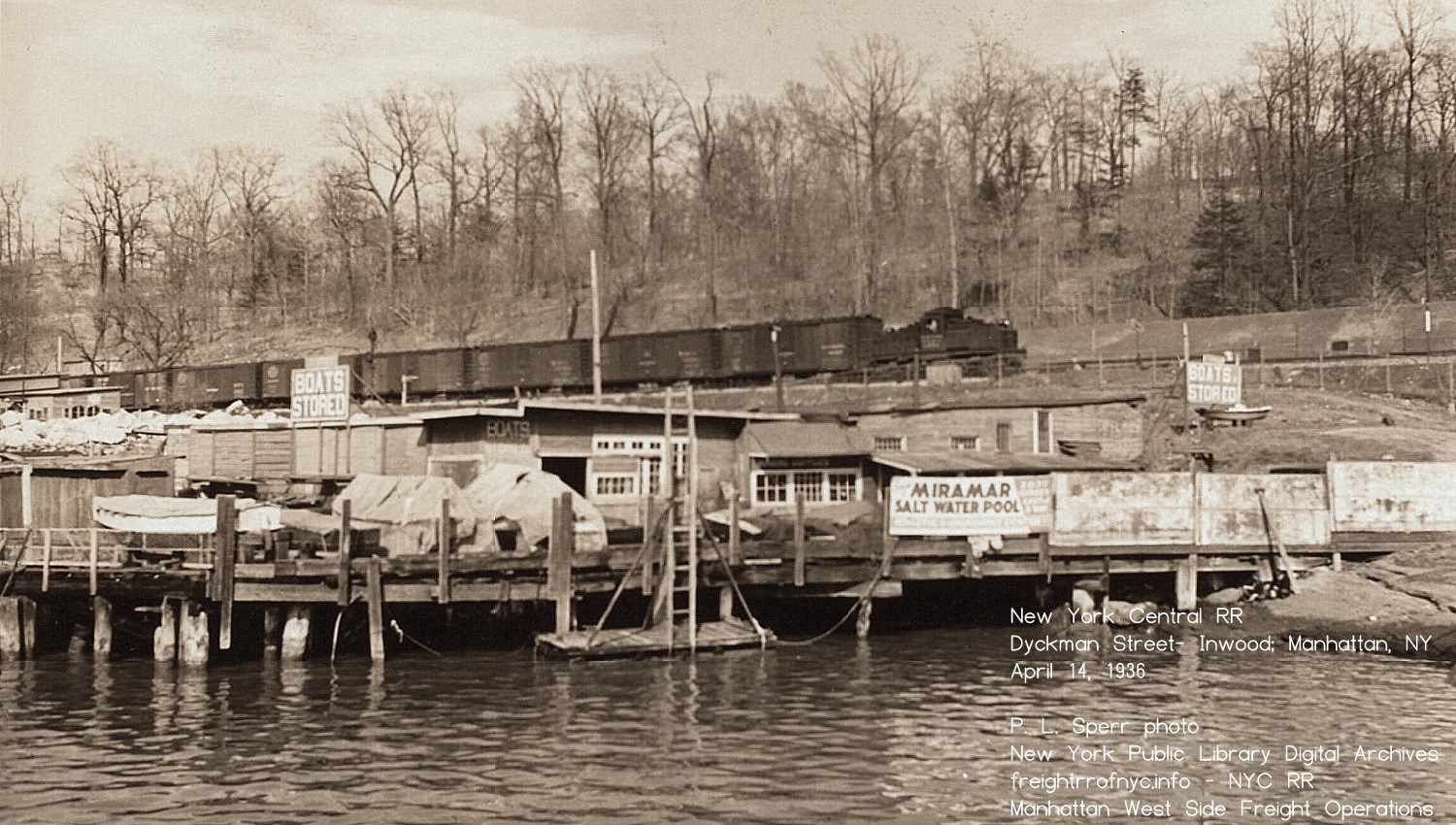 New York Central # - April 14, 1936unknown date ALCo / GE Electric Q class Dyckman Street, Inwood, Manhattan P. L. Sperr photo New York Public Library Digital Archives added 02 September 2025 |
|
| . . |
|
 New York Central #1200 - unknown date ALCo / GE electric R Class Manhattan, NY General Electric photo Edward T. Francis collection added 25 August 2025 |
|
| . . |
|
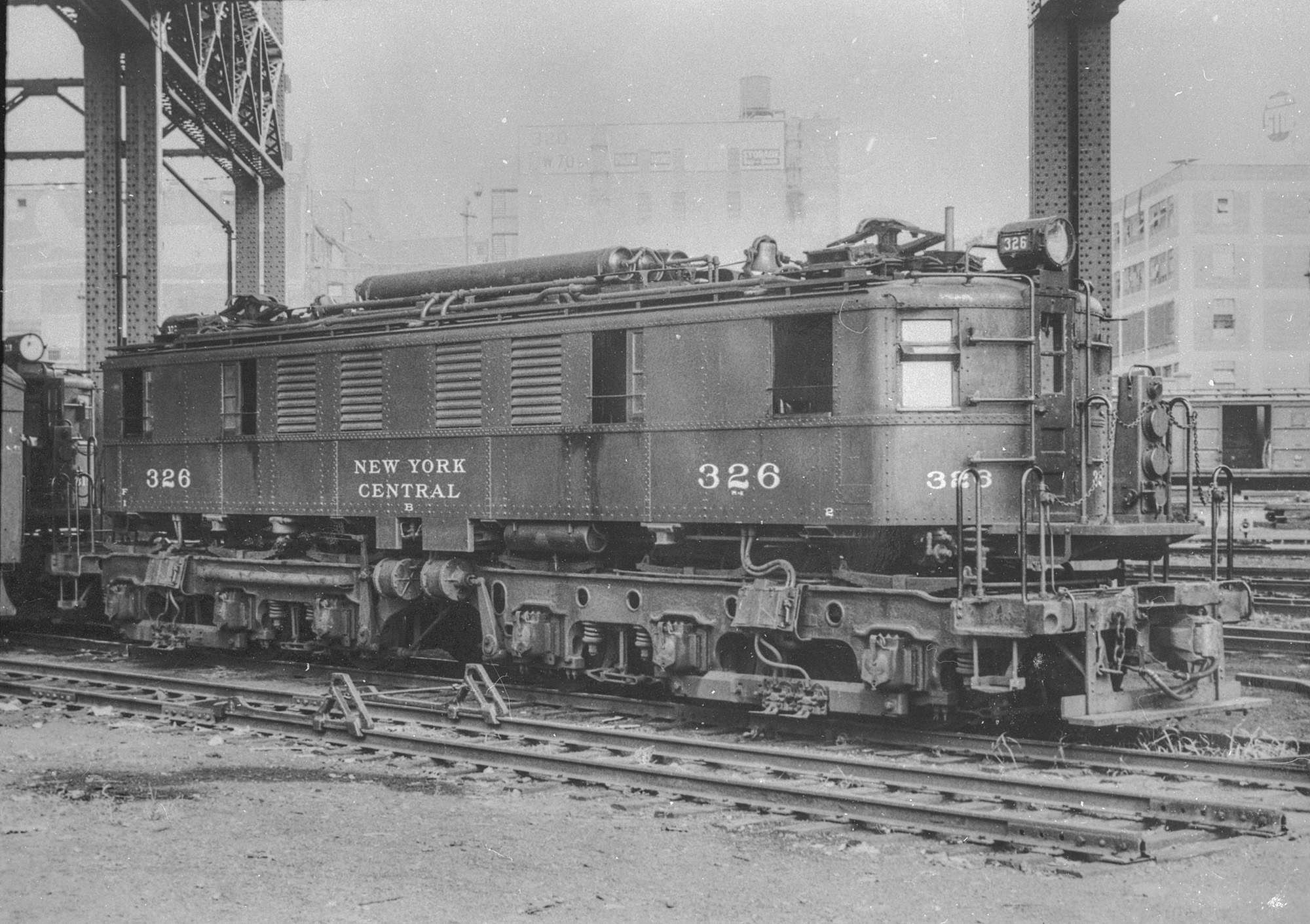 #326 - New York Central #326 - unknown date (post 1936 renumbering) ALCo / GE electric R2 Class under the West Side / Miler Elevated Highway - West 72nd Street, Manhattan, NY unknown photographer Craig Garver collection added 25 August 2025 |
|
| . . |
|
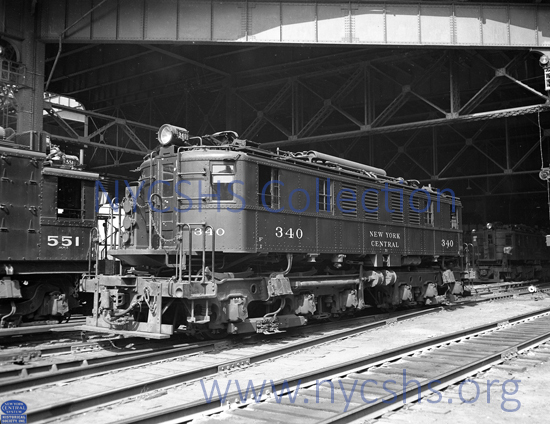 New York Central #340 - September 1941 ALCo / GE electric R2 Class; with Tri-Power #551 to left, and another R2 class in background. under the West Side / Miler Elevated Highway - West 72nd Street, Manhattan, NY New York Central System Historical Society added 25 August 2025 |
|
| . . |
|
|
. American Locomotive Co / General Electric / Ingersoll - Rand "Tri-Power" Locomotive Photos |
|
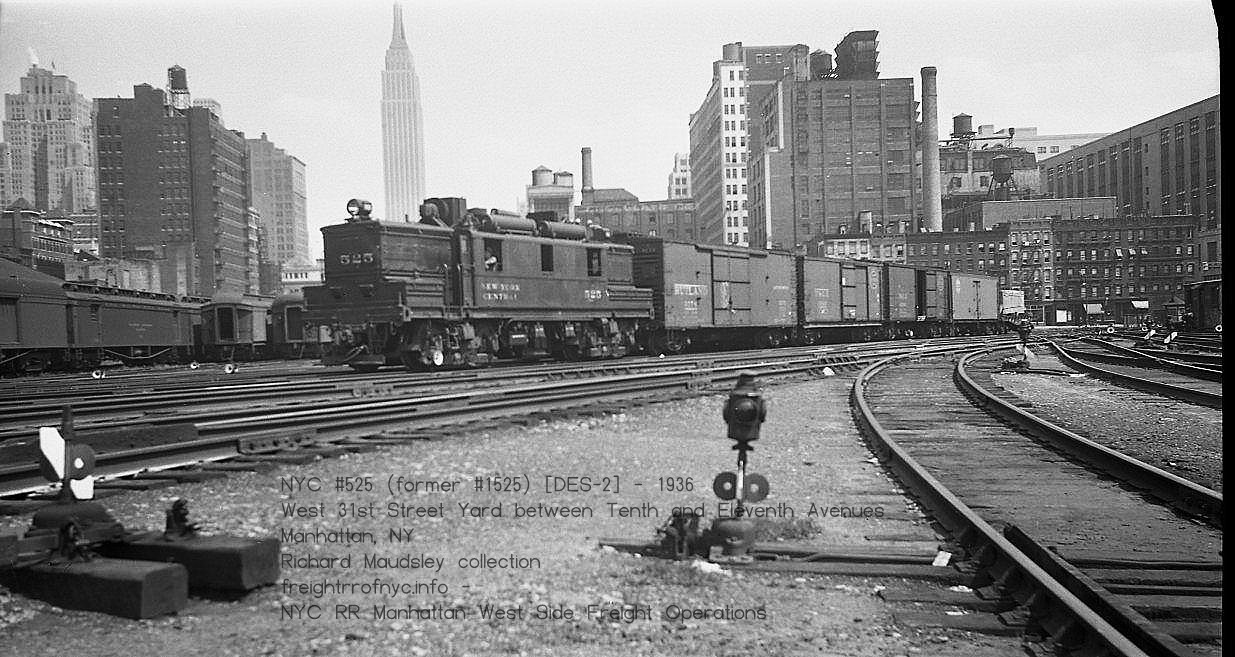 New York Central #525 (former #1525) [DES-2] - 1936 ALCo / GE Tri-Power - ALCo c/n 67101 / GE c/n 10326, built February 1928 Looking east at about West 31st Street between Eleventh and Tenth Avenues Richard Mausley collection added 20 August 2025 |
|
| . . |
|
|
|
|
| . . |
|
New York Central #1528 [DES-3] ALCo / GE Tri-Power - ALCo c/n 68361 / GE c/n 11113, built July 1930 added 05 April 2024 |
|
| . . |
|
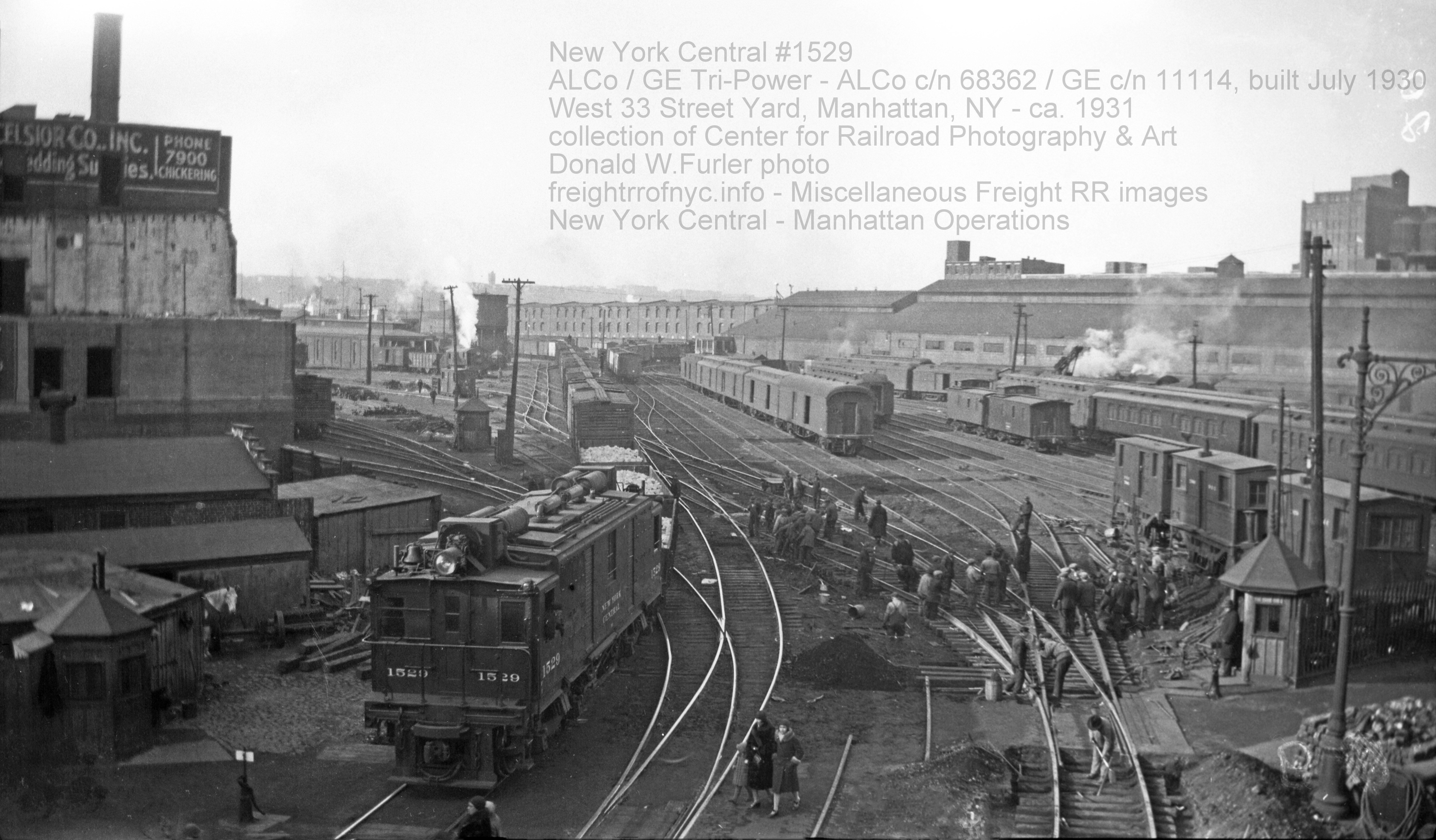 New York Central #1529 [DES-3] - West 33rd Street Yard ALCo / GE Tri-Power - ALCo c/n 68374 / GE c/n 11126, built November 1930. Looking west-northwest from Eleventh Avenue & West 33th Street - ca. 1931 Donald W. Furler photo collection of the Center for Railroad Photography & Art added 05 April 2024 |
|
| . . |
|
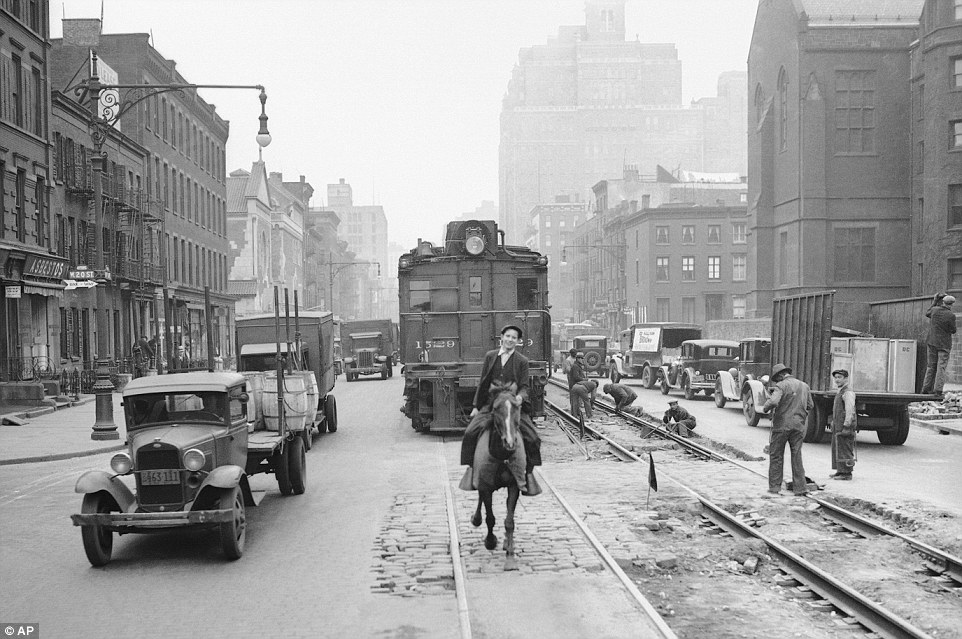 New York Central #1529 [DES-3] - December 18, 1932 ALCo / GE Tri-Power - ALCo c/n 68374 / GE c/n 11126, built November 1930. Looking north along Tenth Avenue at West 20th Street. Escort "West Side Cowboy" is William Connolly. Location marker 18 in map below. Associated Press archives added 05 April 2024 |
|
| .
. |
|
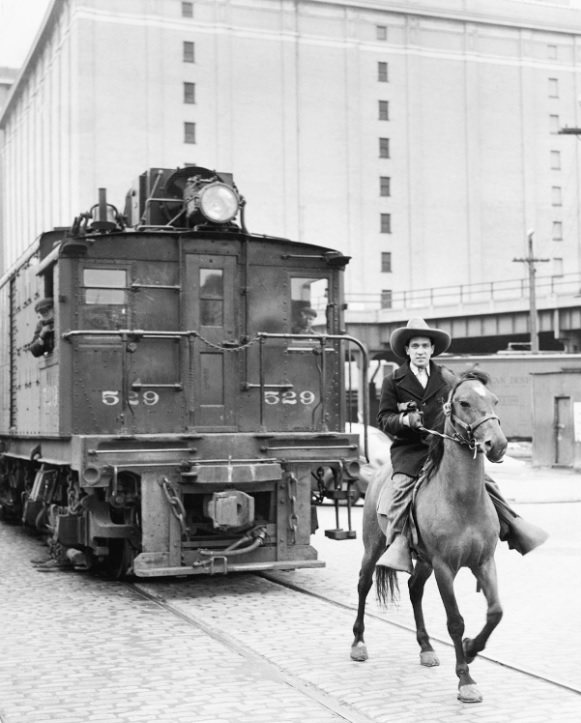 New York Central #529 (former #1529) [DES-3] - 10:50 a.m, March 29, 1941 ALCo / GE Tri-Power - ALCo c/n 68362 / GE c/n 11114, built July 1930 Last ride of the West Side Cowboy: George Hayde and Cyclone ride across West 18th Street Looking south along Tenth Avenue at West 17th Street. Building is 101 Tenth Avenue with High Line trestle right center. Location marker 10 in map below unknown photographer (appears to be New York Central publicity photo - taken same date as photo below) added 05 April 2024 |
|
| .
. |
|
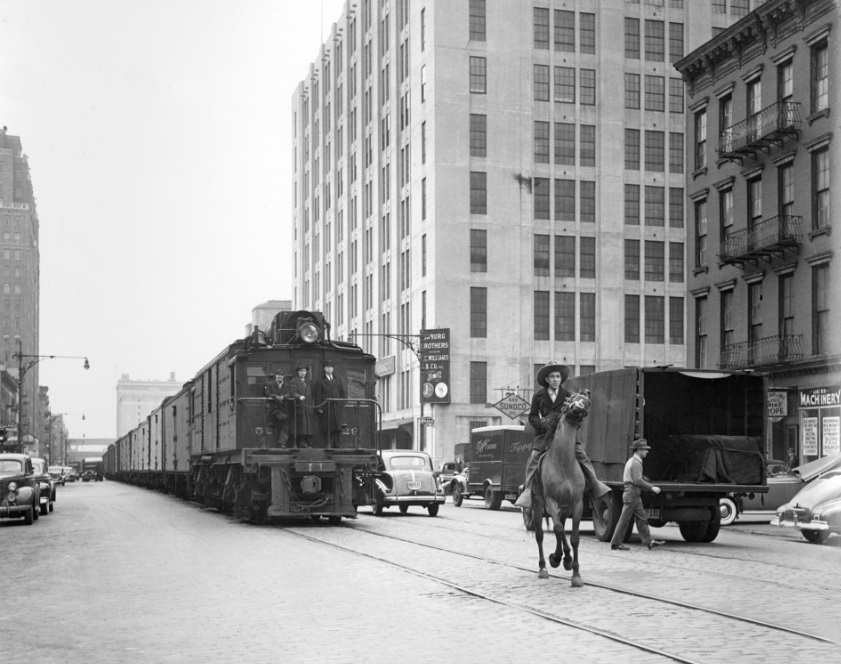 New York Central #529 (former #1529) [DES-3] - March 29, 1941 ALCo / GE Tri-Power - ALCo c/n 68362 / GE c/n 11114, built July 1930 Last ride of the West Side Cowboy: George Hayde and Cyclone escort the locomotive and train of 14 cars of oranges. Looking south along Tenth Avenue at intersection of West 26th Street. The white building is 259 Tenth Avenue - the R. C. Williams (wholesale groceries) warehouse. Location marker 11 in map below unknown photographer (appears to be New York Central publicity photo - taken same date as photo above) added 05 April 2024 |
|
| . . |
|
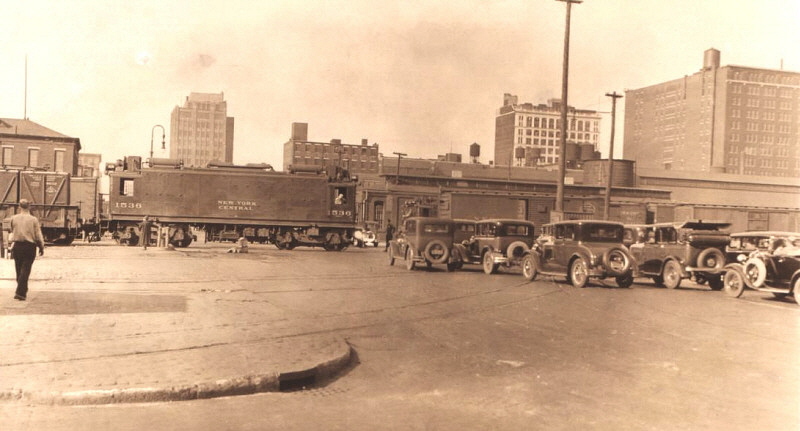 New York Central #1536 [DES-3] - West 30th Street Yard - June 2, 1931 ALCo / GE Tri-Power - ALCo c/n 68369 / GE c/n 11121, built August 1930 Looking northeast along Eleventh Avenue & West 31th Street; Manhattan, NY P. L. Sperr photo NYPL Digital Archives added 05 April 2024 |
|
| . . |
|
New York Central #1541 [DES-3] - Tenth Avenue & West 16th Street - ca. 1945 ALCo / GE Tri-Power - ALCo c/n 68374 / GE c/n 11126, built November 1930 Looking north on spur track into Merchants Refrigerating Cold Storage. Note, no third rail. Location marker 8 in map below. unknown photographer added 05 April 2024 |
|
| .
. |
|
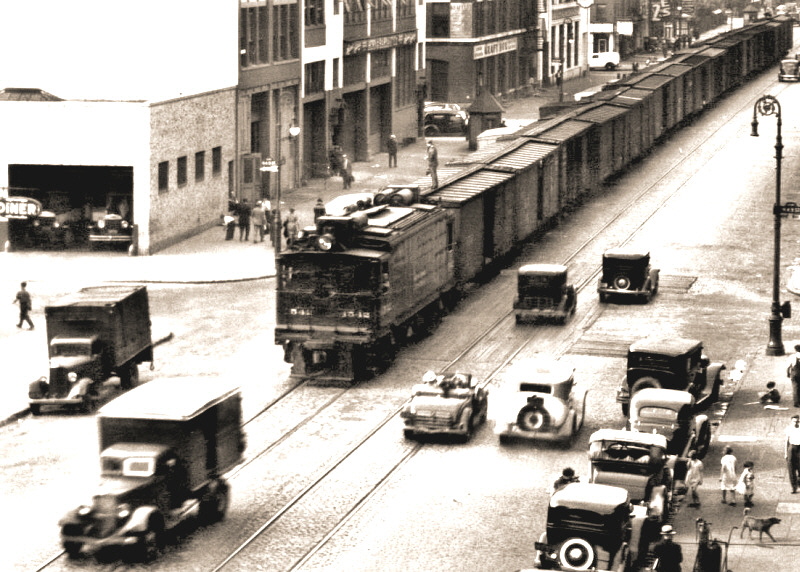 New York Central #1542 [DES-3] - Eleventh Avenue & West 49th Street -1936 ALCo / GE Tri-Power - ALCo c/n 68375 / GE c/n 11127, built November 1930 unknown photographer A. LaBianca collection via S. Berliner added 05 April 2024 |
|
| . . |
|
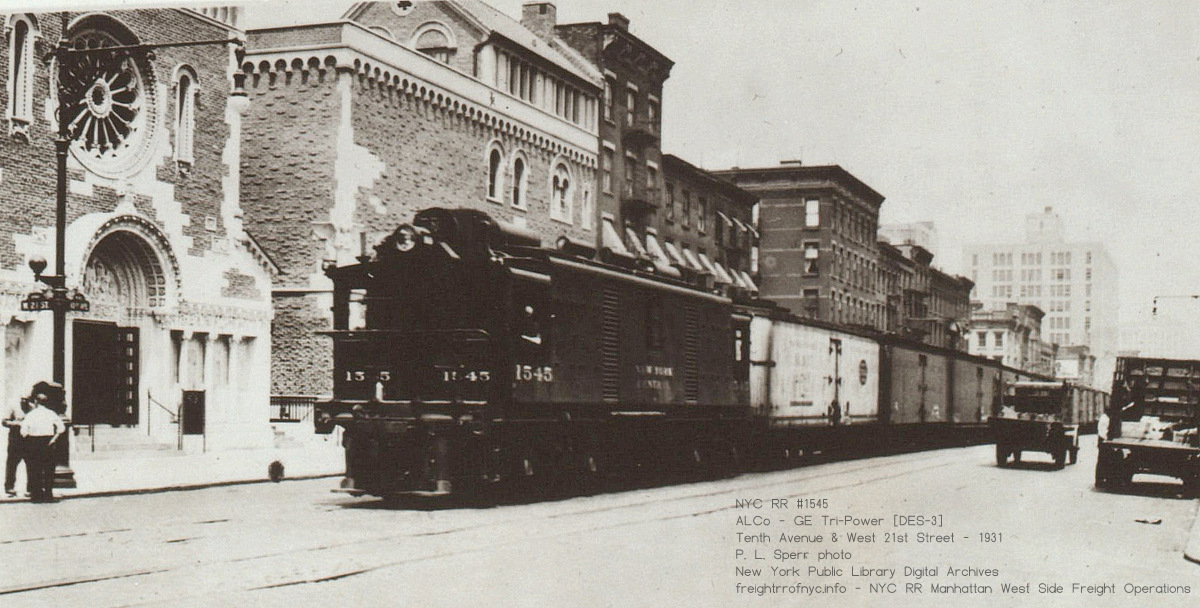 New York Central #1545 [DES-3] - 1931 ALCo / GE Tri-Power - ALCo c/n 68378 / GE c/n 11130, built November 1930 Tenth Avenue & West 21st Street in front of Church of the Guardian Angel P. L. Sperr photo New York Public Library Digital Archives added 20 August 2025 |
|
| . . |
|
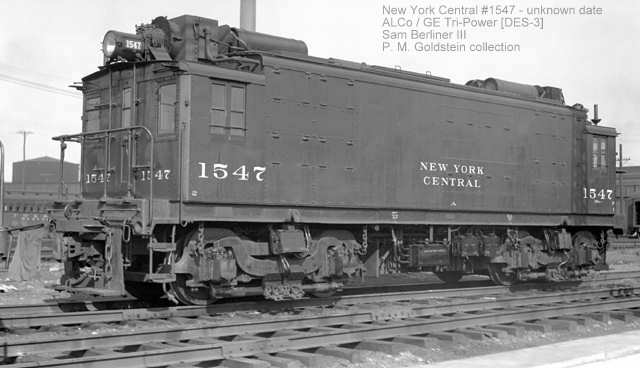 New York Central #1547 [DES-3] - unknown date (pre-1936) ALCo / GE Tri-Power - ALCo c/n 68380 / GE c/n 11132, built November 1930 unknown location digital image: Sam Berliner III archives collection of P. M. Goldstein added 05 April 2024 |
|
| . . |
|
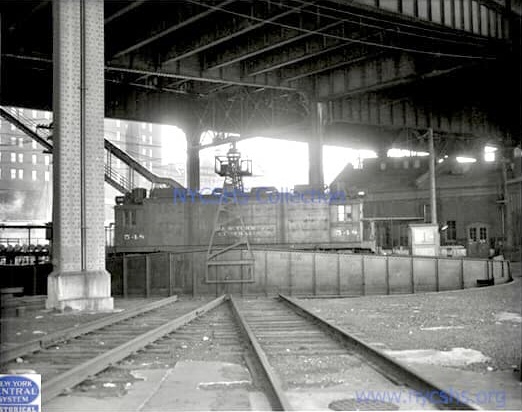 New York Central #548 [DES-3] - unknown date (post 1936) ALCo / GE Tri-Power - ALCo c/n 68381 / GE c/n 11133, built November 1930 West 72nd Street roundhouse; Manhattan (under West Side / Miller Elevated Highway, Manhattan, NY collection of New York Central System Historical Society added 25 August 2024 |
|
| . . |
|
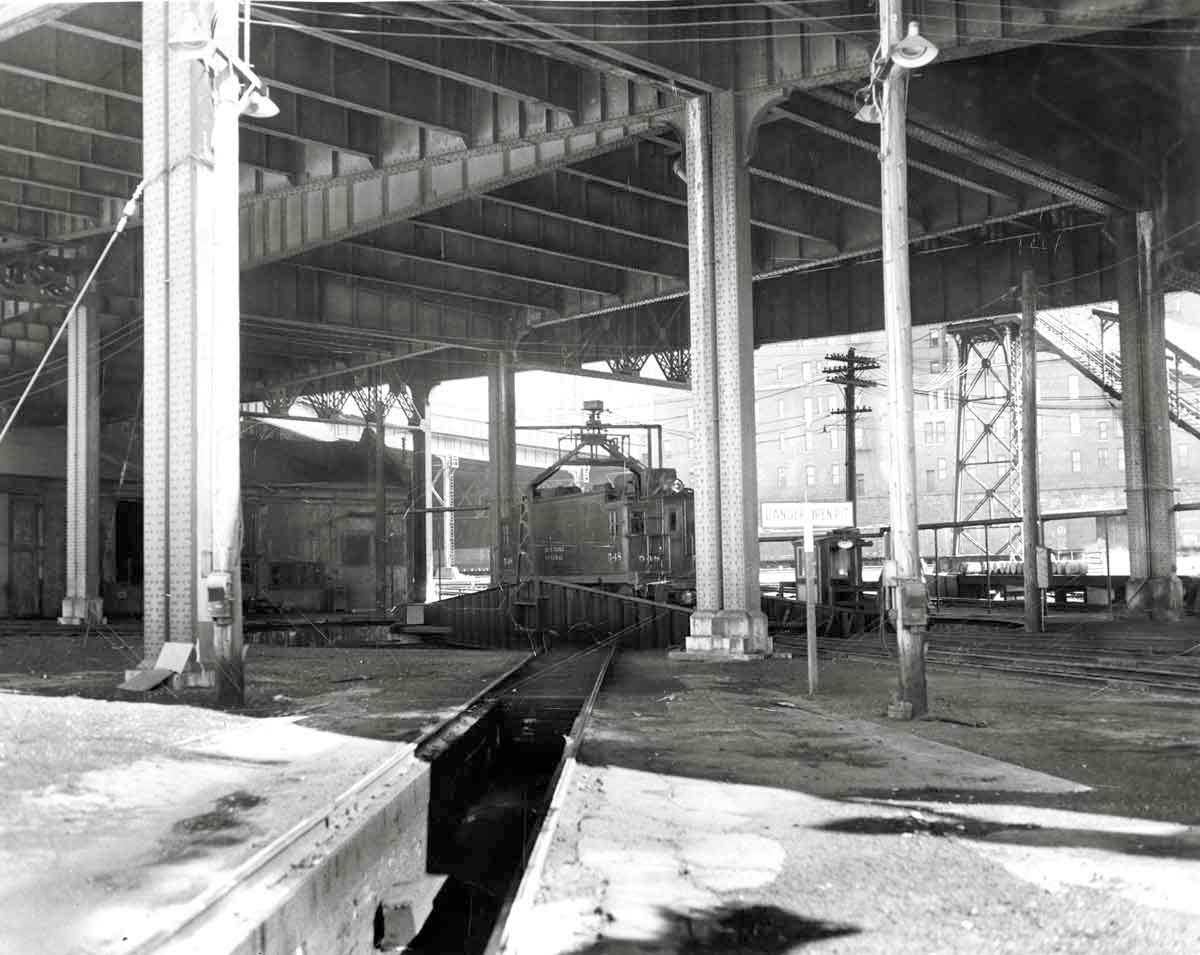 New York Central #548 [DES-3] - unknown date (post 1936) ALCo / GE Tri-Power - ALCo c/n 68381 / GE c/n 11133, built November 1930 West 72nd Street roundhouse; Manhattan (under West Side / Miller Elevated Highway, Manhattan, NY collection of New York Central System Historical Society added 25 August 2024 |
|
| .
. |
|
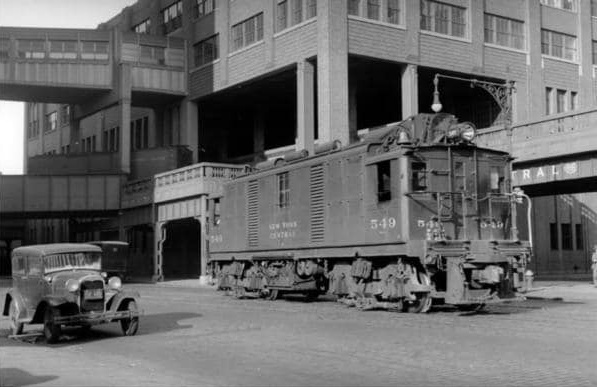 New York Central #549 (former #1549) [DES-3] - unknown date (post 1936) ALCo / GE Tri-Power - ALCo c/n 68382 / GE c/n 11134, built December 1930 looking northeast at intersection of Tenth Avenue and West 15th Street, Nabisco Buildings. Location marker 17 in map below. added 05 April 2024 |
|
| . . |
|
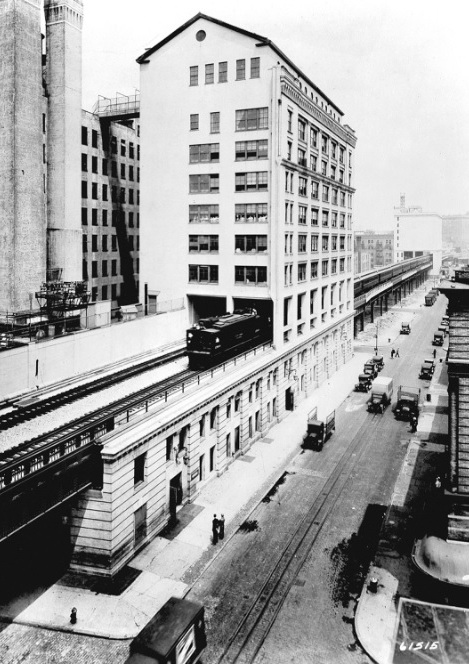 ALCo / GE Tri-Power [DES-3] #554 pulling south on High Line Dedication Excursion train through Bell Laboratories Building - June 29, 1934 ALCo / GE Tri-Power - ALCo c/n 68387 / GE c/n 11139, built November 1930 Looking north along High Line paralleling Washington Street, intersection of Bank Street in foreground, Bethune Street on far side of Bell Building. West 12th Street and Jane street intersections in distance. Location marker 6 in High Line Map below. National Geographic magazine? (seeking hi res version of this photo) added 05 April 2024 |
|
| . . |
|
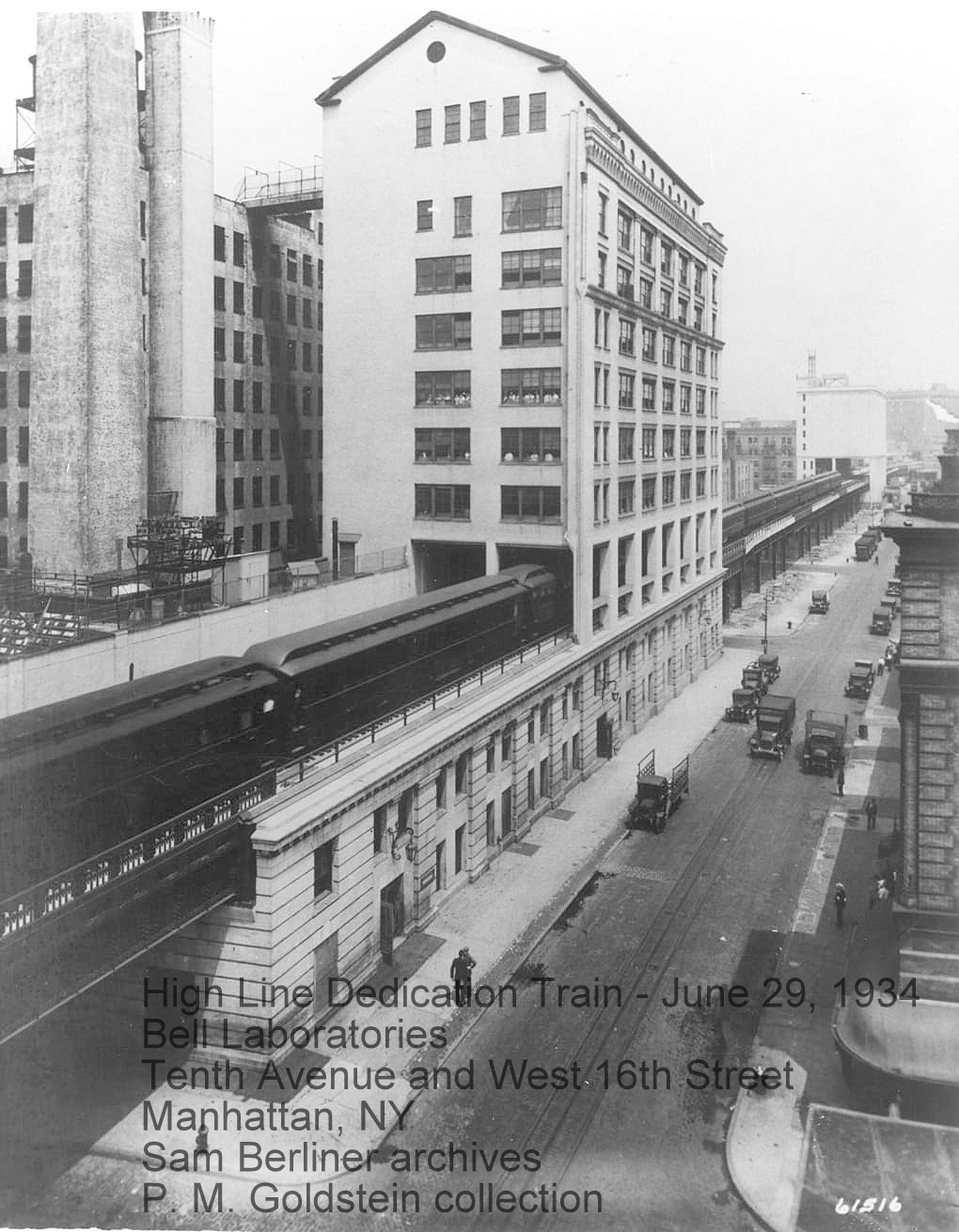 High Line Dedication Excursion train through Bell Laboratories Building - June 29, 1934 Looking north along High Line paralleling Washington Street, intersection of Bank Street in foreground, Bethune Street on far side of Bell Building. West 12th Street and Jane street intersections in distance. Location marker 6 in High Line Map below. digital image: Sam Berliner III archives collection of P. M. Goldstein |
|
| . . |
|
|
|
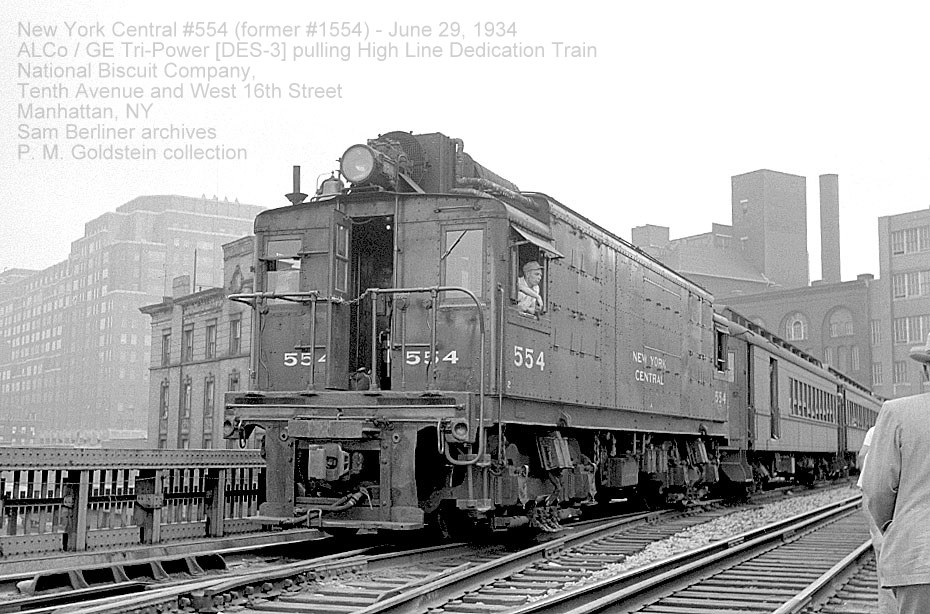 ALCo / GE Tri-Power [DES-3] #554 (former #1554) pulling north the Official Excursion train through Nabisco Buildings - July 30, 1950 ALCo / GE Tri-Power - ALCo c/n 68387 / GE c/n 11139, built November 1930 Looking south on High Line. No third rail on this segment. digital image: Sam Berliner III archives collection of P. M. Goldstein |
|
| .
. |
|
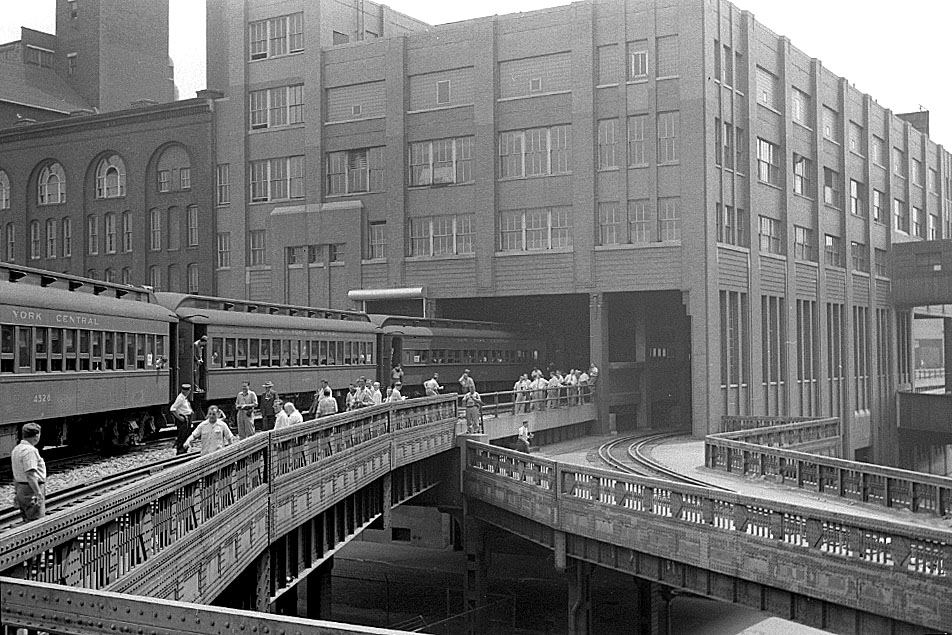 ALCo / GE Tri-Power [DES-3] #554 (former #1554) pulling pulling north the Official Excursion train through Nabisco Buildings - July 30, 1950 ALCo / GE Tri-Power - ALCo c/n 68387 / GE c/n 11139, built November 1930 Notice the photographer on the column with ladder and the other photographer walking across the lower track. No railroad would ever let a railfan do this. Looking south on High Line. No third rail on this segment. digital image: Sam Berliner III archives collection of P. M. Goldstein |
|
| .
. |
|
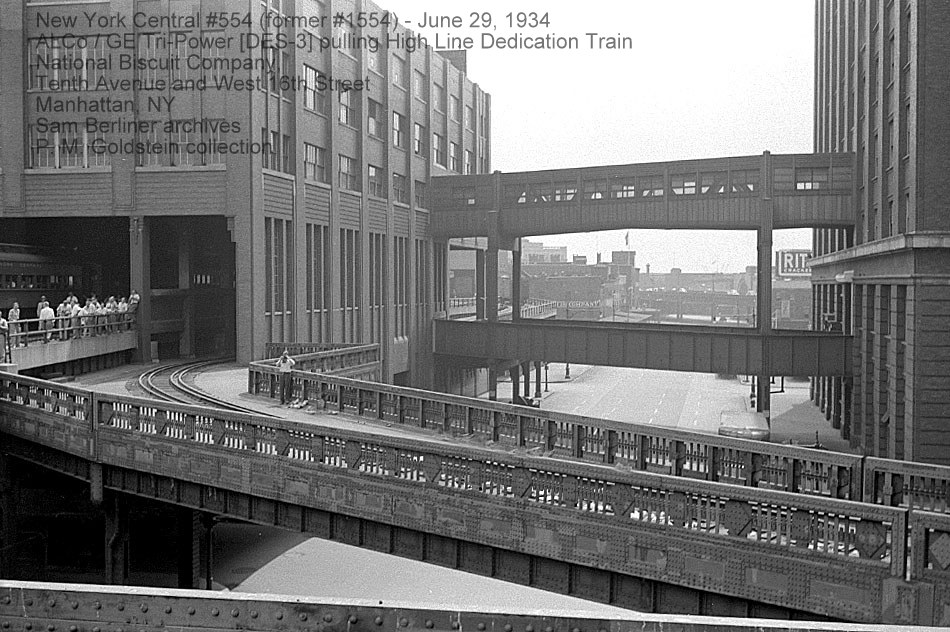 ALCo / GE Tri-Power [DES-3] #554 (former #1554) pulling north the Official Excursion train through Nabisco Buildings - July 30, 1950 ALCo / GE Tri-Power - ALCo c/n 68387 / GE c/n 11139, built November 1930 Looking south down Tenth Avenue, Merchants Refrigerating spur in foreground. No third rail on this segment. digital image: Sam Berliner III archives collection of P. M. Goldstein |
|
| .
. |
|
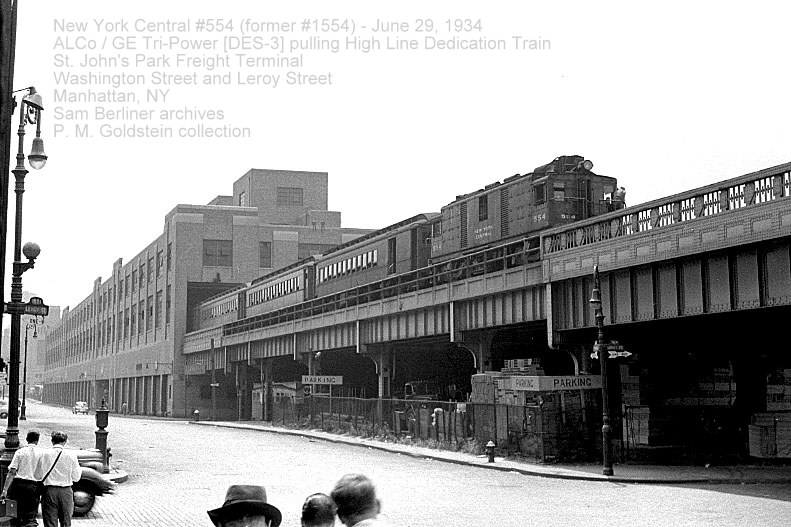 ALCo / GE Tri-Power [DES-3] #554 pulling north the Official Excursion train at St. John's Park Terminal - July 30, 1950 ALCo / GE Tri-Power - ALCo c/n 68387 / GE c/n 11139, built November 1930 Looking south along Washington Street at intersection of Leroy Street. digital image: Sam Berliner III archives collection of P. M. Goldstein |
|
| .
. |
|
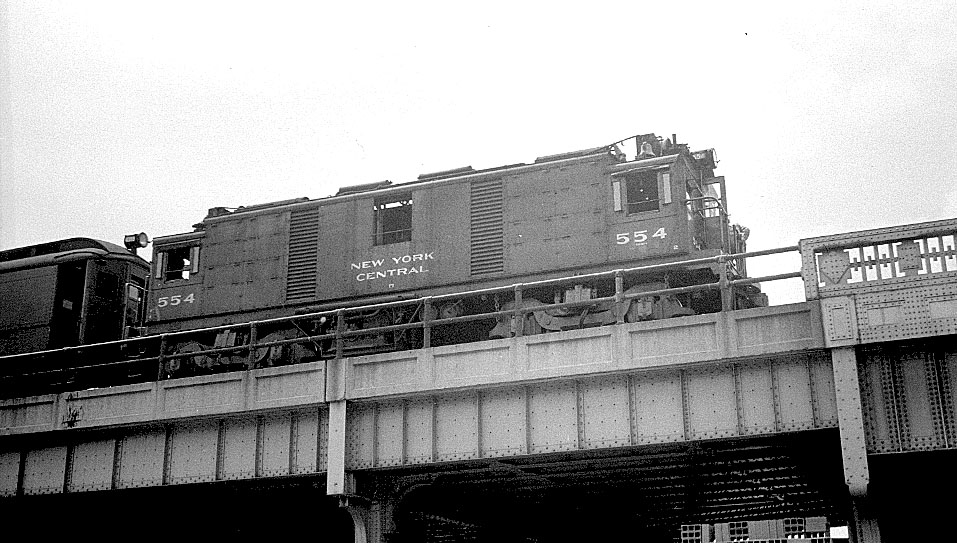 ALCo / GE Tri-Power [DES-3] #554 pulling north the Official Excursion train at St. John's Park Terminal - July 30, 1950 ALCo / GE Tri-Power - ALCo c/n 68387 / GE c/n 11139, built November 1930 Looking west from Washington Street at intersection of Leroy Street (to right). digital image: Sam Berliner III archives collection of P. M. Goldstein |
|
| .
. |
|
 ALCo / GE Tri-Power [DES-3]
#558 in front of old St. John's Park
Terminal - unknown date
ALCo / GE Tri-Power - ALCo c/n 68391 / GE c/n 11143, built December 1930 Looking south on Hudson Street. Note single point tongue & mate switch. unknown provenance |
|
| .
. |
|
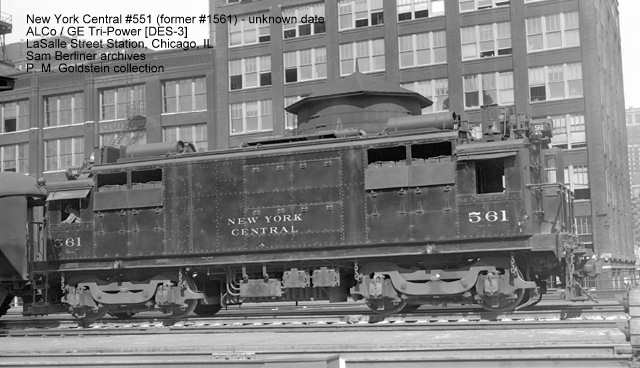 Not Manhattan - LaSalle Street Station, Chicago, Illinois! ALCo / GE Tri-Power [DES-3] #561 - unknown date The building is 619 South LaSalle Street. The only way I was able to figured it out, was the locomotive had a notation of "LaSalle Sta" in the builders records! digital image: Sam Berliner III archives collection of P. M. Goldstein |
|
| .
. |
|
|
. Conventional Diesel - Electric |
|
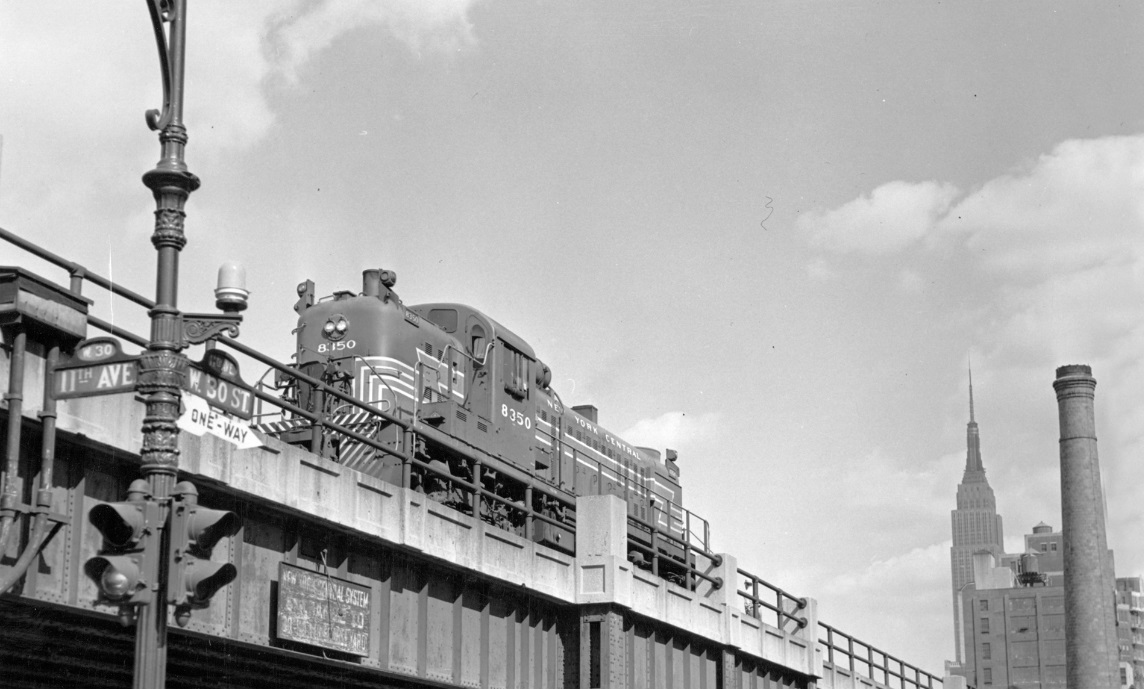 New York Central #8350 [DRS-6] - Eleventh Avenue & West 30th Street; Manhattan, NY - April 1957 ALCo RS3 c/n 80541, 1600 hp, built October 1953 Looking east on West 30th Street. J. Shaughnessy photo added 05 April 2024 |
|
| .
. |
|
 New York Central #8350 [DRS-6] - Eleventh Avenue & West 30th Street; Manhattan, NY - April 1957 ALCo RS3 c/n 80541, 1600 hp, built October 1953 Note the third rails to the inside of the running tracks, and the notched pilot corners of the RS3 for clearance of the third rail. This modification would be required for all diesel-electric locomotives that were assigned to operate in third rail territory, south of Croton-Harmon. Looking east on West 30th Street. J. Shaughnessy photo added 05 April 2024 |
|
| .
. |
|
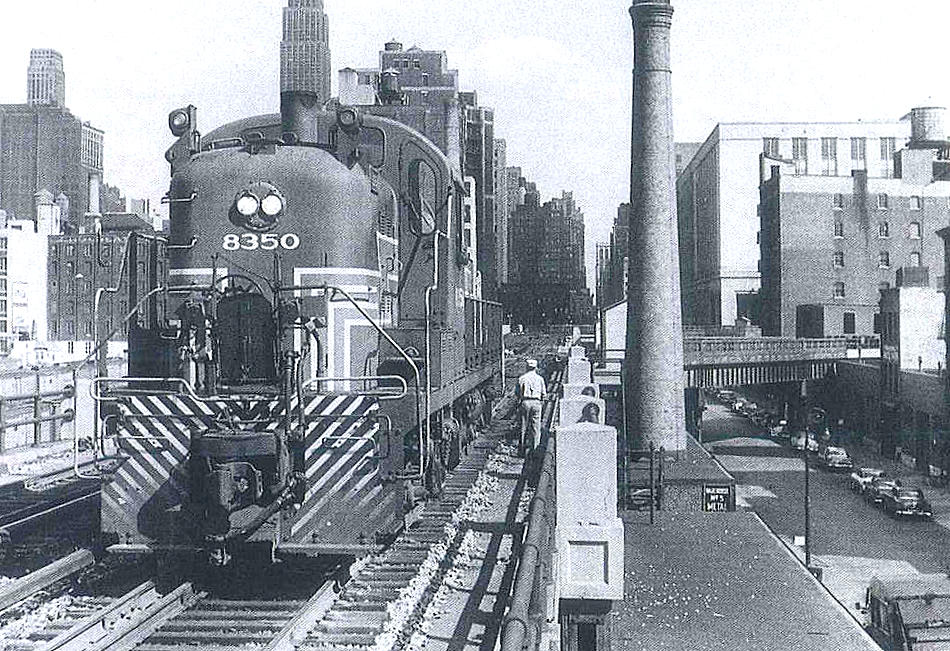 New York Central #8350 [DRS-6] - Eleventh Avenue & West 30th Street; Manhattan, NY - April 1957 ALCo RS3 c/n 80541, 1600 hp, built October 1953 Looking east on West 30th Street. First turn is High Line heading south, second one in background leads to US Postal Facility (white building). J. Shaughnessy photo added 05 April 2024 |
|
| .
. |
|
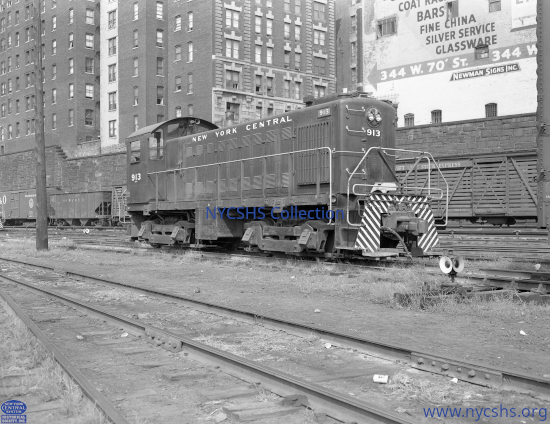 NYC #913 [ALCo S3] - West 68nd Street (West 60th - 72nd Street Yard) - August 3, 1955 ALCo S3 c/n 79352, 1000 hp, built November 1951 Looking northeast. Note notched pilot corners for clearance of the third rail. New York Central System Historical Society added 05 April 2024 |
|
| .
. |
|
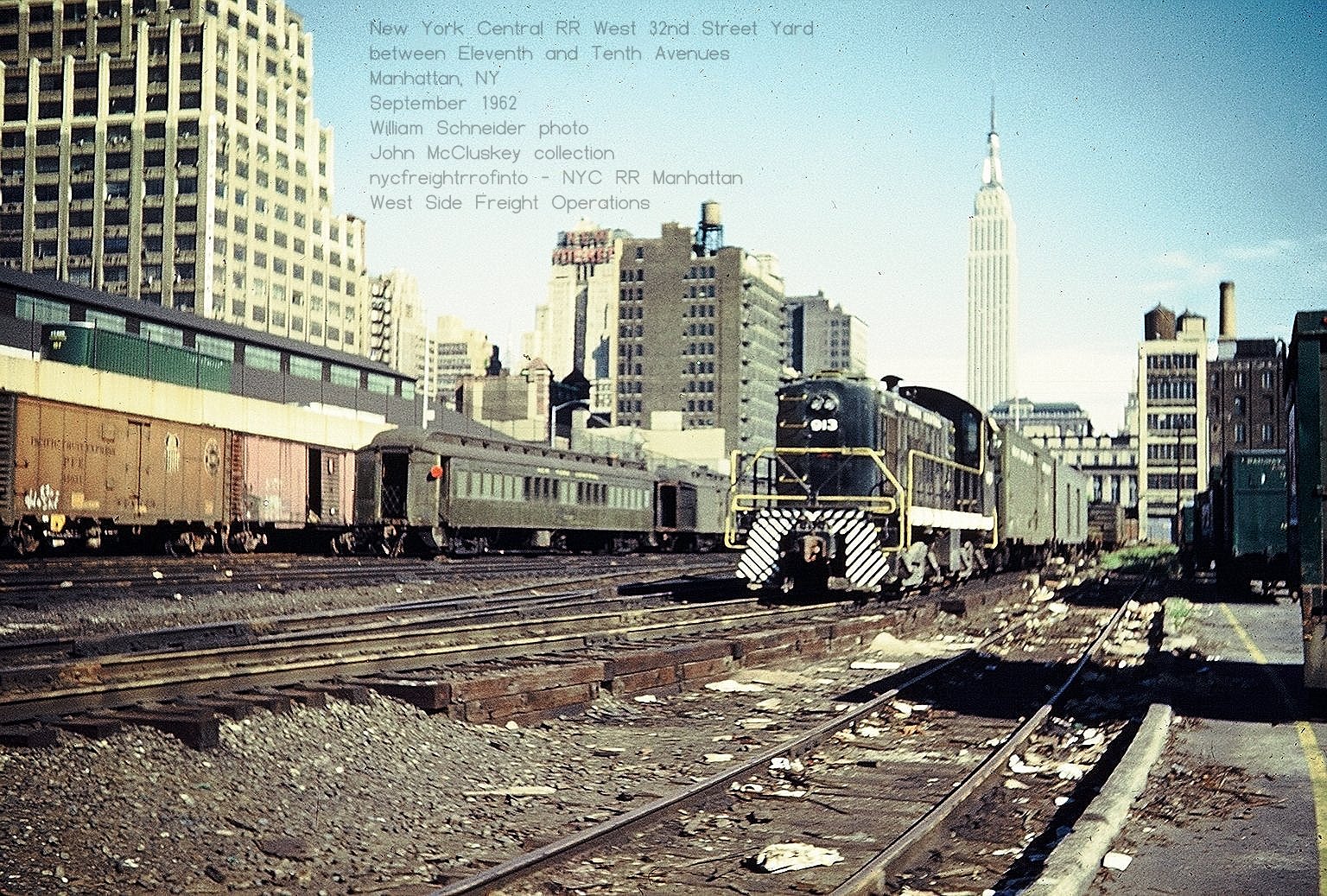 NYC #913 [ALCo S3] - West 32nd Street between Eleventh and Tenth Avenues - September 1962 ALCo S3 c/n 79352, 1000 hp, built November 1951 Looking northeast. Note notched pilot corners for clearance of the third rail. W. Schneider photo collection of John McCluskey added 05 April 2024 |
|
| .
. |
|
NYC #913 [ALCo S3] - West 32nd Street between Eleventh and Tenth Avenues - September 1962 ALCo S3 c/n 79352, 1000 hp, built November 1951 Looking northeast. Note notched pilot corners for clearance of the third rail. W. Schneider photo collection of John McCluskey added 05 April 2024 |
|
| .
. |
|
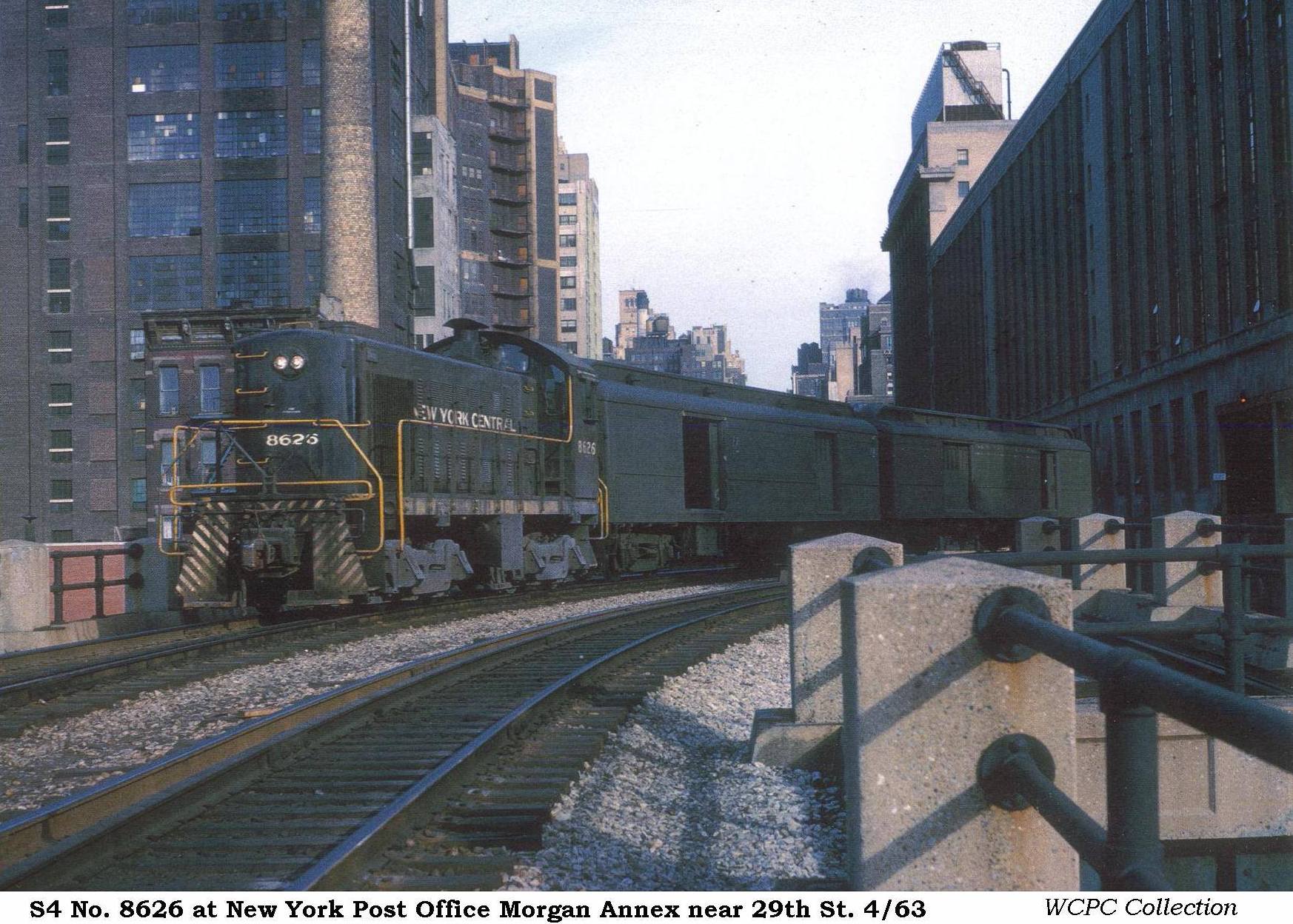 New York Central #8626 [ALCo S4] - Tenth Avenue & West 30th Street; Manhattan, NY - April 1963 ALCo c/n 79782, 1000 hp, built April 1952 Looking east on West 30th Street. Note notched pilot corners for clearance of the third rail. WCPC collection added 05 April 2024 |
|
| .
. |
|
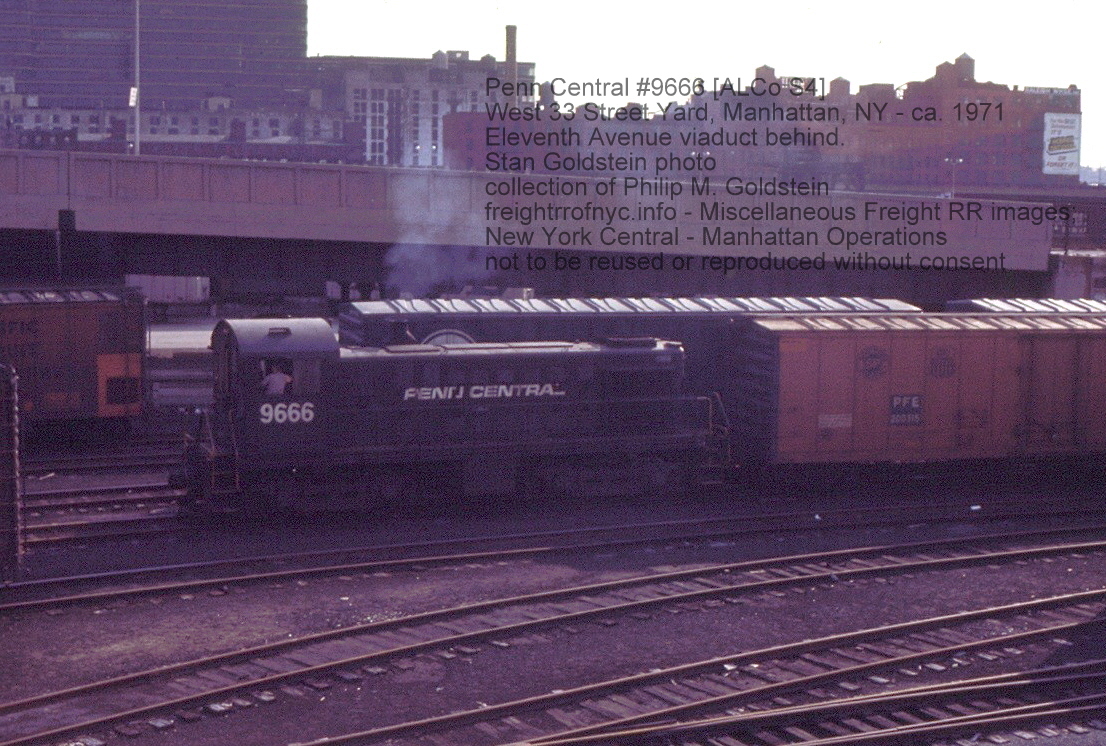 Penn Central #9666 - West 33 Street Yard; Manhattan, NY - ca. 1971 ALCo S4 (ex-NYC 8500/8600 series) Taken from the West 34th Street ramp with West 33rd Street ramp in background. Looking southwest. Stan Goldstein photo collection of Philip M. Goldstein added 05 April 2024 |
|
| .
. |
|
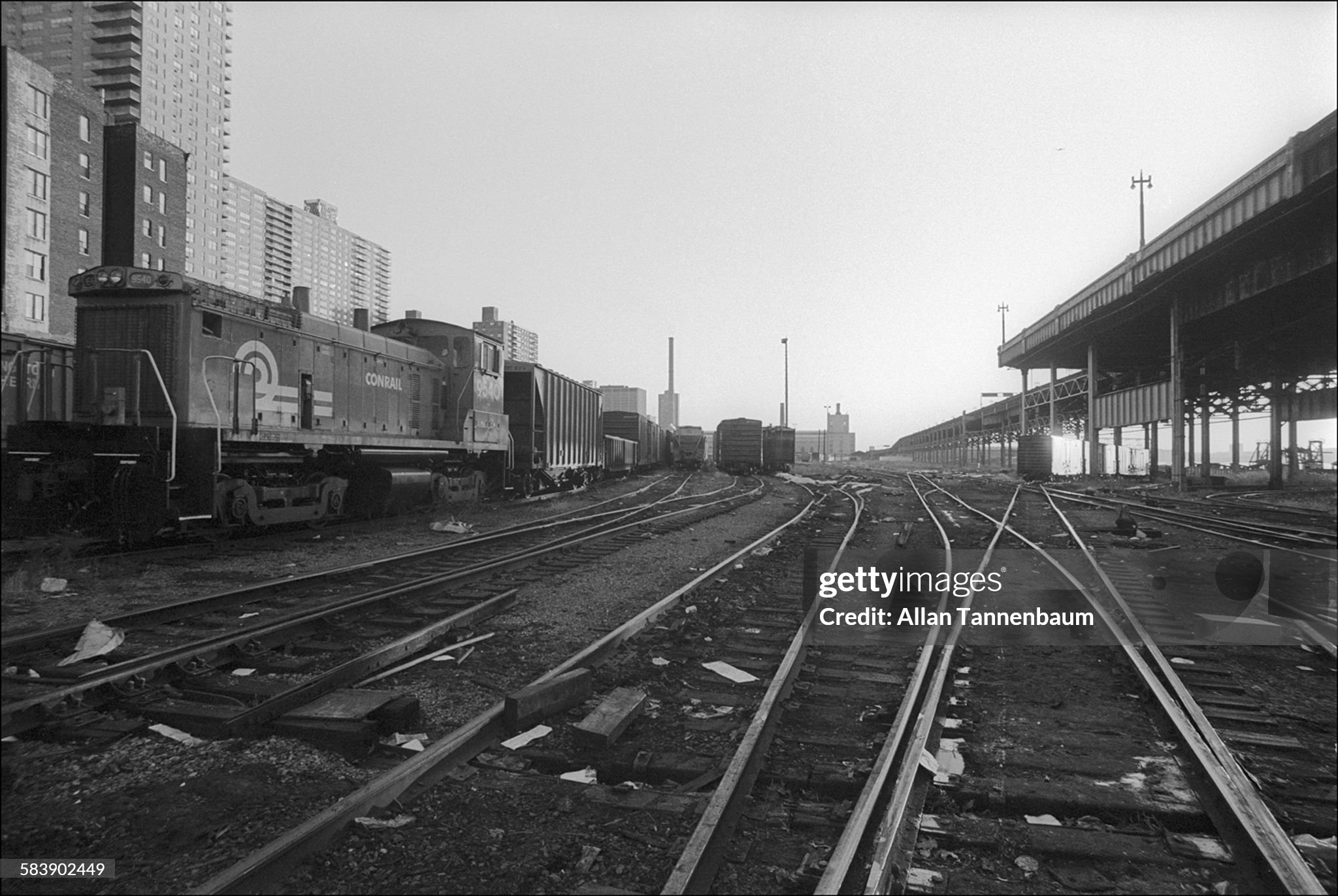 Conrail #9540, West 72nd Street, Manhattan, NY - ca. 1979 EMD SW1500 (ex-Penn Central #9540 c/n 7355-31 - built 3/1972) - January 31, 1981 West 60th Street Yard, looking south from West 72nd Street, Manhattan, NY Difficult to discern, but note notched pilot corners for clearance of the third rail. Allan Tannenbaum image Getty images archives added 05 April 2024 |
| Port of New York Terminal Facilities | Gratz Mordechai | 1885 |
| Documents of the Assembly of the State of New York | 1917 | |
| Report of the Commission to Investigate the Surface Railroad Situation in the City of New York | New York, New Jersey Port and Harbor Development Commission | 1918 |
| Joint Report with Comprehensive Plan | 1920 | |
| Water Terminal and Transfer Facilities for the First District of New York | US Government Printing Office | 1920 |
| Port and Terminal Facilities, Port of New York; Volumes 1, 2 and 3 | War Department, Army Corp of Engineers | 1932, 1942, 1953 |
| West Side Improvement | New York Central RR | 1934 |
| New York Central Early Power | Alvin Staufer | 1967 |
| When the Steam Railroads Electrified | William D. Middleton | 1974 |
| Memories of New York Central Steam | Arnold Haas | 1980 |
| The Port of New York, Volume 1 and 2 | Carl W. Condit | 1981 |
| Dawn of the Diesel Age | John F. Kirkland | 1983 |
| Historic American Engineering Report NY-557A | Thomas R. Flagg & Gerald Weinstein | 2006 |
| Canada Southern website |
Like what you see? Suggestions?
Comments?
Click here to sign the: